

Visiting Angkor Wat? Here’s everything you need to know
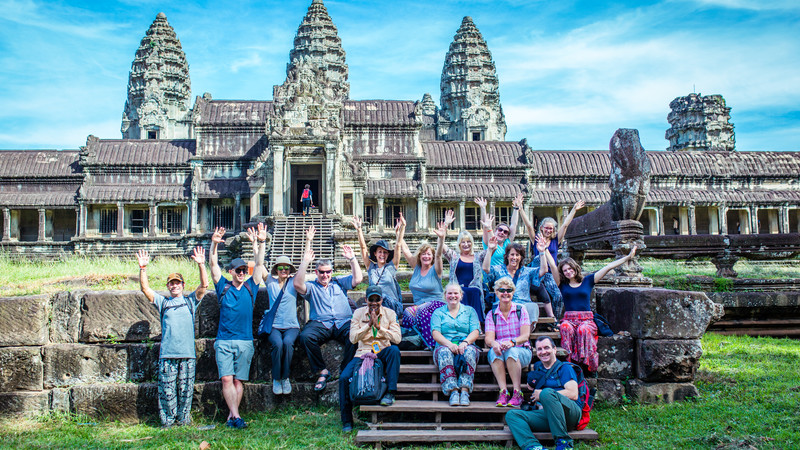
There are few experiences in all my travels that I recall with greater clarity or fondness than the magical time I spent exploring the Angkor Archaeological Park.
I remember waking up in the earliest part of the morning when there was still a thick layer of fog. I remember getting into a tuk-tuk with my partner, Briana, and arriving just as the sun was keen to peak out its knowing head. I remember being entranced by the famed spiraled towers of Angkor Wat, and I stood there, completely in awe, with nothing to do but soak in the sun’s rays and the temple’s majesty.
Visiting Cambodia ‘s Angkor Wat is like being granted the keys to another world for a short period of time. While I was there, I often imagined in my head that, like a certain CS Lewis novel, I must have walked through a closet and into another realm.
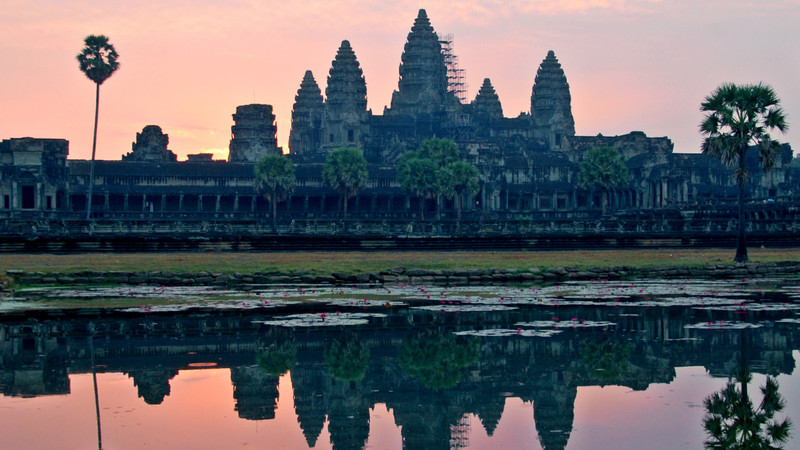
What is Angkor Wat anyhow?
Angkor Wat is the prized temple and showpiece of what is now known as the Angkor Archaeological Park. The city of Angkor itself was built in the 12th century to be an unparalleled Khmer capital for King Suryavarman II. When built, the ancient city extended over 400 kilometres, which makes it the largest pre-industrial city in history. While guesses about the city’s population vary wildly, some prominent historians suggest that the population could have been as high as one million people. Mysteriously, archaeologists are still unsure of what actually happened to this vast empire and its people.
What I didn’t know when I visited, but learned after through further reading, is that the Angkor Archaeological Park shouldn’t really be conceptualized as a collection of disparate temples and monuments in a jungle. This was a fully functioning, complex city that was well-connected, and these temples were just a part of that burgeoning city.
When is the best time to visit Angkor Wat?
Generally speaking, November to February is going to be your best window for a visit. I had the pleasure of getting some input from Channa, an incredible intrepid leader with a remarkable story , and she wholly concurs because, “it is not too hot, and there’s no rain.” Now, it’s worth noting that because you’ve got this window without the aggressive humidity and rainfall, you’re going to have more tourists, so it’s going to be quite a bit busier.
As far as timing for visiting, the Angkor Archaeological Park is open most days from 5am until 6pm. I would very strongly recommend getting there for sunrise. Most people who are visiting Angkor Wat will be staying in Siem Reap, and that means if you want to do this right, you’re in for an early morning. The tuk-tuk ride takes approximately 30 minutes, so factor that into your plans.
KNOW BEFORE YOU GO: HOW TO PHOTOGRAPH THE TEMPLES OF ANGKOR
Once the park opens, you’re going to want to head straight to Angkor Wat to get the famous sunrise picture. The full breadth of the sunrise usually occurs between 5:30-6:00, so have your camera ready. And prepare for crowds.
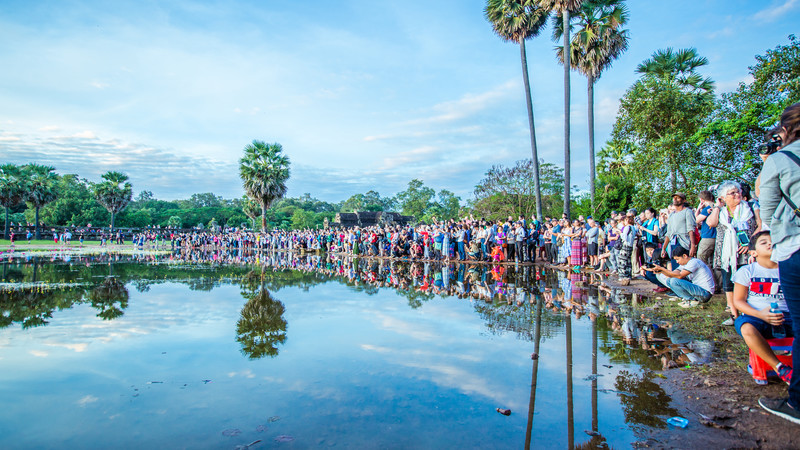
Prepare for crowds!
You might be tired, but I always joke to my fiancée (who in all likelihood is getting tired of my jokes) that it’s always worth it to get up extra early or stay up extra late because fatigue is temporary, but a picture lasts forever.
Trust me, Angkor Wat at sunrise is something to behold, do yourself a favour and get up to appreciate it.
VISIT ANGKOR WAT ON A SMALL GROUP ADVENTURE WITH INTREPID
What should I wear to Angkor Wat?
It’s important to note that at Angkor Wat, there is a dress code that must be abided by. You’ll need to wear clothing (preferably light) that covers your shoulders and knees. The sun is likely to be quite strong, so it makes sense to bring a hat, and you should be wearing good-quality walking shoes. Lastly, you might want to carry around or pack a thin raincoat as weather can be a touch erratic.
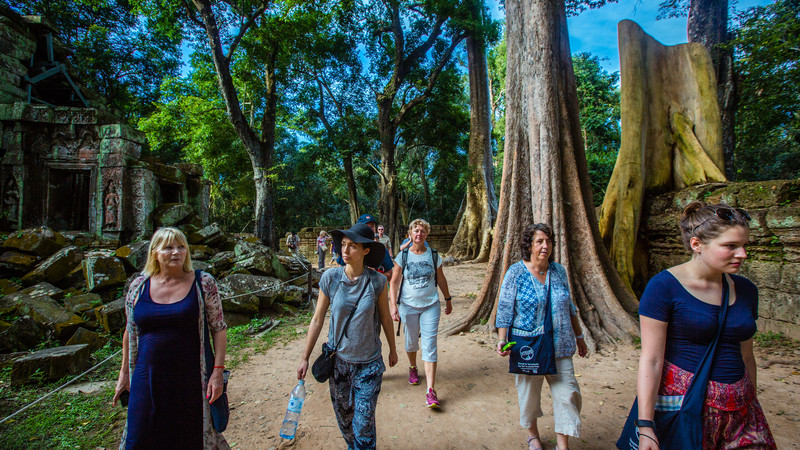
What do you need to see if you’re short on time?
If you haven’t got much time, you’re going to want to make the most of every moment. The good news is that you can cover a lot of ground in just a little bit of time if you’ve planned with purpose. There are some places that you simply need to see if you’re visiting the Angkor Archaeological Complex, and they are, in my humble opinion, the following:
Firstly, the Angkor Wat temple itself. I’d recommend taking in the views of Angkor Wat at sunrise, then going directly after to explore the famed temple. Angkor Wat is the pièce de résistance of the complex, and the postcard picture you’ve seen a million times.
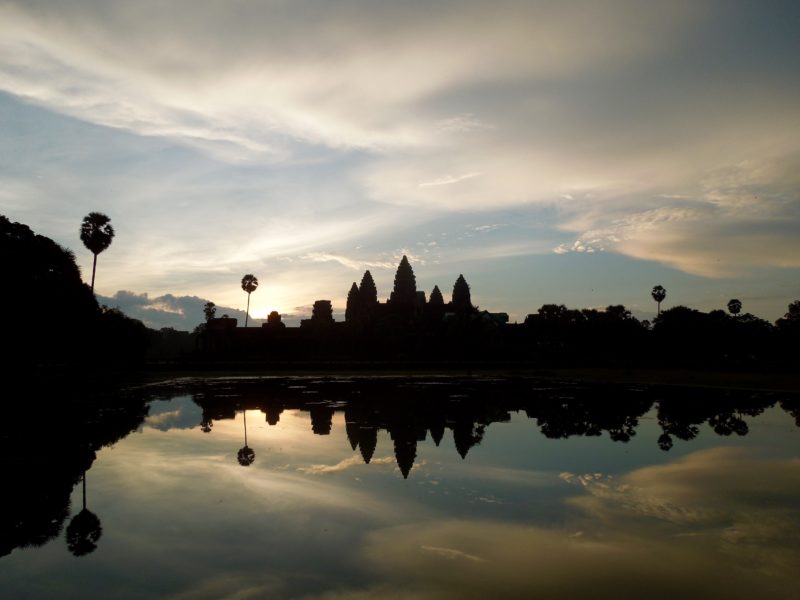
The iconic Angkor Wat
Its pointed towers rising up from the base structure are a classic example of Khmer Architecture of the 12th century, and, based on its prominence, some suspect that this structure was actually constructed by Suryavarman to be his final resting place. Angkor Wat, in short, is a temple like you’ve never seen, on a scale you couldn’t have anticipated. It doesn’t disappoint.
FIND OUT WHAT IT’S REALLY LIKE ON AN INTREPID TRIP TO CAMBODIA, IN PHOTOS
Angkor Thom, known as the Bayon Temple, is also an absolute must. Technically Angkor Thom is a city built by the ruler Jayavarman VII and the Bayon Temple is within it, but they’re often thought of as synonymous. Before I move forward describing what the Bayon Temple is, you should note that there’s no need to be intimidated by the distances between temples as you can take a tuk-tuk between sights to save time if you’ve only got a day.
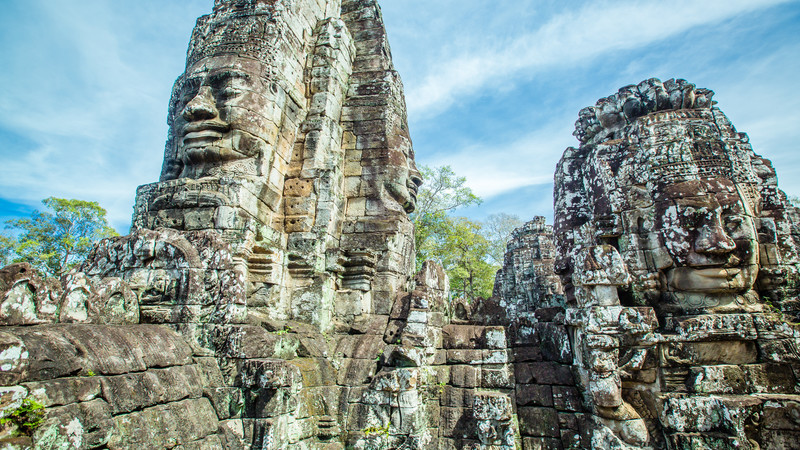
Bayon Temple
The Bayon Temple is a very impressive temple built towards the end of the 12th century, and it’s beyond photogenic. What makes it unique is the smiling faces which jut out of the rocks and greet you with their warm disposition.
Insider tip from top Intrepid guide in Cambodia, Channa :
My favourite spot in the whole park is Bayon Temple, one hour before sunset. There are fewer tourists, it’s cooler and when sun rays hit the faces it is just magic.
Lastly, you’d be remiss to leave without spending some time at Ta Prohm Temple, which was constructed roughly around the same at Angkor Thom, and commissioned by the same ruler. Ta Prohm was constructed to be a monastery and university, and what is perhaps most impressive is that it’s still in remarkable condition considering when it was constructed. What makes it truly famous, however, is the way the jungle has grown into and straddled the structure. It’s an example of what happens when a man made structure is essentially given back to nature. To me, this is the most unique spot to snap a photo.
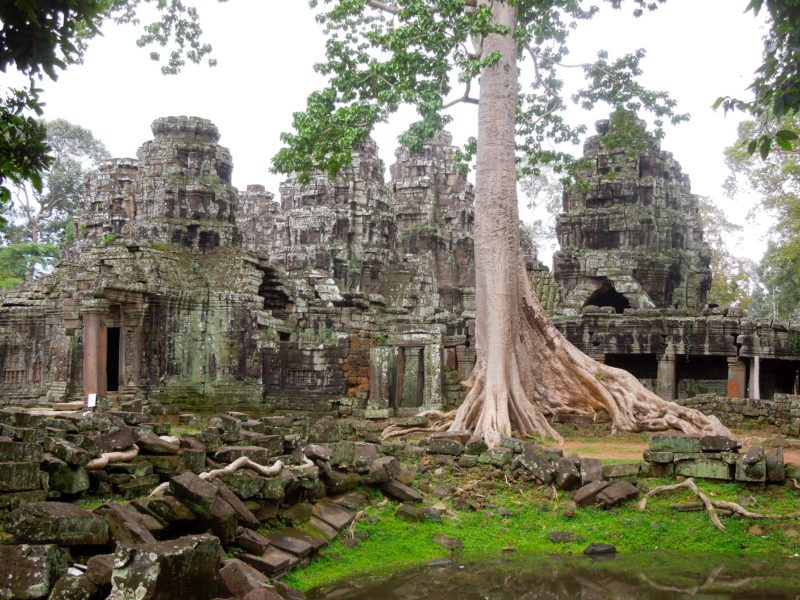
What should you see if you’ve got time to spare?
The sights listed above will astonish you, but they’re far from the only sights to see. Preah Khan is also dazzling in its own right, and it’s not too far away from Ta Prohm and other more famous temples. Preah Khan was also built by Jayavarman VII (12 century), but, in this case, to honour his father. It served as a massive administrative headquarters of sorts, but is now famous because of the overgrowth that has added a layer of mystique.
Jayavarman VII also built a small temple known as Ta Som. It’s a temple dedicated to his father, Dharanindravarman II, and it’s not far from Angkor Thom, which makes it well worth checking out. It’s a single-level shrine that has been left unrestored, and also exists in congruence with growth of the jungle. This is a nice temple to check out if all the other more popular temples seem a little crowded.
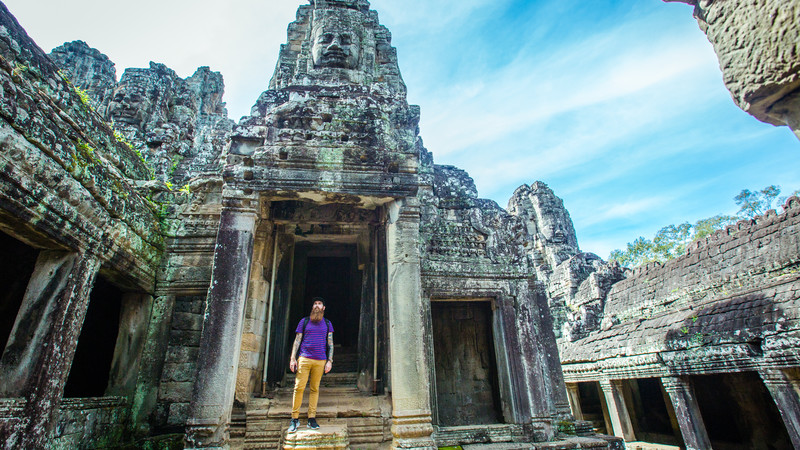
An Intrepid traveller exploring Angkor Wat
Perhaps the unsung hero is Banteay Srei, which you wouldn’t be able to fit into a short visit, but is certainly worth fitting into an extended visit. It’s about 25km away from the more well-known temples, but it often receives rave reviews from tourists due to the fact that there are less crowds, and it’s build with red sandstone. It’s not large and imposing, but it’s gorgeous, ornate, and offers something a little different. Not to mention, it was built in the 10th century, so it predates much of what you’ll see elsewhere!
What can you do in Siem Reap?
I’m not going to lie, when I was staying in Siem Reap, I likely stayed out on Pub Street a touch longer than I needed to the night before heading to the Angkor Archaeological Park. Now, while I wouldn’t recommend that, I also can’t say I regret it. Siem Reap is a fun place to be.
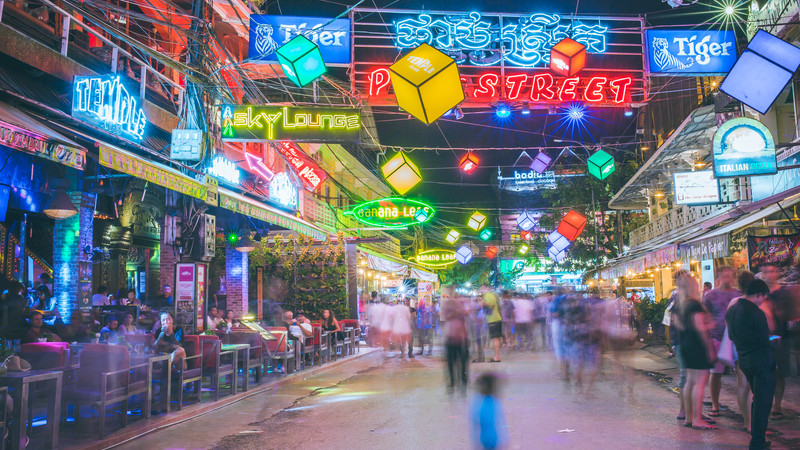
That being said, Siem Reap is a lot more than just “Pub Street,” that’s for absolute sure. The food in Siem Reap is just remarkable, and it’s a good place to dive into Cambodian cuisine which, in my opinion, deserves just as much respect as Thai or Vietnamese. I personally love Fish Amok, which is essentially a fresh fish curry (usually served in a banana leaf), but I’m also a fan of Lap Khmer which is more or less beef salad. I’d also say that you’re safe trying most curries, especially red curries, as they’re to die for.
READ MORE: A GUIDE TO CAMBODIAN DISHES AND MUST-VISIT RESTAURANTS
One of the more unique experiences that I had in Siem Reap was taking one morning to go out to the Tonlé Sap Floating Villages (explore them on this day tour). It was fascinating to see how people lived seasonally when the lake flooded, and the communities that formed more or less on stilted houses.
What to do in Siem Reap according to top Cambodian Intrepid guide, Channa :
Go to Phare (a circus with dance, theatre and live music that tells Cambodian stories). Go to the Angkor Silk Farm . Go shopping, visit local villages and monasteries, and try a cooking class.
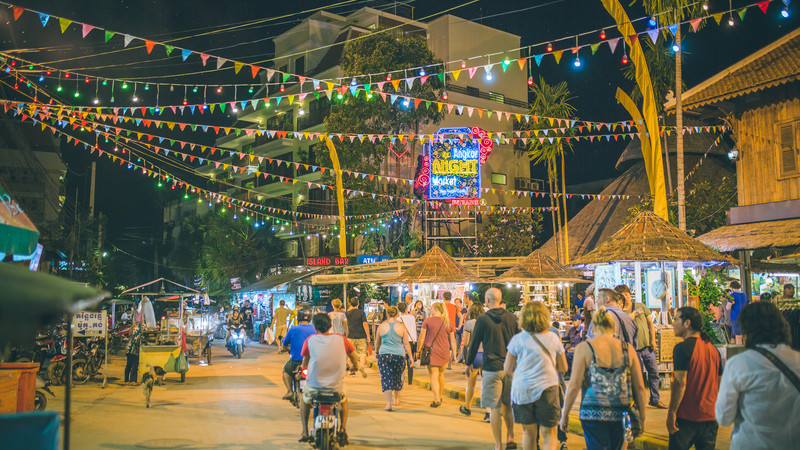
Siem Reap, by night
So, why go?
I’ve been to the Angkor Archaeological Park, but I’m yearning to go back because it’s just that special. I’ve always been a creative and imaginative person, and I feel like visiting this place unlocked doors I didn’t know existed for me. It was like watching fact and fiction blur together before my eyes.
That’s what makes this place so unbelievable, it’s the idea that, unless you go, you just can’t imagine being there. I look around today at the skyscrapers that populate the skylines of most metropolitan cities, and I just can’t imagine them being around for too long. Then you have the Khmer temples which have endured centuries, and will still be there long after the skyscrapers are gone.
Ready to experience this awe-inspiring site for yourself? Check out Intrepid’s range of tours in Cambodia.
(Image credits from top to bottom: Intrepid Travel x5, Chris Mitchell, Intrepid Travel, Chris Mitchell, Intrepid Travel x3.)
Feeling inspired?
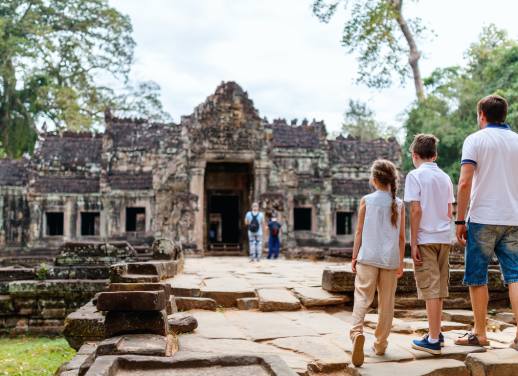
Chris Mitchell
Chris regularly thanks his unquenchable sense of curiosity for ensuring he's never in one place for too long. He's been to over 75 countries across this gorgeous planet of ours and has always felt that all that's needed for a good trip is a well-bound notebook, a well-written book, and a passport with an expiry date that offers a little wiggle room for extending your journey. As a freelance writer and blogger, Chris is only too pleased that his passion for travel, photography, and writing have ever so politely collided. You can follow his adventures at travelingmitch.com, or with the handle @travelingmitch on any of your favourite social media platforms.
You might also like
All aboard the rail renaissance: 7 reasons to..., explore these 7 tea rituals from around the..., why travellers are choosing the galapagos off-season, tips and hacks for train travel in europe, why train travel is the one experience you..., everything you need to know about a night..., mind your manners: dining etiquette around the world, 5 places to escape the crowds in italy..., is australia safe everything you need to know, 10 fun facts you might not know about..., 12 facts you probably don’t know about guatemala.

Visiting Angkor Wat – The Ultimate Guide
Posted on Last updated: January 29, 2024
Categories Asia , Cambodia , Guides , Travel Guides
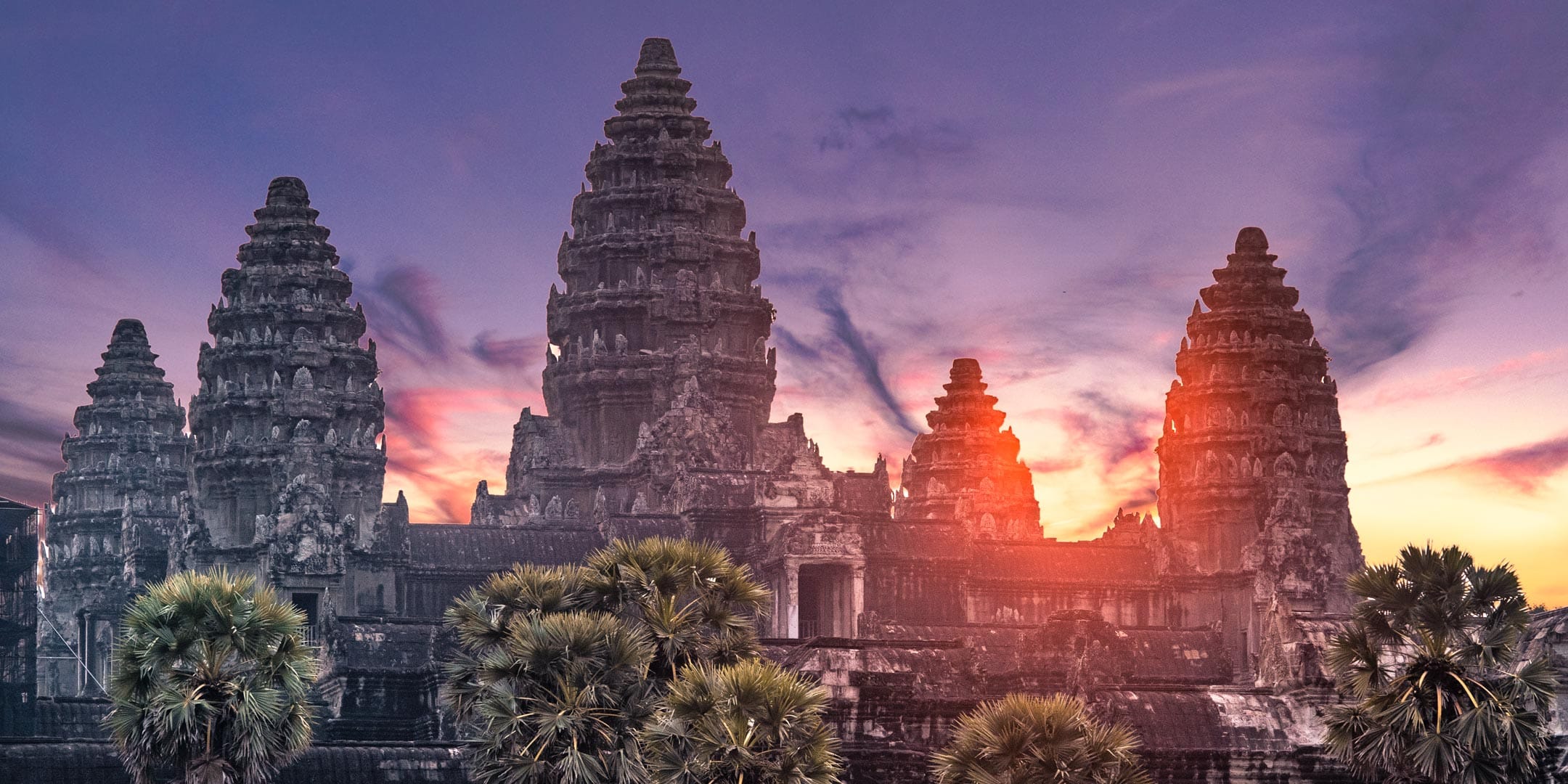
Visiting Angkor Wat is not hard. Being one of the most popular tourist attractions in Asia and the biggest highlight of Cambodia, the ancient Khmer city hosts millions of tourists every year.
Visiting Angkor Wat the best way possible and having a wonderful time – well, this is not as easy as it sounds. Avoiding hordes of tourists, surviving Cambodia’s scorching heat, and finding the best route around the dozens of temples can leave you physically and emotionally exhausted. Visiting Angkor really is a daunting task.
It is possible, though, to see one of the biggest marvels in the world, have a great time, and even avoid the gazillion other enthusiasts. No, I’m not advertising some group tours here ( I hate those ). If you plan your visit carefully ( and I guess you’re already doing that since you’re reading that post ), you can be prepared for everything Cambodia has to throw at you. And if you follow my itinerary, you can even avoid the massive crowds ( not all of them but at least the huge groups ) and see Angkor Wat the best way possible.
Now I know what you’re thinking: Is it really necessary to read such a long guide only to visit a temple? Angkor Wat does look big, but is it really that hard to see? Well, Angkor Wat is significant indeed, but that’s not the main reason you need a guide. Believe it or not, to see Angkor Wat the best way possible, you need not one but three days. How come? Because Angkor is not just a temple.
What is Angkor Wat
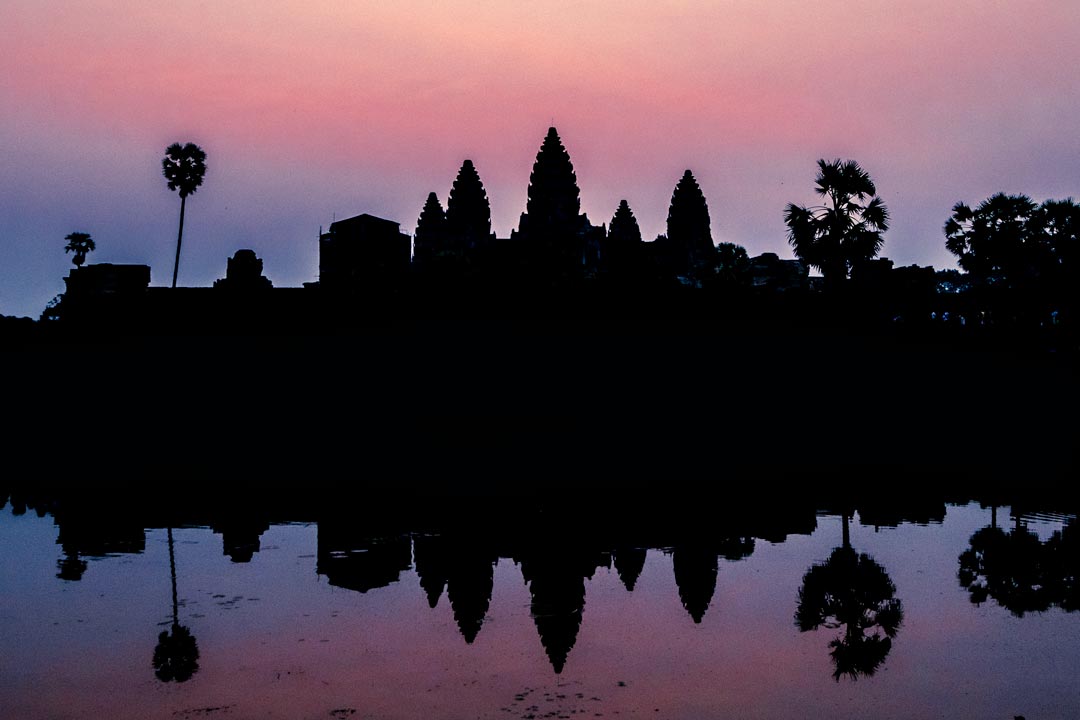
Wait, I thought Angor Wat is this colossal temple that’s on the flag on Cambodia. What do you mean, it’s not a temple?
Well yes, this is Angkor Wat, but it’s only one of the many temples in the Angkor Archeological Complex. A building complex containing more stone than the great pyramid of Giza and covering four times more land than Vatican city. The forgotten medieval metropolis used to be home to more than 1,000,000 people, and it’s considered to be the largest preindustrial city before the Khmers abandoned it.
We can see only a glimmer of the glorious site today. The reason is that apart from public infrastructure and temples, all other buildings were built by wood, which was fastly consumed by the merciless Cambodian jungle. Due to many wars and political instability, most of the city remained hidden in the wilderness until it was rediscovered in 2007.
The main temple – Angkor Wat – may be the largest religious structure on Earth and the biggest highlight of the park, but it is more definitely not the only thing to see there.
Getting to Angkor Wat
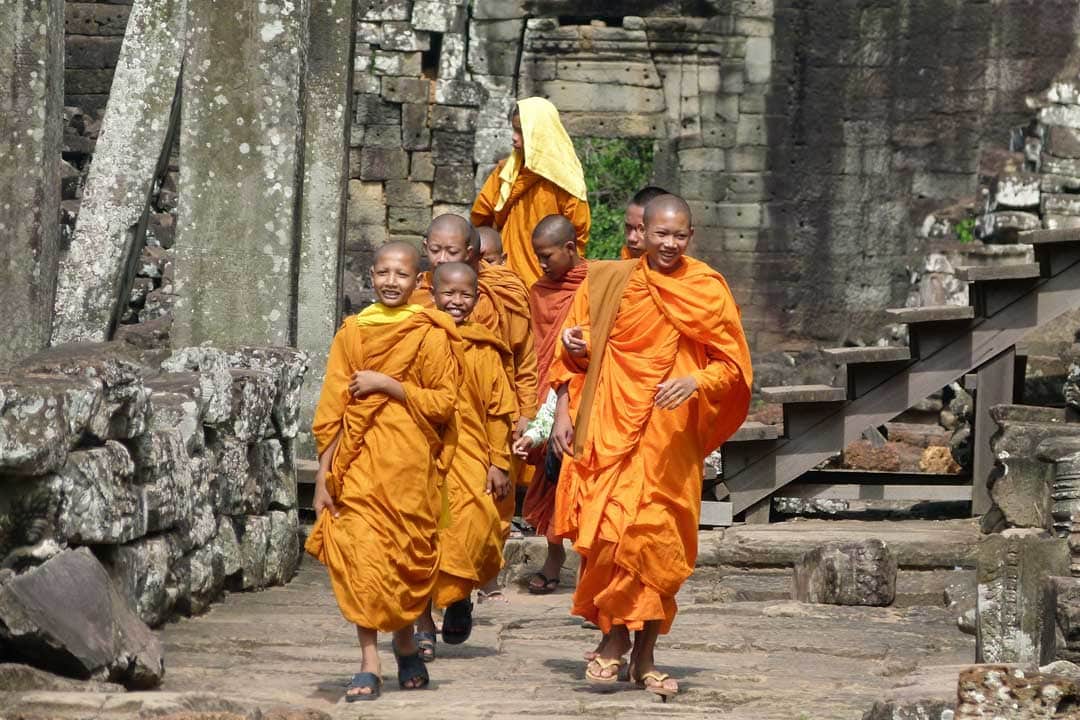
Getting to Angkor Wat is the easiest part of the whole adventure. Being an immensely popular travel destination, everything around the archeological complex is built for tourists.
The gateway to the temples is the Cambodian city of Siem Reap. It has a modern airport, plenty of hotels, and food joints ( including a vast choice of western food ). If you prefer to travel by bus, Siem Reap has more bus routes to it than any other place in Cambodia.
If you still haven’t got your Angkor Wat journey set, check out 12go.asia . The unrivaled number one transport site in Asia.
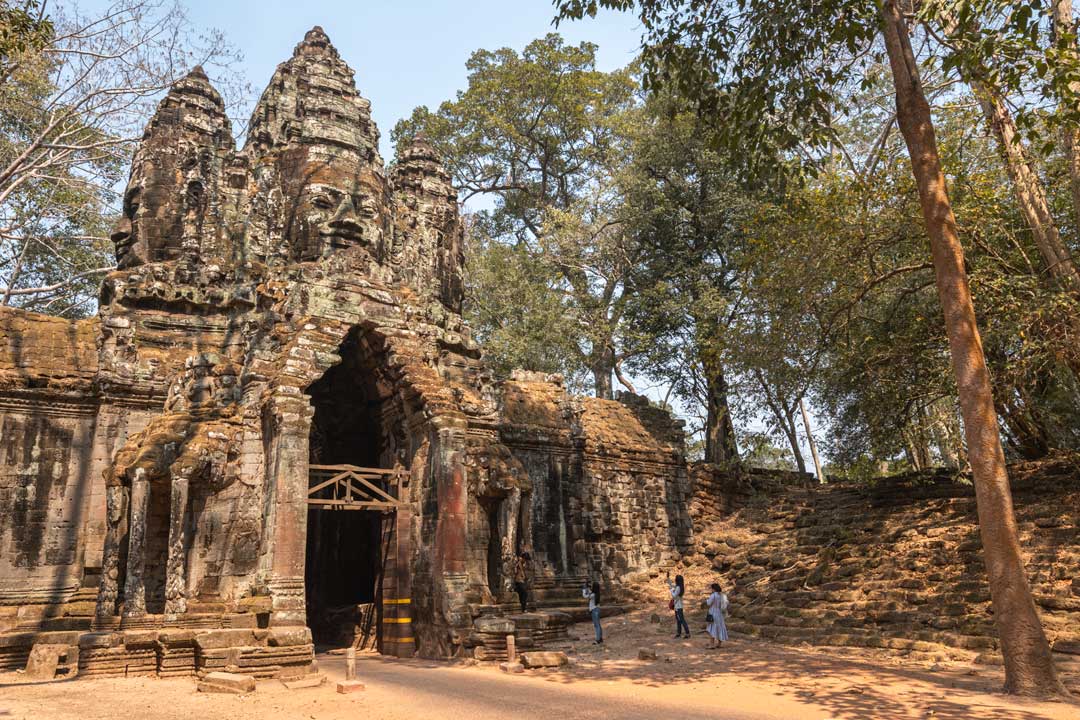
The Angkor Wat archeological complex is located around 5km ( 3 miles ) from Siem Reap, and you can’t reach it by foot ( I mean you can, but it would be very unpleasant and would waste a ton of time ). You can hire a bike which I wouldn’t recommend unless you’re a big bike enthusiast ( distances between the temples are significant, and Cambodia is hot and dusty ) or hire a tuk-tuk driver.
Tuk-tuks are the most popular way to explore the Angkor temples. They cost around 20-30 USD per day and can be found everywhere in Siem Reap. Keep reading to see how to get yourself a top-notch tuk-tuk driver.
Where to Stay in Siem Reap
Central Blanche Residence
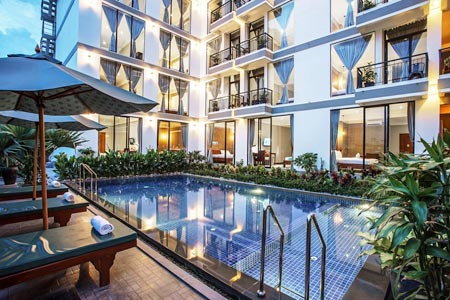
An incredible value for money, the Blanche residence offers modern, clean rooms, and friendly staff that goes above and beyond to satisfy your every need. Airport shuttle and breakfast are also included in the price. Also, a great pool area which is vital to surviving the scorching heats of Cambodia! See the latest prices
Want to explore more options in Siem Reap? See the best hotels in town with a tasty breakfast and free wi-fi
What’s Inside the Angkor Complex
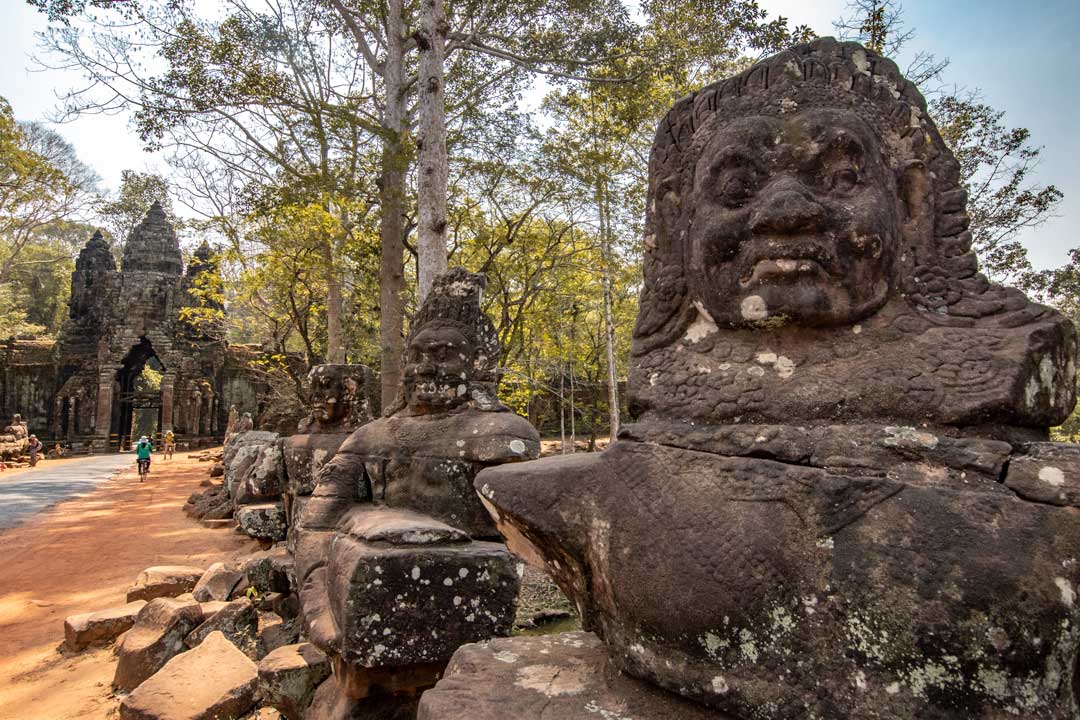
There are around 50 temples inside the Angkor Wat complex, but very few people attempt to see them all. Since some of them are not in perfect condition while others have kind of a similar design, there’s no need to do it. Here are the must-see temples I recommend checking out when visiting Angkor Wat.
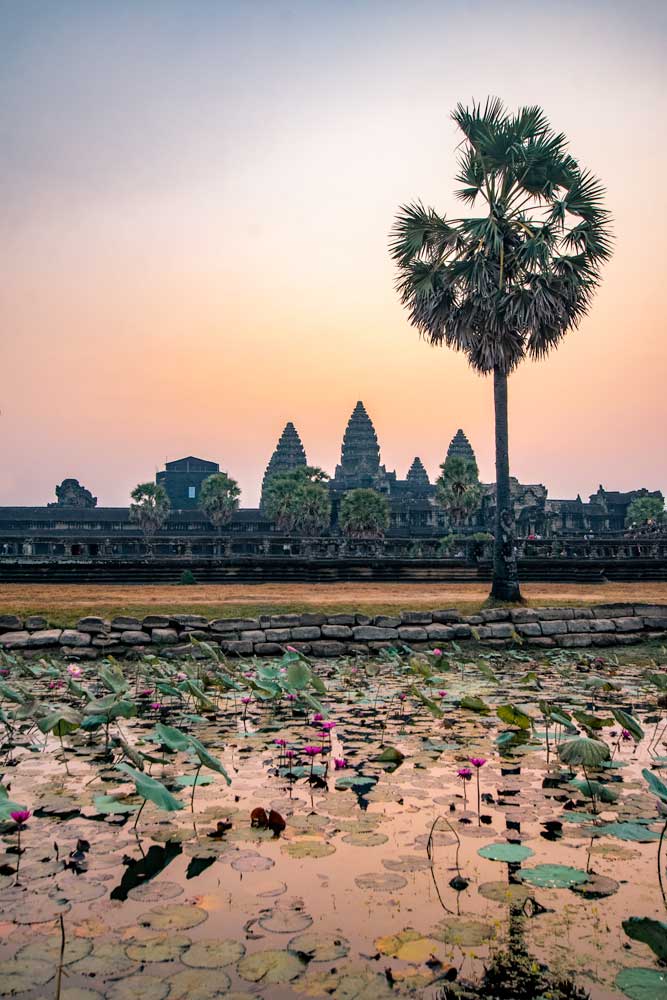
No surprise here. The biggest reason for your Angkor visit is to see the main temple, of course. Built in the 12th century and rediscovered for the world in 1860, Angkor Wat is the largest religious structure on Earth. It’s the symbol of Cambodia and ( probably ) the most recognizable monument in Asia.
Angkor Thom
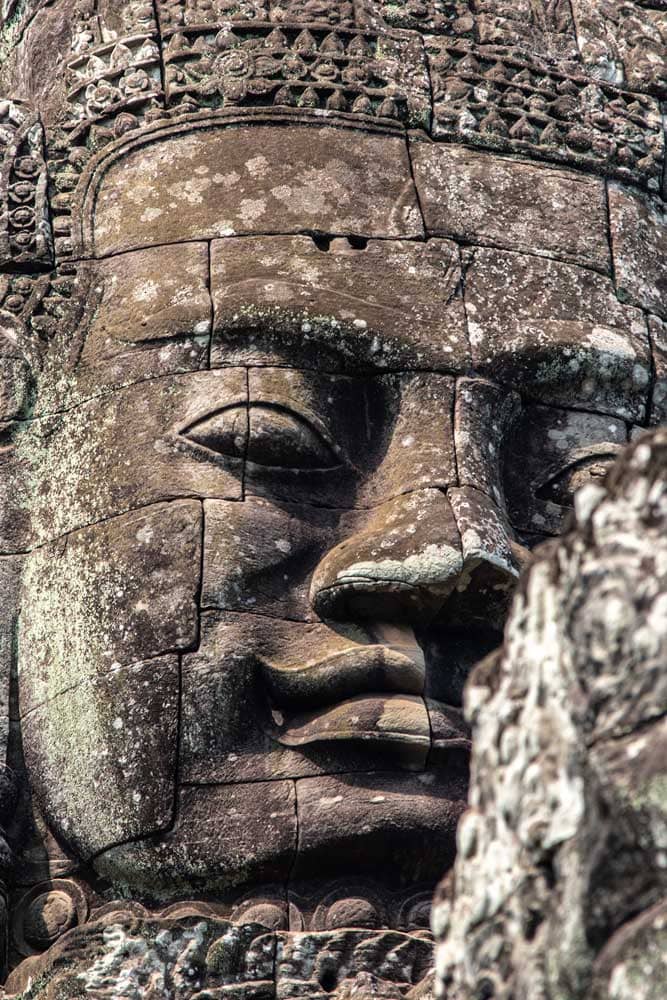
The second most famous sight in the complex, Angkor Thom, is not just another Khmer temple. Angkor Thom is a whole city with its own sanctuaries, gates, terraces, streets, and everything! It was the last great capital city of the Khmer Empire, and it’s absolutely glorious.
If there is only one thing to see in Angkor Thom, it’s the main city temple – Bayon. Decorated with 54 gigantic smiling faces, the temple is one of the most enchanting places on the planet.
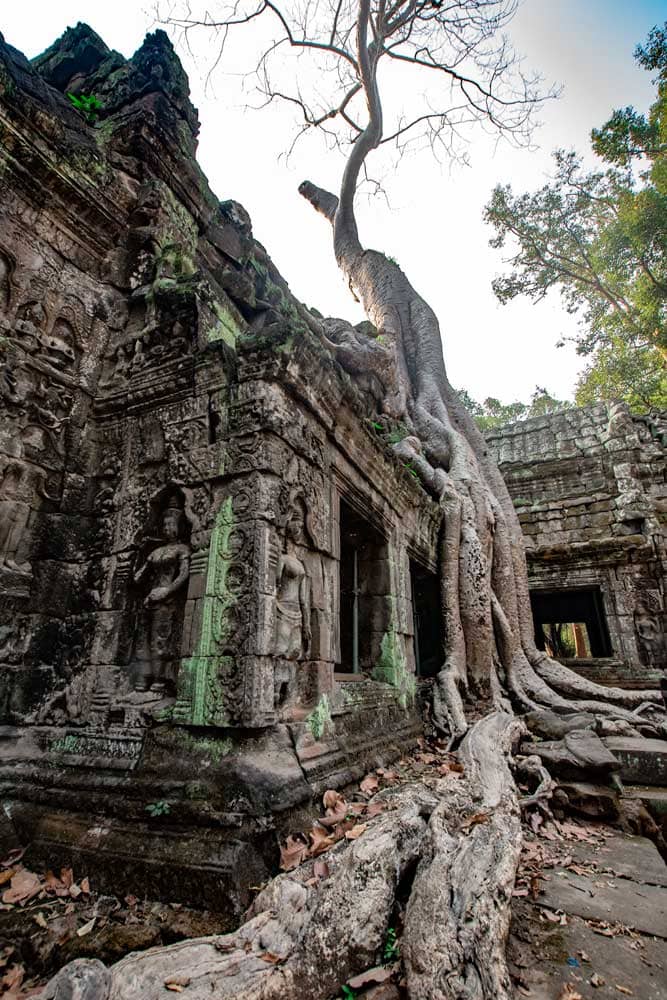
The last of the big three, Ta Prohm is known as the “Tomb Raider Temple”. Once the Angelina Jolie movie hit the cinemas, Ta Prhom became a superstar overnight and is now one of the most visited spots in Cambodia.
The magic of Ta Prohm, however, has nothing to do with the movie. Once abandoned ( around the 15th century ), the jungle quickly consumed the temple. The Silk-cotton and Strangler fig trees made the ruins their new home, creating an incredibly picturesque blend between nature and mankind.

A vast temple that used to be home to 100,000 people, Preah Khan is one of the most underrated highlights in the complex. Visiting Angkor Wat and skipping it is a mistake plenty of tourists do. I’m sure you won’t be one of them.
It’s divided into four enclosures, and all of them are full of beautiful bas-relief carvings. To get there, you need to pass through one of the famous moat bridges that depict a battle between mythical Garudas and the King of Nagas.
Banteay Kdei
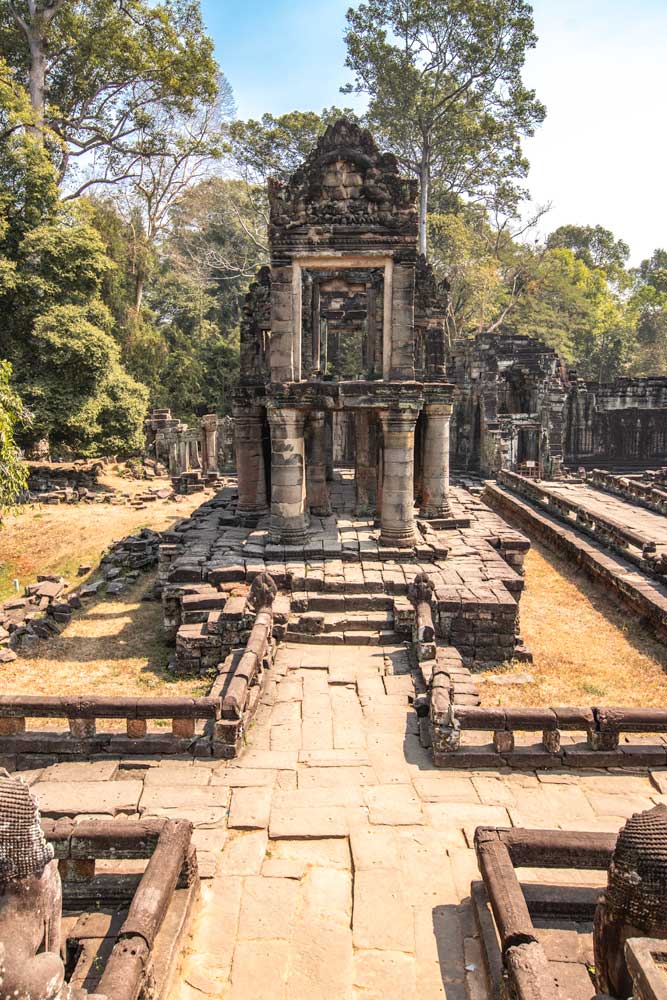
The “Citadel of Chambers” is another hidden gem of Angkor Wat. It’s a labyrinth rich in bas-relief carvings depicting mythical beasts and legends. It’s not on the main path of the tours, so unlike the other temples, you won’t have to battle the tourist hordes to enjoy this sanctuary.
Psst : Wanna know more about the five temples above and see some cool photos? Check out my Top 10 Siem Reap Temples post, and you’ll also learn which are the other five I recommend visiting.
The Best Way to See Angkor Wat
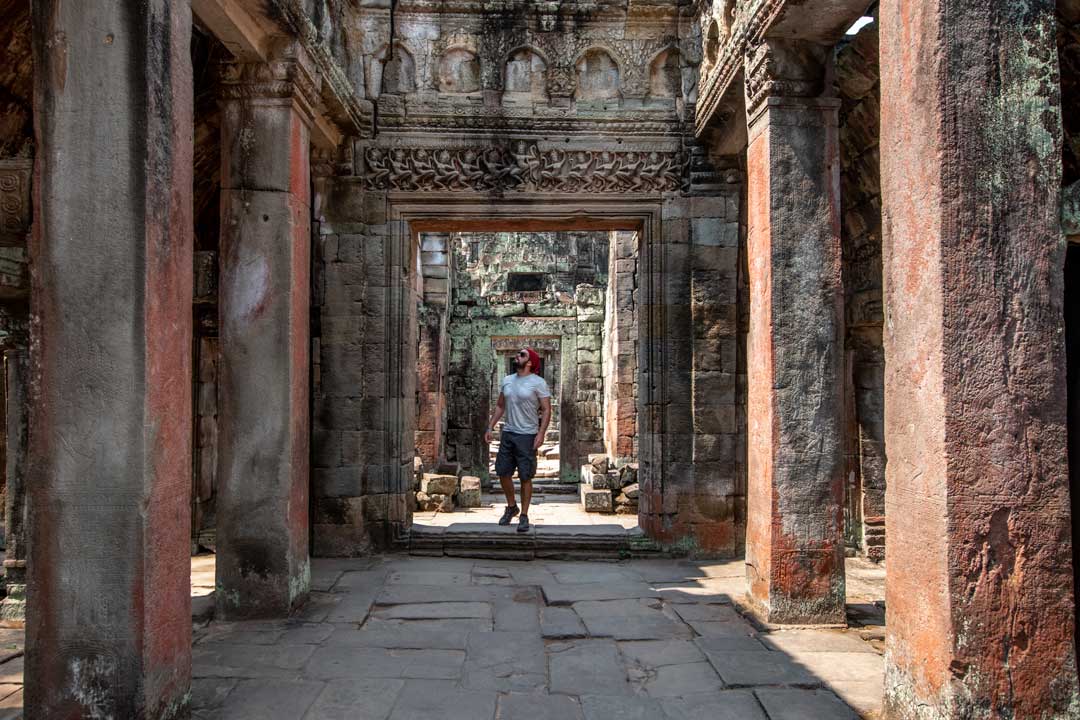
The best way to see Angkor Wat would not lead you around all 50 temples. I mean, if you’re a huge history buff, you can get the 7-day pass and try to do it, but for the regular visitor, so many temples would be too much. I suggest visiting around ten temples in 3 days.
Once you have a tuk-tuk driver, they would offer you three different routes – Small Circle (Angkor Wat, Angkor Thom, Ta Keo and Ta Prohm), Big Circle (Preah Khan, Neak Pean, Ta Som and Pre Rup) and the Long Trip ( Women’s Temple , Landmine Museum and other small temples outside the main park).
For your three days, my best suggestion is skipping the Long Trip and focus on the other two. To escape the crowds and have the best experience possible, we’re going to tweak them a little bit.

If you arrive at Siem Reap at noon – afternoon, Get your ticker at 4:30 – 5:00 PM. Once you have it, go inside the park. Make sure it’s after 5:00 PM though. This late of a visit won’t cost you one of the ticket pass days, and you can watch the sunset for free.
The most famous sunset point in Angkor Wat is the Phnom Bakheng temple. However, the temple only allows 300 people on it, and arriving that late almost guarantees you won’t be able to get in. My recommendation is to go for sunrise over the Srah Srang reservoir.
Best Way to See Angkor Wat – Day 1
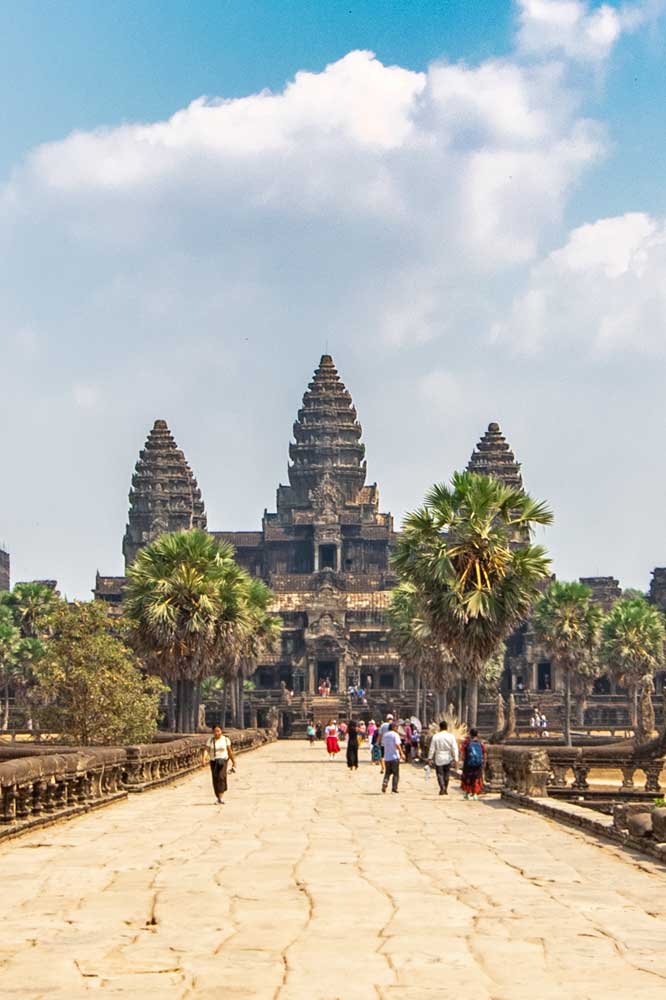
Surprisingly, our first day would start late. Tell your driver to wait for you around 11:00 – 11:30 AM and head straight to Angkor Wat. Note: If you didn’t manage to get your ticket the previous day, your first stop would be the ticket office. Being the main temple, Angkor Wat is impossible to catch free of people, but around noon is your best bet. The first groups are there right after sunrise, while the lazy ones arrive around 10:00 AM. Don’t worry about the sun. It would be hot, but Angkor Wat is mainly covered so you won’t be that bothered.
After lunch, continue to Angkor Thom. The biggest must-see there is the Bayon Temple.
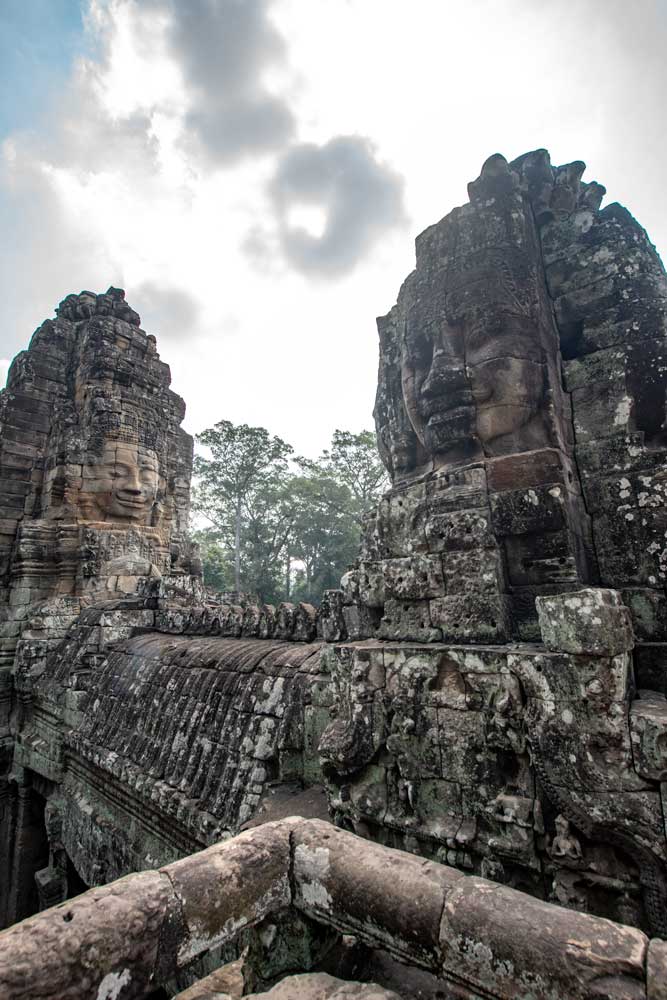
Exploring the two main temples of Angkor should take the better part of the day. If you still have some power left, in the afternoon, you can take a look at the other attractions of Angkor Thom. The Elephant and Leper King terraces are a sight to be seen, while the smaller temples – Baphuon and Phimeanakas – would offer a fascinating non-crowded experience.
Best Way to See Angkor Wat – Day 2
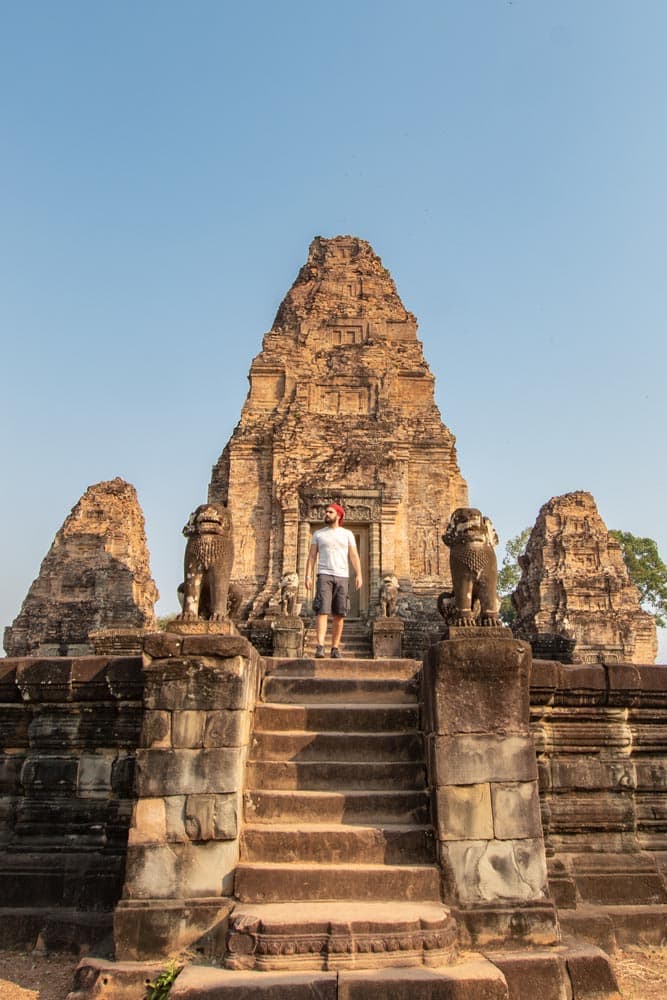
Our second day will start a lot earlier. We’re doing a modified Big Circle today, but to avoid the groups with the same idea, we’ll have to lose some sleep.
Start your trip around 6:30 AM so you can reach the first temple – Pre Rup – before 7:00 AM (groups will arrive around 8:00 – 9:00 AM). Pre Rup is one of the few temples that opens before 7:30 AM, so it’s the perfect place to start your day.
At 7:30 AM, you should be at the second temple – East Mebon. Those two temples may not be as grand as the ones from day one, but they quite different and have their charm.
The third sanctuary for the day is Ta Som. This is the first jungle-consumed temple you’ll visit. Make sure to go to the far end of it to get a picture with the fig tree that hugs the old gate. Ta Som is relatively free of people before 9:00 AM.

Your driver would probably suggest a visit to Neak Pean next, but my advice is to skip it. It’s quite a boring one and will only slow you down. Go straight to the last temple of the day – Preah Khan.
If it’s still early in the morning, there should be no groups hording around. Preah Khan is huge and would easily take you a few hours to explore. Once you get enough ruins for the day ( or the sun becomes too much ), it’s time to go back to Siem Reap and relax. Visiting Angkor Wat sure isn’t an easy task.
On the way back, instruct your driver to go through the North Gate. It’s a very picturesque place, and you won’t be sorry.
Best Way to See Angkor Wat – Day 3
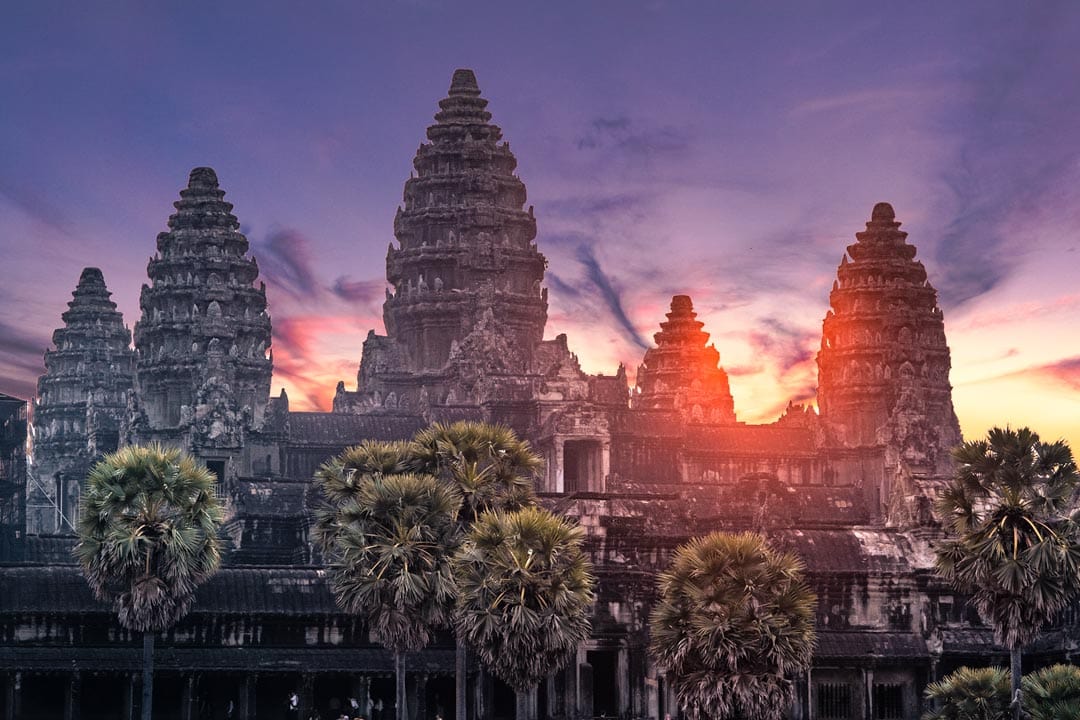
The last day of our Angkor Wat visit will start early. Veeery early. It’s time to witness the most famous sunrise in the world!
If you want to get a good photo, you need to go even extra earlier. Arrange your tuk-tuk for 4:30 AM ( yup, you’ve read that right ) and make sure at 5:00 AM ( when the temple opens ), you are among the first ones to enter. It may sound excessive, but if you want to get a good photo spot, this is the only way. The actual sunrise starts around 6:30 AM, so if you don’t care about the photo, but you’re more into the experience – go an hour later.
Around 7:00 AM, the hordes gathered for the sunrise would either go inside Angkor Wat or go back to the hotel for breakfast. Well, we’ve already seen Angkor Wat, so we make our way to another heavyweight attraction – Ta Prohm.
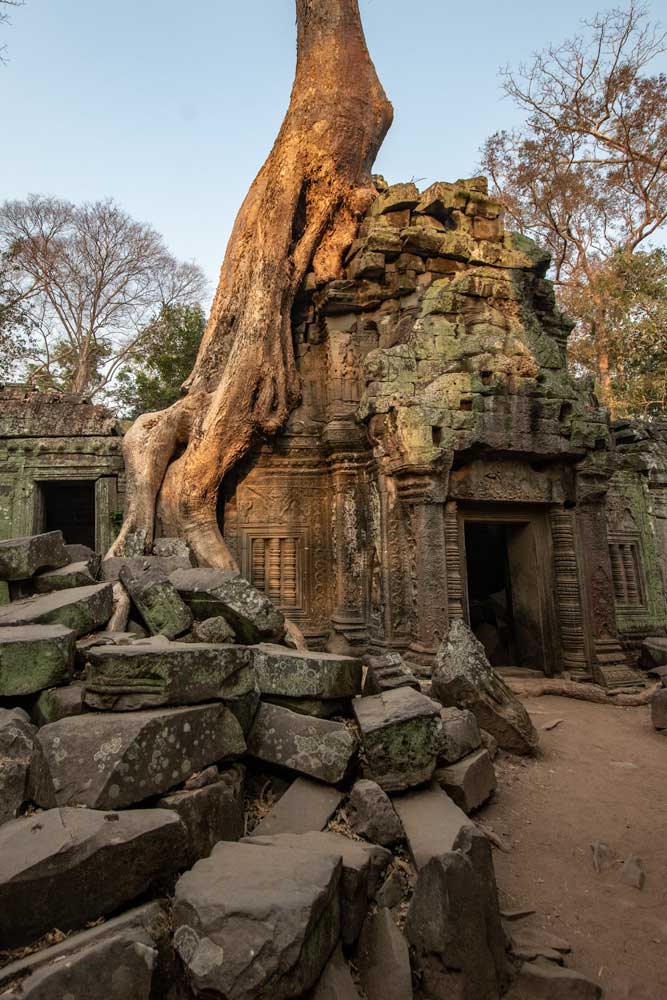
The only time of the day you can catch the Tomb Raider Temple relatively free of people is at its opening times – 7:30 AM. There are several enormous fig trees around the temple, take your time, and see them all. There’s also a very curious attraction named the Dinosaur of Ta Prohm . There is no map, so challenge yourself to find it. Take your time exploring around. This is the last tourist-heavy temple on our visit, so we’re no longer in a hurry.
Our day continues is the underrated Banteay Kdei. No matter the time you make it there, there shouldn’t be a lot of people, so you can enjoy the fantastic bas-relief carvings in peace.
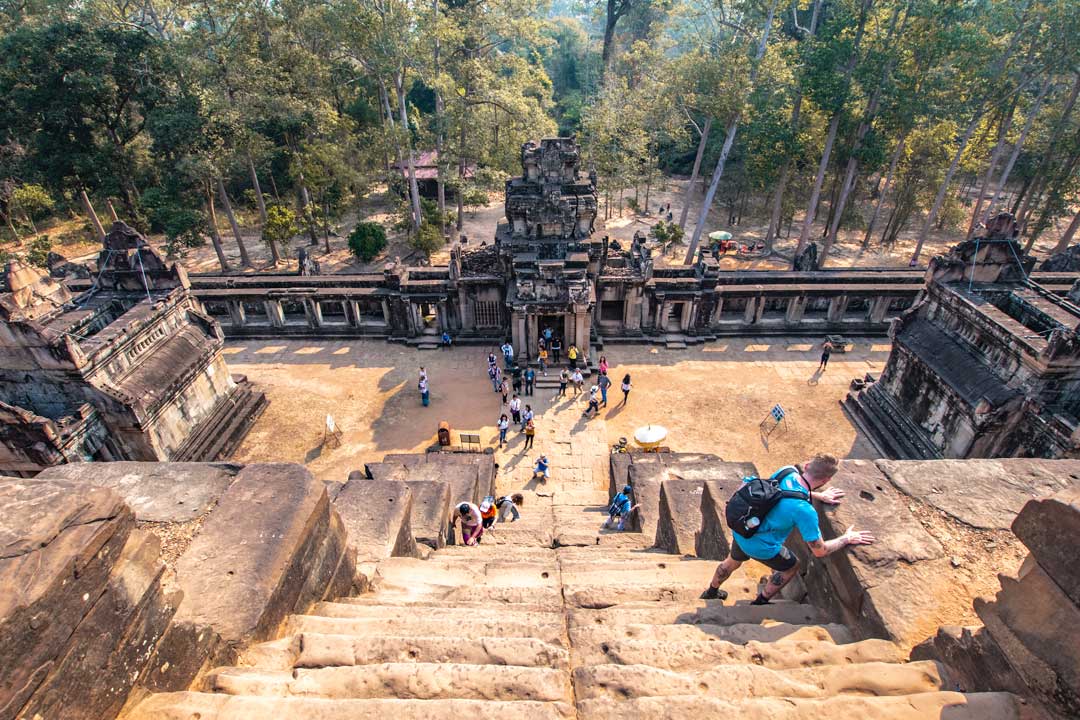
Once you get enough of them, make your way to Ta Keo. This pyramid-shaped temple is not that spectacular, but the climb up ( and down ) makes it an exciting challenge. The top of the pyramid is also a pretty good photo spot, so it’s worth a visit. Other tourists won’t ruin the experience, but there is no shade at this temple, so I wouldn’t recommend a visit at noon.
The last attractions on our Angkor Wat visit are two small temples right next to each other. There’s plenty of shade around Spean Thommanon and Chau Say Tevoda, plus some street vendors selling fruits and drinks. What better place for a picnic and kick-back time.
Your way back to Siem Reap goes through Angkor Thom, so if there’s something you missed on day one, you may stop and check it out now.
Angkor Wat Sunrise
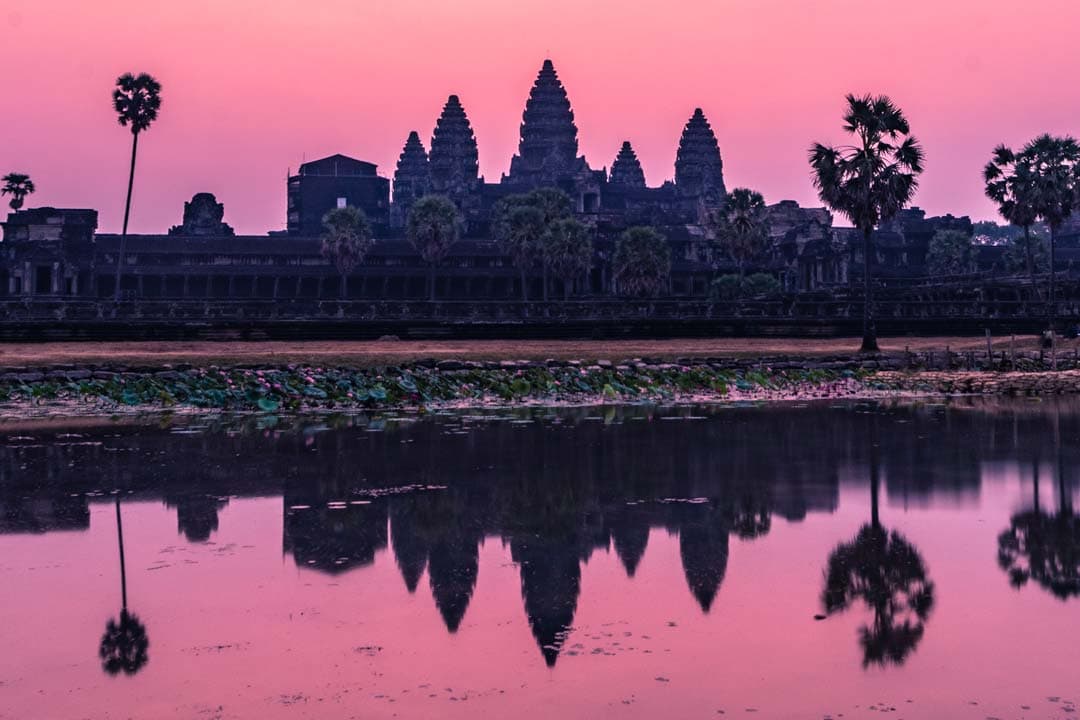
Visiting Angkor Wat is not complete without experiencing the sunrise over the main temple. Let me warn you though, it may sound as a serene activity, but in reality, it is everything but that. Especially if you want to get a good photo.
I like to call Angkor Wat sunrise ‘the most popular sunrise in the world’. There are plenty of places I’ve explored at dawn, but I’ve never witnessed so many people trying to capture the flaming ball of gas. It may be a bit overcrowded, but it’s a definite bucket list experience . And since you’re already in Angkor Wat, it would be a shame to miss it just because you hate getting up early.
Psst: it’s me again! I have another post explaining in detail what to do to have the best Angkor Wat sunrise experience . Check it out!
Some Tuk-tuk Advice
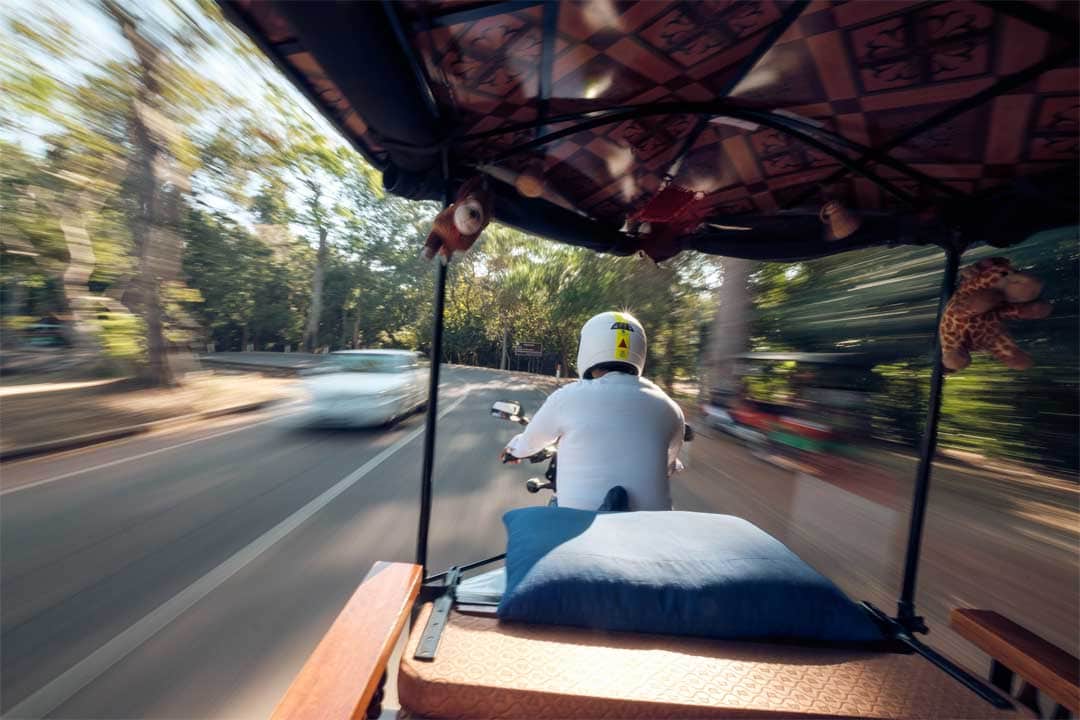
Finding a tuk-tuk driver in Siem Reap is the easiest thing in the world. They would start offering their services at the airport. They would be waiting in front of your hotel. Your hotel would offer you some too. And if you still haven’t got one, just seeing you walking around Siem Reap would attract them like flies. But how to make sure you get an excellent tuk-tuk driver? The answer is – you prepare your transport before you even arrive.
A tuk-tuk driver named Mr.Sok was highly recommended to me, so I gave it a try. Unfortunately, he was already booked, so he arranged one of his friends to show us around.
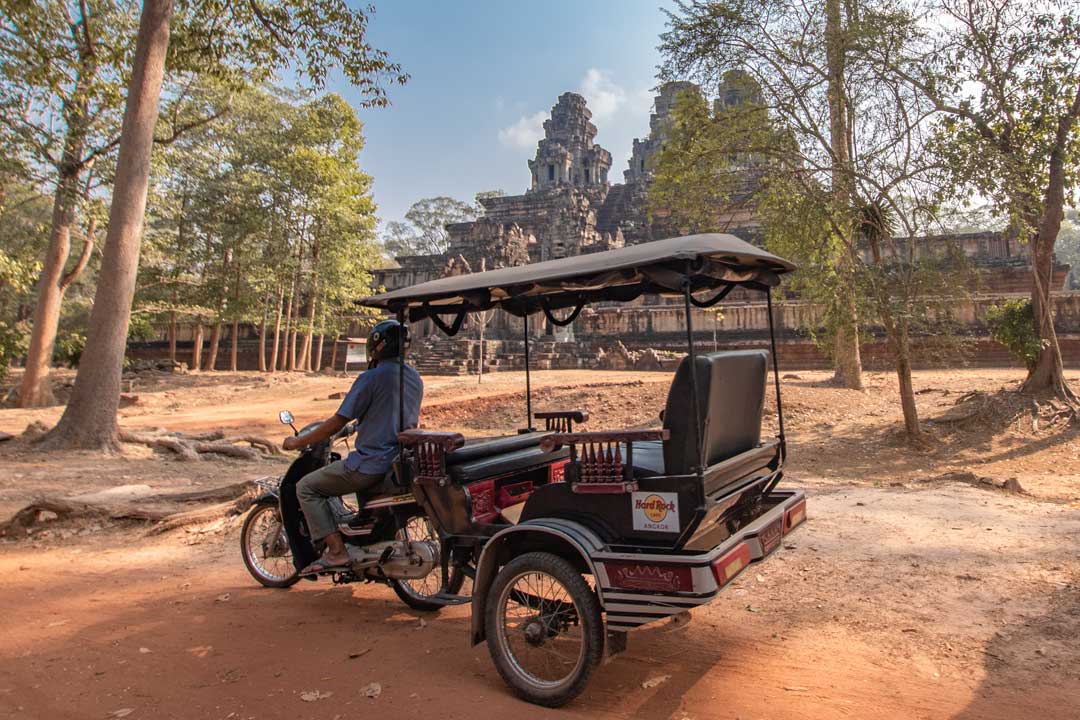
Mr. Thorn ( the friend ) was a cautious driver ( something you would appreciate on the Cambodian roads ). After every temple visit, he was waiting for us with a cold bottle of water and ice-cold wipes. He had some excellent temple advice and was on time every morning, smiling and waiting for us.
To reach Mr.Sok ( or Mr.Thorn ) and guarantee yourself a great tuk-tuk driver, add him as a friend on Facebook first and then write a message ( this way, you can be sure the message will be seen and not sent into the “others” inbox that nobody ever checks ).
Angkor Wat FAQ
What is the angkor wat entrance fee.
There are three types of Angkor Wat tickets: 1-Day pass – 37 USD 3-Day pass ( recommended ) – 62 USD ( The days do not have to be consecutive, this pass can be used on three separate days within one week ) 7-Day pass – 72 USD ( The days do not have to be consecutive, this pass can be used on seven different days within one month ) Tickets are bought only from the official ticket office ( your tuk-tuk driver would lead you there first ), and they have a picture on them. Don’t buy any tickets from the streets or anywhere else. They won’t work.
When is the best time to visit Angkor Wat ?
Ahhh, this is a bit of a tricky one. Angkor Wat is open year-round, but there isn’t really a best time to visit. You’d always have to compromise either with weather or with immense tourist crowds.
For the best weather, December through February is the best time to visit Angkor Wat. Not the hottest of the year but still dry. Those are the tourists months though, so expect to have a large chunk of the 2 million people that visit Angkor Wat every year, there with you.
April and May are hot as hell. Literally…hot…as…hell! The average temperatures are around 35C (95F). Even during the night, it goes a little bit under 30C (37F). If you think you can tolerate such extremes, the tourist crowds would be way more manageable.
From June onwards, the temperatures start to drop, but the rain is becoming more and more often. Cambodia is in the monsoon season. The torrential downpours are usually in the afternoon, leaving the other parts of the day ok for exploring. The showers are quite intense, though. From August through October, Siem Reap receives as much rain as London does for the entire year! If you don’t mind the mud and you’re ready to risk catching a storm or two, the monsoon season would give you pleasant temperatures, low prices, and the smallest amount of tourists possible.
March and November are the shoulder months and maybe (at least on paper ) offer the best balance between weather, tourist crowds, and prices. It’s still a bit of a gamble, though.
Can I use USD in Cambodia ?
The US dollar is an official currency in Cambodia, and it’s accepted everywhere. Just don’t be surprised if you get some change return in the local Cambodian Riel.
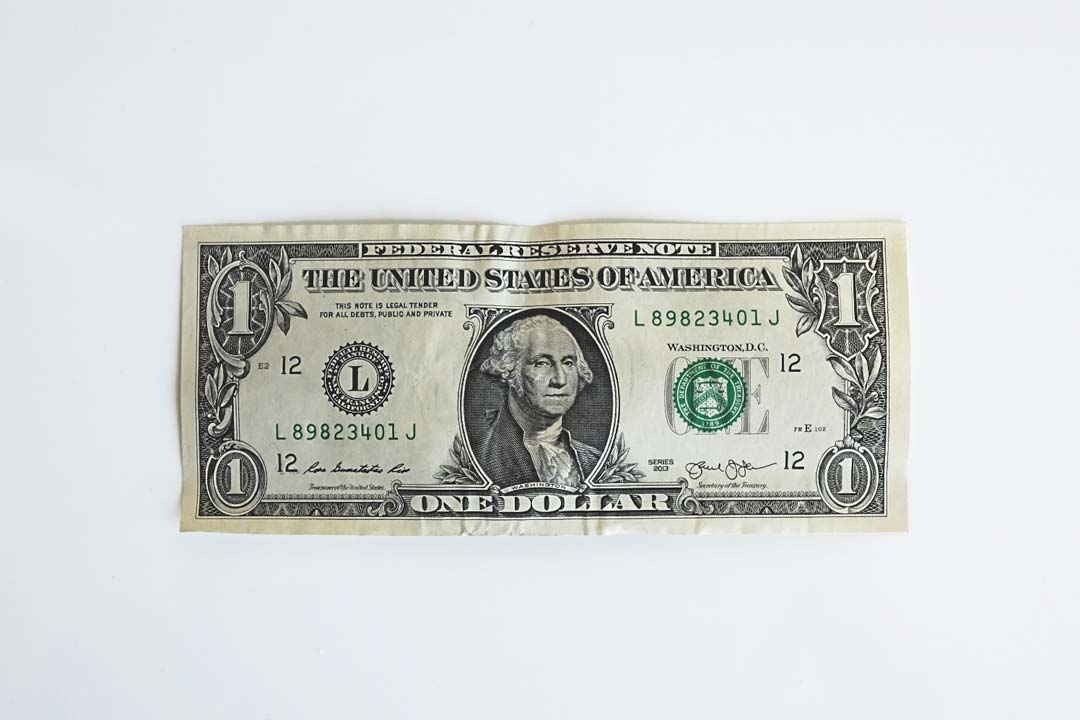
Is one day enough to visit Angkor Wat ?
This one depends on the type of traveler you are and what you expect to see. For me visiting Angkor Wat for just one day is unthinkable. The most popular one-day itinerary is Angkor Wat, Angkor Thom, and Ta Prohm. Going on the most famous Angkor Wat route can guarantee you two things. Huge crowds and a lot of missed things.
The next option is to spend three days exploring the complex. It gives you more flexibility to design your itinerary ( and avoid rush hours ) and also gives you the chance to see more of the wonders of the Khmer. There is a chance that many temples would burn you out, but it’s ( for me ) the best way to see Angkor Wat.
The third option – the weekly pass – is for people who want to explore every detail of the complex and don’t want to rush it. If you have the time and you think seven days of ruins won’t be too much for you, go for it. You’ll explore one of the biggest wonders of the world in a way only a few others have.
What to wear in Angkor Wat ?
Being a religious site, Angkor Wat requires the appropriate attire to visit the temples. Pants should not be above the knee and shirts should cover your shoulders. Tank tops, skirts, shorts, and other revealing clothes are not allowed, and you may be turned away from the temples if you wear one.
Is Angkor Wat open 7 days a week ?
Yes, Angkor Wat is open 7 days a week, 365 days a year.
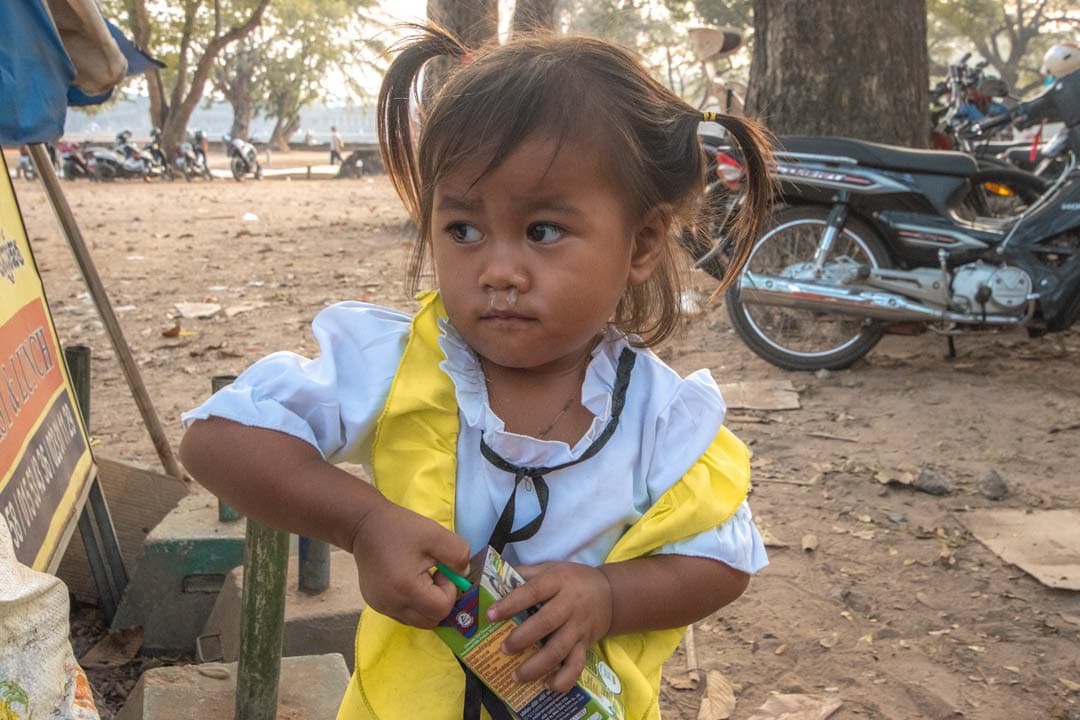
Is Siem Reap safe for tourists ?
It may sound surprising, but Cambodia is an incredibly safe destination to visit. Being the tourist heavyweight of the country, visitors are catered carefully, and crimes are rooted out fast. Just as any tourist place, though, you must always be aware of your surroundings. The violent crimes may be incredibly rare, but petty thefts are not.
A rule of thumb is to not give any money to begging children. As heartless as it sounds, you’d see plenty of kids who would either beg or try to sell you magnets, postcards, and other souvenirs. Buying from them would only encourage this practice to continue, and children to be used as a workforce instead of going to school.
Another rule of thumb is to never travel without travel insurance. I currently use HeyMondo for my travels because they have proven themselves to me more than once over the years. The link above will give you a 5% discount, but If you have another favorite provider, that’s ok. Just make sure you have one because you never know what may happen.
Angkor Wat Itinerary Map
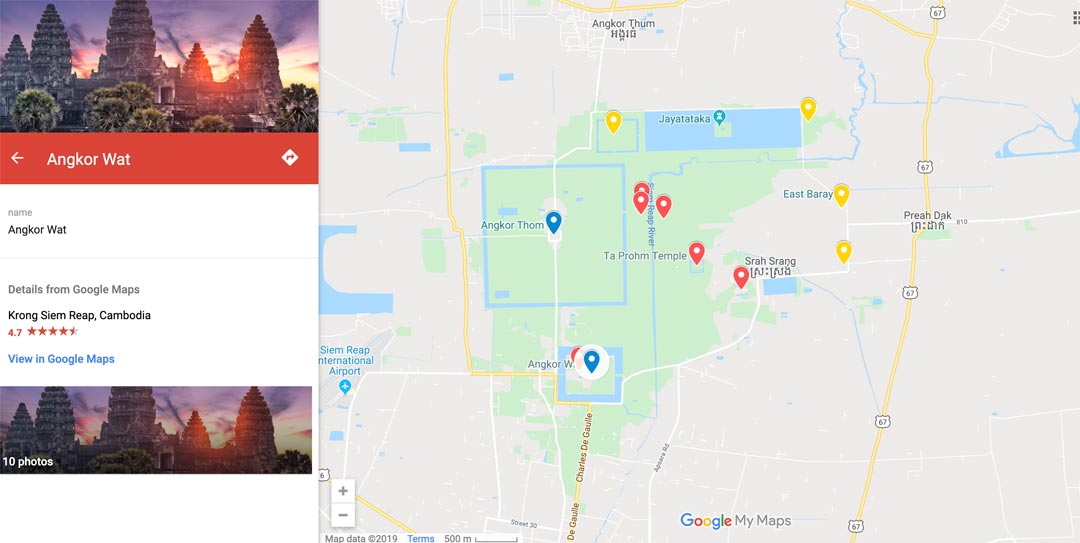
Click to open in google maps
That’s all from me, I hope you enjoy visiting Angkor Wat ! ———————————— If you haven’t planned your trip there yet, find out how I plan my trips! ———————————— I have 11 bucket list ideas for Cambodia. See my impossible bucket list of 1700+ adventures!
Is Angkor Wat on your bucket list?
Some of the above are affiliate links and I will earn a percentage of the sale if you purchase through them at no extra cost to you. This helps keep my site running – so thanks in advance for your support!

Sunday 4th of February 2024
Many thanks for the blog post. We added Mr Sok after reading this and organised two days of driving around the temples of Angkor Wat in February 2024. Great recommendation, he was really great and knowledgeable! Would highly recommend.
Monday 25th of December 2023
Thank you so much for your invaluable info, just back from Cambodia and had an amazing adventure following your advice. I contacted Mr. Sok but didn't get a reply, but found an amazing tuk tuk driver in Mr. Ponleu who was amazing, whatsapp number +855 77 773 425 with excellent English and got me to the temples before the crowds, apart from Angkor Wat of course, like you said that is impossible, but I was on-time and at the front of the lines of folks for the sunrise, and always ready with a cold water once back to the tuk tuk. Thank you again
Sunday 19th of November 2023
Can confirm Mr.Sok is a great choice for a driver :)
Thursday 9th of July 2020
this was a good read for a solo , middle aged traveller hoping to go next year .
Friday 10th of July 2020
Thank you, Jayne! I hope you have the chance to see it, Angkor Wat is truly a remarkable place!
Pin It on Pinterest
National Geographic content straight to your inbox—sign up for our popular newsletters here
- WORLD HERITAGE
Soar Over Cambodia's Stunning Stone City
The ancient capitals of the Khmer Empire house some of the most remarkable architectural and artistic accomplishments of the ancient world.
Deep in the forests of Cambodia ’s Siem Reap province, the elegant spires of an ancient stone city soar skyward above the sprawling complex of Angkor Archaeological Park .
The Khmer Empire’s various capitals thrived here from the 9th to 15th centuries, while their rulers presided over an empire that stretched from Myanmar (Burma) to Vietnam. Including forested areas and newly discovered “suburbs” Angkor covers more than 400 square kilometers.
Though just one of hundreds of surviving temples and structures, the massive Angkor Wat is the most famed of all Cambodia’s temples—it appears on the nation’s flag—and it is revered for good reason. The 12th century “temple-mountain” was built as a spiritual home for the Hindu god Vishnu. The temple is an architectural triumph laden with artistic treasures like the bas-relief galleries that line many walls and tell enduring tales of Cambodian history and legend.
In other parts of Angkor such art depicts scenes of daily life—offering scholars a precious window into the past.
Related: 12 Beautiful Scenes of Cambodia

One tale Angkor’s artists and scribes did not tell, however, is why the city’s rulers abandoned the site and resettled near modern Phnom Penh. Theories include defeats in battle and shifting religious observances, (because the Khmer’s Hinduism was gradually replaced by Theravada Buddhism during the 13th and 14th centuries), but the mystery has puzzled scientists for centuries.
Angkor is as much about water as it is about stone—the site boasts an enormous system of artificial canals, dikes, and reservoirs, the largest of which (West Baray) is 5 miles (8 kilometers) long and 1.5 miles (2.4 kilometers) wide. These incredible feats of engineering form an integral part of an overall site design that remains faithful to religious symbolism. Moats, for example, simulate the oceans surrounding Mount Meru, the home of Hindu gods.
But these massive works also served a practical purpose by skillfully harnessing river and rainwater to quench the thirst of some 750,000 residents in the world’s largest preindustrial city. That water also irrigated wealth-producing crops like rice, which served the Khmer as currency.
Some scholars speculate that the downfall of this elaborate water system led to the end of Angkor. A series of weak monsoons and/or the collapse of the water works due to environmental issues, like deforestation, which drove destructive floods and choked the system with sediment, might have tipped the movement of power toward Phnom Penh.
Even after its glory days had passed, Angkor remained popular with Buddhist pilgrims who journeyed from across Southeast Asia and beyond. Today the site also draws secular travelers—almost a million a year.
When Angkor was named a World Heritage site in 1992 it was also added to the List of World Heritage in Danger; the incomparable site was threatened by pillaging, plagued by illegal excavations, and even dotted with land mines. In 1993 UNESCO launched a major campaign to restore and safeguard Angkor. Thanks to a textbook case of international cooperation Angkor rebounded so dramatically that it was removed from the List of World Heritage in Danger in 2004. [Related: 25 World Heritage Sites in Danger ]
UNESCO continues to be a part of Angkor’s future, working with the Cambodian authorities to ensure that tourism access and development do not compromise this great cultural treasure.

Strangler fig trees and creeping lichens devour ruins at Ta Prohm at Angkor, once home to hundreds of monks.
How to Get There
The nearby town of Siem Reap can be reached via good roads from Phnom Penh and buses and taxis make the trip regularly. Those preferring to travel by boat can also make the trip from Phnom Penh in some five or six hours—about the same travel time as by road. The airport in Siem Reap has service to Phnom Penh and regular flights abroad to Thailand, Singapore, Vietnam, and Laos.
How to Visit
The fast-growing town of Siem Reap is the gateway to Angkor and is filled with lodging, dining, and tour-package options for all budgets and inclinations. Tour buses are available for those whose itineraries match what’s on offer—typically visits to Angkor’s major sites. Those interested in exploring more remote and off-the-beaten-track structures may hire cars or motorbikes with drivers and/or guides who are also able to suggest itineraries. Tethered balloon rides offer a unique aerial perspective from which to view the grand design of the Angkor complex.
When to Visit
Peak tourist season in Angkor is December and January, when rainfall is less likely and the climate is most kind. Temperatures can soar in spring and typically peak in April before the May/June monsoon season. Travel during the monsoon can be uncomfortable. The post-monsoon rainy season continues until October, but rains are sporadic and shouldn’t deter well-prepared visitors, though some remote roads can wash out late in the rainy season.
- Nat Geo Expeditions
Fuel their curiosity with your gift
Related topics.
- WORLD HERITAGE SITES
- ARCHITECTURE
- ANCIENT CIVILIZATIONS
- ARCHAEOLOGY
You May Also Like

20 of the coolest travel adventures for 2024

See these 6 architectural wonders before they disappear

Inside the secret world of the Hopewell Mounds—our newest World Heritage site

See the summer solstice from a Roman emperor’s party cave

Searching for traces of the ancient Chola dynasty
- Environment
History & Culture
- History & Culture
- History Magazine
- Race in America
- Mind, Body, Wonder
- Destination Guide
- Terms of Use
- Privacy Policy
- Your US State Privacy Rights
- Children's Online Privacy Policy
- Interest-Based Ads
- About Nielsen Measurement
- Do Not Sell or Share My Personal Information
- Nat Geo Home
- Attend a Live Event
- Book a Trip
- Inspire Your Kids
- Shop Nat Geo
- Visit the D.C. Museum
- Learn About Our Impact
- Support Our Mission
- Advertise With Us
- Customer Service
- Renew Subscription
- Manage Your Subscription
- Work at Nat Geo
- Sign Up for Our Newsletters
- Contribute to Protect the Planet
Copyright © 1996-2015 National Geographic Society Copyright © 2015-2024 National Geographic Partners, LLC. All rights reserved
ROOTS ABROAD
Explore with us
All You Need to Know About Visiting Angkor Wat, Cambodia
As you plan your trip to Cambodia, the mere thought of visiting the iconic Angkor Wat temple probably fills you with excitement as it’s the highlight of any Cambodia itinerary. For us, visiting Angkor Wat was like a dream come true—a major bucket list item, you could say. And let me tell you, it didn’t disappoint! Stepping into this ancient marvel felt like stepping back in time, with 900 years of history unfolding before our eyes. Angkor Wat isn’t just a single sight; it’s an expansive complex comprising hundreds of temples & ruins , each telling its own story and contributing to the rich tapestry of Khmer culture.
Exploring Angkor Wat is an adventure like no other, but it’s essential to be prepared . From the iconic Bayon and Ta Prohm temples to the lesser-known gems scattered throughout the complex, our comprehensive travel guide is here to ensure your visit goes seamlessly. Whether you’re seeking information on Angkor Wat tickets, the best time to visit, or navigating the vast Angkor Archeological Park, consider us your trusted Angkor Wat companions.
* Disclosure: This post contains affiliate links. We will receive a small commission if you book through our links. This is at no extra cost to you. This way you’re helping us write awesome travel guides and keep providing you with free content. We only recommend products we like and trust ourselves.
Cambodia Trip Planning Essentials
VISA | Cambodia requires a visa for citizens of certain countries. Make sure to check the visa requirements on ivisa.com for your nationality before you go.
TRAVEL INSURANCE | Consider getting travel insurance from Heymondo when traveling to Cambodia. It’s our top recommendation for comprehensive and trustworthy coverage. Get 5% OFF through our link .
STAY CONNECTED | Buy a SIM CARD at the airport the moment you arrive or get an E-sim with Airalo to secure reliable internet access in advance.
HOW TO GET THERE | Discover the best flight deals to Cambodia on Skyscanner .
GET AROUND | Download the Pass App , a ride-hailing app, to order a tuk-tuk or taxi to get around Siem Reap.
ACCOMMODATION | Browse Booking.com to discover budget-friendly hostels and hotels.
TOURS & ATTRACTIONS | For booking the best & cheapest city tours and day trip excursions, check out GetYourGuide or Viator .
TRANSFERS | Ready to travel to your next destination in Cambodia? Book your bus or train tickets via 12go .
Essential Facts about visiting Angkor Wat
- Angkor Wat is widely recognized as one of Southeast Asia’s most iconic archaeological sites, situated in the northwest of Cambodia, near Siem Reap .
- This ancient temple complex holds the prestigious title of a UNESCO World Heritage Site and stands as the world’s largest religious monument.
- Built in the early 12th century under the reign of Khmer King Suryavarman II, Angkor Wat was initially dedicated to the Hindu god Vishnu before being repurposed as a Buddhist temple over time.
- Angkor Wat is part of a vast 400 square kilometer (154 square miles) area known as Angkor Archaeological Park.
- The park not only encompasses Angkor Wat but also preserves remnants of the Khmer Empire dating back from the 9th to the 15th centuries.
- The name “Angkor Wat” translates to “Temple City” or “City of Temples,” perfectly capturing its significance.
- Angkor Wat faces west, a departure from typical temple orientation, sparking speculation about its potential use as a tomb or funeral site.
- Abandoned in the 15th century, Angkor Wat lay forgotten until French explorer Henri Mouhot rediscovered it in the 1860s , reigniting global interest.
- Restoration efforts began in the early 1900s under French authority, and ongoing preservation work is funded in part by ticket sales.
- With over 2.5 million visitors annually, Angkor’s temples remain the main attraction drawing travelers to Cambodia .
- Proudly depicted on Cambodia’s national flag , Angkor Wat serves as a powerful symbol of the country’s rich cultural heritage.
Angkor Wat Travel Basics
The difference between angkor wat, angkor thom & angkor complex.
When planning your trip and researching visiting Angkor Wat, you might come across terms like Angkor Wat, Angkor Thom, and Angkor Complex. Understanding the distinction between these names is essential to navigate the vast historical site effectively.
Angkor Wat , though commonly used to refer to the entire complex, is, in fact, just one temple nestled within the expansive Angkor Archaeological Park . This park encompasses over 1000 temples, varying from modest ruins to grandiose structures, with Angkor Wat as its centerpiece. As the largest religious monument globally and a UNESCO World Heritage Site, Angkor Wat stands as Cambodia’s cultural emblem. Constructed in the 12th century by King Suryavarman II, it was originally dedicated to the Hindu deity Vishnu.
Expanding beyond Angkor Wat, the Angkor Complex comprises the entirety of the ancient city , spanning approximately 400 square kilometers. This area served as the capital of the Khmer Empire from the 9th to the 15th century, housing not only Angkor Wat but also numerous temples and ruins.
Angkor Thom , on the other hand, specifically denotes the ancient royal city that acted as the Khmer Empire’s capital during the late 12th and early 13th centuries. Enclosed by walls and moats, Angkor Thom features five ornate gates adorned with statues of deities and demons. Within its confines lies a plethora of temples and architectural wonders, including the renowned Bayon Temple, famed for its multitude of stone faces.
To summarize, when planning your visit to Angkor Wat, remember that Angkor Wat itself is just one part of the larger Angkor Archaeological Park. Additionally, the Angkor Complex encompasses both Angkor Wat and Angkor Thom , along with various other temples and structures scattered throughout the area.
Where is Angkor Wat & How to get to Angkor Wat?
The Angkor Wat Archeological Park complex lies approximately 15 minutes northwest of Siem Reap’s city center in Cambodia . Siem Reap boasts its own international airport (REP), facilitating convenient access for travelers arriving from Phnom Penh or other major cities across Southeast Asia . AirAsia stands out for its extensive network and competitive fares, making it a preferred choice for many. To uncover the best flight options, we recommend using Skyscanner , a reliable platform for comparing flight prices and discovering optimal routes .
If you prefer overland travel, buses offer a comfortable and budget-friendly option . Giant Ibis, known for its reliability and affordability, operates multiple daily services from Phnom Penh to Siem Reap. The journey typically spans around 6 hours, with scheduled stops for refreshments and restroom breaks along the way. For travelers originating from Thailand , Giant Ibis also offers routes departing from Bangkok , with a journey time of approximately 7-8 hours. Securing your bus tickets is made easy through online booking platforms like 12GO.Asia .
Where to Stay when visiting Angkor Wat?
If you’re planning on visiting Angkor Wat, the city of Siem Reap makes for the perfect base, situated just south of the complex. Accommodation options in Siem Reap cater to every budget, particularly around the vibrant Pub Street area downtown . Here are our top picks for where to stay when visiting Angkor Wat:
LUXURY | Angkor Village Hotel – Featuring stunning Khmer architecture and lush gardens, this hotel offers a refreshing swimming pool, on-site dining, and spacious rooms with serene garden views. Convenient amenities include tour bookings and rentals, with city attractions nearby.
MID-RANGE | Golden Temple Retreat – Just a stroll away from Pub Street and Old Market, this retreat welcomes guests with personalized touches and luxurious amenities. Ground-floor rooms offer private porches and direct pool access, ideal for unwinding after sightseeing.
BUDGET | Khmer House Boutique – Spacious, clean rooms with balconies await at this boutique hotel. Guests can relax by the pool and enjoy a delicious a la carte breakfast, while attentive staff enhances the overall experience.
HOSTEL | Bokre Angkor Hostel – Offering excellent value for money, this hostel boasts comfortable beds, a pleasant common area with a pool, and friendly staff ready to assist with any queries. With convenient facilities and services like laundry and tour bookings, it’s a budget-friendly choice for travelers.
READ MORE | 12 Wonderful Things to Do in Siem Reap, Cambodia | Beyond Angkor Wat
Best Time to Visit Angkor Wat
Cambodia experiences a tropical climate characterized by warm temperatures year-round, coupled with periods of rainfall.
When planning your trip to visit Angkor Wat, aim for the dry season, spanning from November to April . During this period, rainfall is minimal, with December and January offering the most pleasant weather conditions—lower humidity and cooler temperatures. However, note that the peak season from January to March typically brings larger crowds.
For a more tranquil experience, consider visiting at the beginning or end of the dry season or during the rainy season from June to October, when tourist numbers thin out. Keep in mind that navigating outdoor activities, such as witnessing the Angkor Wat sunrise, can be challenging during the monsoon months due to heavy rainfall.
Irrespective of your chosen month, kickstart your day early to beat the scorching mid-day heat . Early mornings provide optimal lighting for photography and offer a quieter ambiance for exploration. However, be prepared for the crowds if you plan to witness the iconic sunrise at Angkor Wat. After a morning of temple hopping, retreat to your hotel to relax or take a refreshing dip in the swimming pool during the peak heat hours. Later in the afternoon, venture out for further exploration of temples or indulge in activities around the bustling city of Siem Reap.
TIP | Ensure you obtain your visa before embarking on your Cambodia trip!
How many days do you need to visit Angkor Wat?
In our experience, trying to see everything in the Angkor Complex in just one day isn’t realistic or advisable. To truly appreciate this ancient site, you’ll want to take your time and immerse yourself in this amazing World Wonder! Setting aside at least three full days lets you explore at a relaxed pace , giving you the chance to discover some of the lesser-known spots along the way. And if you’re into history and ancient ruins, there’s plenty to keep you intrigued, making the seven-day pass something to think about.
From a practical standpoint, the Cambodian heat can be quite intense . After visiting about five temples, fatigue and dehydration can become significant factors. So, it’s smart to spread out your visits over a few days and save some afternoons for relaxing by the pool or checking out other activities in Siem Reap and its surroundings.
While it’s technically feasible to cram the highlights of Angkor Wat into a single day, it’s not the most optimal choice unless you’re constrained by time or budget. Opting for the three-day Angkor Pass allows for a more relaxed pace of exploration , ensuring you can fully absorb the splendor of this ancient site. Further details on pass options are provided below!
Travel Insurance Make sure you’ve got travel insurance sorted for your Cambodia adventure! Heymondo offers coverage for medical emergencies, theft, delays, cancellations, lost luggage, and much more. With 24/7 worldwide assistance and access to medical chat, you can travel with peace of mind. Plus, as a reader of Roots Abroad, we’ve got you covered with a 5% discount !
Angkor Wat Entrance Tickets & Hours
How much do the angkor wat tickets cost.
To gain entry to the Angkor Temple Complex, you’ll need to purchase an Angkor Pass. There are three different day pass options available for visiting Angkor Wat , each tailored to suit varying durations of exploration. Please note that the prices listed below are for foreign visitors.
Here are the current ticket options and prices:
- 1-day ticket – $37
- 3-day ticket – $62 . This pass remains valid for 10 days and can be used on three separate, non-consecutive days.
- 7-day ticket – $72 . Valid for one month, this pass allows for exploration on seven non-consecutive days.
BUDGET TIP | As you can see, opting for a 3-Day Pass is more cost-effective if you plan to spend two days exploring Angkor Wat, compared to purchasing two separate 1-Day passes.
Additional Information about the Angkor Pass
- Children aged 12 and under can enter for free, but they must present a passport for age verification.
- Park tickets issued after 5 pm are valid for use on the following day.
- The 1, 3, and 7-day ticket options mentioned above grant entrance to all temples except Kulen Mountain and Bengmealea temple.
- There are no ticket discounts available for groups.
- Similarly, there are no discounts offered for students.
- All tickets require a photo of the holder to prevent resale to other individuals.
READ MORE | The Perfect Siem Reap Itinerary | How to Spend 3 Days in Angkor Wat, Cambodia
Angkor Wat Tickets: How to buy your Entrance Pass
IN PERSON – Tickets for visiting Angkor Wat are available for purchase at the Pass Ticket Counters , situated slightly off the main route to the Angkor Archaeological Park. Please note that queues at these counters can become lengthy, particularly during peak hours. Ticket sales commence promptly at 5 am each morning, making it convenient to secure your pass before embarking on your sunrise adventure at Angkor Wat.
Alternatively, you can opt to purchase your tickets the evening before your visit . Tickets bought after 5:00 pm are valid for use on the following day, although it’s essential to note that the ticket office closes at 5:30 pm. Payment for your Angkor Wat pass can be made using either cash or a credit card.
IMPORTANT | Ensure that your shoulders and knees are adequately covered when purchasing your ticket in person. Failure to do so may result in denial of entry. (See Dress code below)
ONLINE – Excitingly, there’s now the option to purchase tickets online in advance and have them sent directly to your phone. This streamlined process eliminates the need to wait in long queues, offering a hassle-free experience . Simply display your digital ticket on your phone upon arrival—no printing required. If you choose to purchase tickets online through the official Angkor Ticket Office (Angkor Enterprise) , you’ll pay the same price as you would in person. Additionally, you will have to upload a photo for your online ticket, as it will be attached to your virtual pass.
NOTE | Ensure you carry your (online) ticket with you at all times, as there are multiple checkpoints throughout the area where tickets are routinely checked . Substantial fines are imposed for individuals found within the park without a valid ticket!
What are the opening hours of the Angkor Wat ticket office?
The Angkor Wat ticket office officially operates from 5 am to 5:30 pm daily . However, ticket agents typically commence ticket sales as early as 4:30 am, allowing visitors to secure their passes before the sun rises. Arriving even earlier ensures you can secure a prime spot for sunrise viewing.
Where can I find the Angkor Wat ticket office?
The Angkor Wat ticket office is located a short distance outside of town, so it’s advisable to allocate ample time for your journey and ticket purchase on your first day. Make sure to inform your driver in advance about your need to purchase a ticket.
What is the average wait time to purchase tickets for Angkor Wat?
As expected, there’s a significant influx of tourists purchasing tickets for Angkor Wat every morning at 5 am. Fortunately, with over 20 ticket windows available, the wait time is typically minimal, ranging from 5 to 10 minutes.
TOP TIP | In conclusion, to avoid all the above hassle, simply purchase your Angkor Pass online.
Angkor Archaeological Park Opening Hours
- Angkor Ticket Center (Angkor Enterprise): Daily from 5.00am – 5.30pm
- Angkor Wat Temple & Srah Srang: Daily from 5 am – 5:30 pm (open for sunrise)
- Phnom Bakheng & Pre Rup Temples: Daily from 5 am – 7 pm (open for sunrise and sunset)
- All other temples: Daily from 7:30 am – 5:30 pm. (Except for Phnom Kulen and Beng Mealea. you will need to buy an extra ticket to visit these.)
GOOD TO KNOW | You have the flexibility to enter and exit the Angkor Archaeological Park as many times as you wish throughout the day. Feeling tired and sweaty after a morning of exploration? No worries! Head back to your hotel, relax by the pool, catch a quick nap, and return to the park rejuvenated when you’re ready to continue exploring.
How to get around Angkor Wat
The Angkor Wat temple complex is located about 6km north of Siem Reap town. It usually takes around 15 minutes by car or 20 minutes by tuk-tuk to get there, depending on traffic. Despite its vast size, many visitors underestimate just how big Angkor Wat is !
Spanning 400 square kilometers, including plenty of forested areas, the complex has temples scattered quite a distance apart. This means you won’t be able to see everything in just one day. If you’re not booking a guided tour , there are several ways to get around the Angkor Wat temple complex: by bus, private car, bicycle, scooter, or tuk-tuk .
Visiting Angkor Wat by Tuk-tuk
Tuk-tuks are a popular choice for exploring Angkor Wat. We thought it was really enjoyable riding in an open-air vehicle from one spot to another. You can arrange a tuk-tuk through your hotel or haggle with a driver on the street. Prices may vary depending on the tour circuit and whether you want to catch the sunrise at Angkor Wat. Generally, expect to pay between US$15-25 for the day . A tuk-tuk can usually accommodate up to four people, and they often provide complimentary cold water.
Here’s a breakdown of estimated tuk-tuk prices:
- $15 for the Small Circuit Tour Scenic Route
- $18 for the Angkor Wat Sunrise Tour with the Small Circuit Route
- $18 for the Grand Circuit Tour Scenic Route
- $25 for Temples Outside of the Grand Circuit (like Banteay Srei)
Your tuk-tuk driver will pick you up at your hotel at an agreed time and take you between temples. They’ll drop you off on one side of larger temples and pick you up on the other. For smaller sites, they’ll wait for you until you’re ready to move on. Down below we go more into detail about each route, obviously, these routes are customizable and you can discuss alterations with your tuk-tuk driver.
Other Transportation options for Angkor Wat
- If you prefer a more comfortable ride with air conditioning, you can rent a private driver for the day .
- Bicycle rentals are cheaper at around $4 per bike for the day, but keep in mind that exploring the expansive grounds in the Cambodian heat can be challenging.
- Renting a scooter is another option for speed and convenience, especially if you want to explore independently.
- For those interested in an organized guided tour experience, a two-day tour of Angkor typically covers the small and big circuit tours, ending at Banteay Srei outside the complex. This tour includes an English-speaking guide and transportation via an air-conditioned private car with hotel pick-up and drop-off.
Do You Need a Tour Guide for Angkor Wat?
We want to emphasize that booking a tour is not a necessity to visit and explore Angkor Wat . It’s entirely possible to experience Angkor Wat independently by arranging transportation to visit the temples. That’s exactly what we did because we wanted to enjoy the temples peacefully, at our own pace. Of course, if you wish, you can always hire a guide on the spot to spend a few hours learning more about the history and then continue exploring on your own. Whether or not you decide to hire a tour guide for your visit to Angkor Wat is entirely a personal choice.
For those who are history buffs and eager to delve into the historical, architectural, and cultural aspects of Angkor Wat, we highly recommend hiring a guide. A knowledgeable guide can greatly enrich your experience by revealing the secrets of the temples. Guides can be found through platforms like Viator or arranged through your hotel when booking circuit tours directly. You can even find guides available at the entrance of Angkor Wat itself. However, don’t expect your driver to serve as a substitute for a tour guide . While most drivers may speak basic English and offer some information, their primary role is to transport you from one location to another.
Angkor Wat Tour Routes – The Small Circuit & The Grand Circuit
When visiting Siem Reap and Angkor Wat, you’ll often come across the terms “small circuit” and “big circuit” tours. These refer to the two most common routes around the temple complex , which also include other temples covered by the Angkor Wat Pass. While these routes are well-established, they’re also highly adaptable, especially when you hire your own tuk-tuk driver or book a private tour .
Before you commit to a tuk-tuk or private tour, make sure to discuss any changes you want to make to the standard routes . This ensures you get to see the Angkor temples you’re most interested in. Having these discussions upfront helps avoid surprises later, like unexpected costs or missing out on a temple you were excited to explore.
READ MORE | Ultimate Guide to the Best Angkor Wat Temples in Cambodia
Small Circuit Tour Angkor Wat
If you opt for the Small Circuit Tour, you can expect to pay around $15 to $18 for a tuk-tuk driver for the day, or around $70 for a guided air-conditioned car . The price varies depending on whether you include Angkor Wat for sunrise, with departure typically around 4:30 am. This tour route covers the major highlights of the Angkor Wat Archaeological Park , making it ideal for those with limited time in the park.
The Small Circuit Tour includes several key attractions:
- Angkor Wat: As the crown jewel, Angkor Wat offers a spectacular view, especially from across the pond at the main entrance. This is a popular spot for sunrise photography, with the symmetrical temple reflecting in the calm water below. Inside, visitors can explore the temple and its grounds, including climbing the steep stairs to the central complex.
- Bayon Temple: Known for its 216 massive stone faces carved into its towers, Bayon Temple is the second most visited temple on this tour. It sits at the center of the ancient walled city of Angkor Thom, which is worth a stop at its impressive gates. Exit Bayon Temple from the northern end and take a moment to capture some photos at the 350-meter-long Terrace of Elephants.
- Ta Keo: A pyramid-style temple that requires climbing a steep set of stairs to reach the top, offering panoramic views of the surrounding area.
- Ta Phrom: Famously featured in the movie “Tomb Raider,” Ta Phrom is known for its iconic image of enormous trees growing out of the temple ruins, with roots snaking through the stones.
- Banteay Kdei: Translating to “a citadel of chambers,” this temple offers plenty of crumbling hallways and chambers to explore.
- Srah Srang: A massive man-made lake, providing the perfect spot to relax after a day of temple exploration.
Grand Circuit Tour Angkor Wat
The Grand Circuit Tour will cost you approximately $18 to $20 . This route takes you to the outer edges of the park , allowing you to explore a few of our favorite temples like Ta Som and Preah Khan. Since these temples are located further away, the price is slightly higher due to the additional petrol needed for the tuk-tuk ride. If you have extra time in Siem Reap, we highly recommend doing both tours, as all the temples in the park are truly spectacular! The temples listed below in Angkor are usually less crowded with tourists compared to those on the Small Circuit . We often found ourselves having some of these temple sites almost entirely to ourselves, which truly added to the enchantment of our experience!
Here are some highlights of the Grand Circuit Tour:
- Preah Khan: One of the standout temples of the Grand Circuit Tour, Preah Khan impresses with its statues lining the walkway leading to the temple. As you explore inside Preah Khan, the central hallway seems to stretch endlessly, showcasing its grandeur.
- Neak Pean: Accessible by a long walkway over a swampy lake, Neak Pean is situated on an island surrounded by a large man-made body of water.
- Ta Som: Renowned for its vibrant colors and intricate designs, Ta Som displays stunning stonework. Bright green and red accents create a striking contrast against the grey stone structures. Moreover, the temple’s impressive gates adorned with smiling face carvings and overgrown trees add to its charm.
- East Mebon: Similar to the Pre Rup temple but with fewer stairs and no panoramic view, East Mebon offers a unique architectural experience.
- Pre Rup: Climbing a steep set of stairs akin to a ladder, you’ll reach the top of Pre Rup for panoramic views of the surrounding ruins.
What to wear when visiting Angkor Wat
When planning your attire for a visit to Angkor Wat, it’s crucial to remember that many of the temples hold significant religious importance. Therefore, it’s essential to dress modestly out of respect . This means wearing clothes that cover your shoulders and knees, regardless of your gender. Avoid anything too revealing or tight to show respect for the site’s cultural importance. Remember, they might even check your outfit at the entrance , so it’s best to adhere to the dress code from the start as guards might refuse your entry.
Given the intense heat and humidity, comfort is key when choosing your Angkor Wat attire . Opt for loose, lightweight fabrics to keep cool, and don’t forget to bring a hat and sunglasses to protect yourself from the sun’s harsh rays.
And since you’ll likely be doing a lot of walking, make sure to wear comfortable shoes . Sandals might not be the best choice, as the temple grounds can be uneven and slippery, posing a risk of discomfort or accidents.
READ MORE | The Ultimate Southeast Asia Packing List | What To Bring & Wear
What To Bring With You To Angkor Wat
When gearing up for your Angkor Wat adventure, it’s crucial to pack a few essentials in your daypack:
- Water : Stay hydrated as you explore under the scorching sun.
- Daypack : Bring along a comfortable backpack to carry your belongings, snacks, and water.
- Sunscreen : Protect your skin from the intense sunlight during your full-day exploration.
- Sunglasses and Hat : Shield your eyes and face from the glaring midday sun.
- Bug Repellent: Don’t forget this essential item, especially if you plan on catching the sunrise at Angkor Wat.
- Cash : Bring some cash for food purchases at the park’s stalls and restaurants, as well as for tipping your guide or driver.
- Wet Wipes or Hand Sanitizer : Keep your hands clean and refreshed, especially after a dusty tuktuk ride or when enjoying a snack.
- Power Bank : Ensure your phone or other gadgets stay charged throughout the day with a portable power bank.
- Camera : Capture all the unforgettable moments of your Angkor Wat experience. Don’t forget to pack extra batteries to avoid missing any photo opportunities.
Final Tips For Visiting Angkor Wat
- Dress Respectfully: Remember to dress appropriately by covering your chest, shoulders, and knees when visiting temples in Angkor Wat.
- Currency: Note that US currency is commonly used in Cambodia, so be prepared to pay in dollars during your visit.
- Drone Regulations: Flying drones at the Angkor temple complex requires a permit, which can be difficult to obtain. Respect the regulations and refrain from flying drones without proper authorization.
- Plan Ahead: Decide which temples or routes you want to explore, book tours or guides in advance, and consider purchasing your tickets online to save time.
- Negotiate with Tuk-Tuk Drivers: If hiring a tuk-tuk for transportation, negotiate the price with the driver beforehand or arrange the service through your hotel. Prices are often standardized, but it’s still wise to confirm.
- Stay Hydrated: With the sweltering heat, it’s essential to keep hydrated. Carry plenty of water and apply sunscreen regularly to protect your skin from the sun’s harsh rays.
- Wear Comfortable Shoes: Expect to do a lot of walking, so ensure you wear comfortable shoes that provide adequate support for your feet.
- Bring Snacks: Consider bringing along some snacks for the journey. Many hotels offer breakfast boxes for those heading out early for the Angkor Wat sunrise tour.
- Arrive Early: Beat the heat by arriving at the park early, preferably before sunrise. This allows you to enjoy the serenity of the temples before the influx of visitors.
- Expect Crowds at Sunrise: Keep in mind that sunrise at Angkor Wat is a popular attraction, so expect crowds. Don’t be surprised if you’re not the only one there.
- Flexible Access: You can enter and exit Angkor Wat as many times as you like throughout the day, giving you the freedom to explore at your own pace.
Practical Booking Resources
TRANSPORTATION | For booking ferry, bus, and train rides online, we recommend using the website 12go . This platform has been our go-to across Asia, saving us from the hassle of queuing at travel agencies or bus stations.
ACCOMMODATION | Finding affordable places to stay in Cambodia is a breeze with Booking.com . It’s the ideal platform to discover budget-friendly hostels and hotels.
FLIGHTS | Discover the best flight deals to Cambodia on Skyscanner . We love that they highlight the days with the cheapest prices for a destination, and the ability to search by month or region for flexibility.
TRAVEL INSURANCE | When it comes to travel insurance, especially for backpacking in Asia, consider Heymondo . It’s our top recommendation for comprehensive and trustworthy coverage.
INTERNET | Secure reliable internet access for your Cambodia trip with Airalo . Simply install it on your eSIM-compatible smartphone before your journey.
TOURS & ATTRACTIONS | For the best and most affordable city tours, day trip excursions, food tours, and cooking classes in Cambodia, check out GetYourGuide or Viator .
VISA ORGANIZATION | Before your trip, ensure you check the visa requirements for your passport nationality. Explore details on travel documents at iVisa.com .
We hope this travel guide to visiting Angkor Wat helps you out when planning for your exciting upcoming trip. You can show some ❤ and support for the blog and help us share more adventures! Our travels are entirely self-funded, so any show of support is greatly appreciated. It allows us to keep writing helpful travel guides and gather information to make it easier for people to discover the world.

The Ultimate Southeast Asia Packing List | What To Bring & Wear

12 Wonderful Things to Do in Siem Reap, Cambodia | Beyond Angkor Wat

The Perfect Siem Reap Itinerary | How to Spend 3 Days in Angkor Wat, Cambodia

Ultimate Guide to the Best Angkor Wat Temples in Cambodia
Leave a comment cancel reply.
Your email address will not be published. Required fields are marked *
Save my name, email, and website in this browser for the next time I comment.

The traveller's first glimpse of Angkor Wat, the ultimate expression of Khmer genius, is matched by only a few select spots on earth. Built by Suryavarman II (r 1112–52) and surrounded by a vast moat, the temple is one of the most inspired monuments ever conceived by the human mind.
Attractions
Must-see attractions.

Churning of the Ocean of Milk
The southern section of the east gallery is decorated by the most famous of the bas-relief scenes at Angkor Wat, the Churning of the Ocean of Milk. This…

Army of Suryavarman II
The remarkable western section of the south gallery depicts a triumphal battle march of Suryavarman II’s army. In the southwestern corner about 2m from…

Battle of Kurukshetra
The southern portion of the west gallery depicts a battle scene from the Hindu Mahabharata epic, in which the Kauravas (coming from the north) and the…

Heaven & Hell
The punishments and rewards of the 37 heavens and 32 hells are depicted in the eastern half of the south gallery. On the left, the upper and middle tiers…

Battle of Lanka
The northern half of the west gallery shows scenes from the Ramayana. In the Battle of Lanka, Rama (on the shoulders of Hanuman), along with his army of…

Battle of the Gods & the Demons
The western section of the north gallery depicts the battle between the 21 gods of the Brahmanic pantheon and various demons. The gods are featured with…

Krishna & the Demon King
The eastern section of the north gallery shows Vishnu incarnated as Krishna riding a garuda. He confronts a burning walled city, the residence of Bana,…

Vishnu Conquers the Demons
The northern section of the east gallery shows a furious and desperate encounter between Vishnu, riding on a garuda, and innumerable devils. Needless to…
Latest stories from Angkor Wat
Filter by interest:
- All Interests
- Adventure Travel
- Art & Culture
- Beaches, Coasts & Islands
- Food & Drink

Archaeology
Mar 10, 2022 • 8 min read
A visit to Cambodia’s Angkor Wat is understandably high on the list for many travelers. Use this guide to help plan and make the most of your trip.
Apr 22, 2020 • 4 min read

Dec 15, 2019 • 1 min read

Nov 19, 2019 • 2 min read
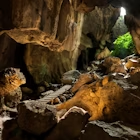
Nov 13, 2019 • 5 min read

Angkor Wat Travel Guide
Last Updated: August 30, 2023
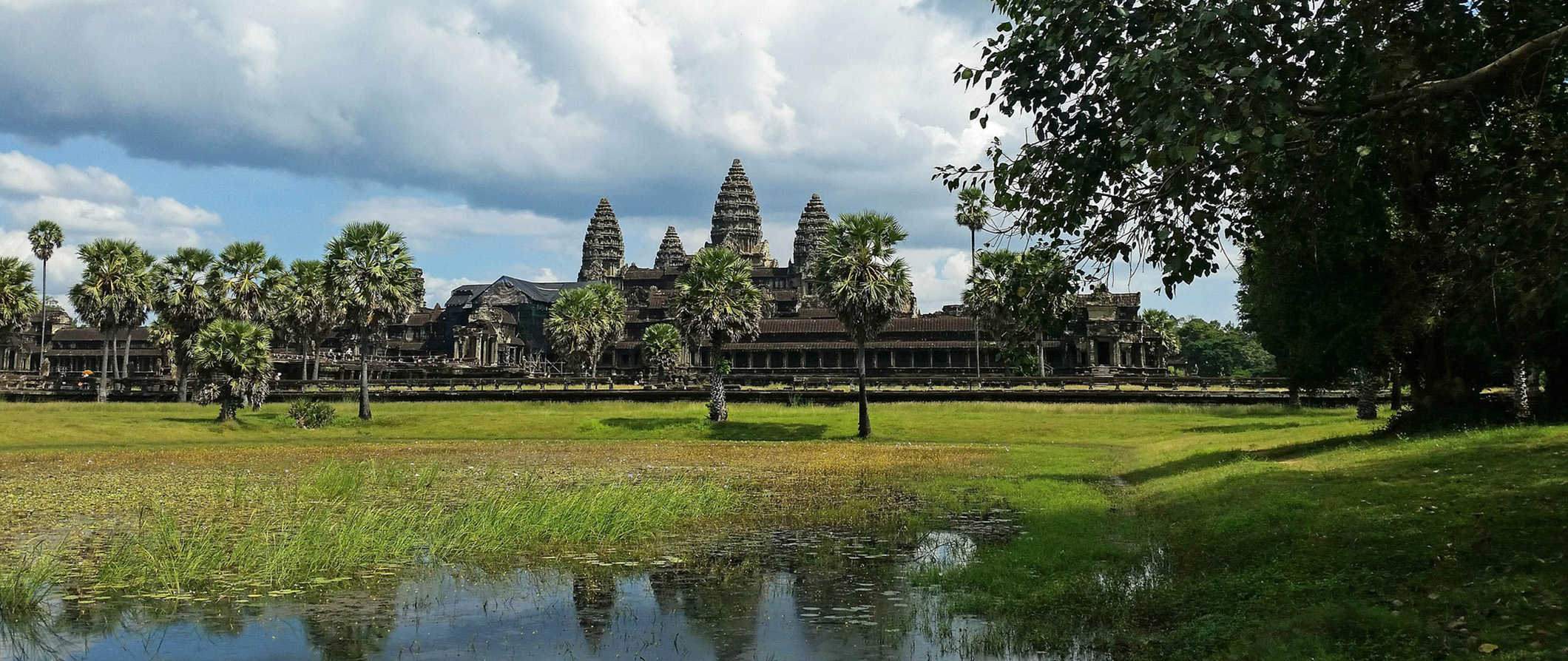
Angkor Wat is an ancient city in Cambodia that was the center of the Khmer Empire that once ruled much of Southeast Asia. This civilization went extinct, but not before building amazing temples and buildings that were reclaimed by the jungle for hundreds of years.
Angkor Wat was built in the 12th century, the surrounding complex spanning over 400 acres. It was the state temple for the empire, an empire larger than the Byzantine Empire, stretching from Thailand to Vietnam and all the way into Southern China. The temples were “rediscovered” in the 1840s and have been a popular tourist attraction ever since.
Today, the temple complex is a UNESCO World Heritage Site and though it’s always packed with tourists, the area and ruins are still breathtaking to see.
The most popular temples are Angkor Wat, Bayon, Ta Phrom, and Angkor Thom. But there are over 70 temples here so I recommend getting a multi-day pass so you can visit some of the outer temples where there are fewer visitors. There’s a lot to see!
The closest major city and launching pad for tours here is Siem Reap and the temple complex an easy day trip from the city either by bike or by tuk-tuk.
This travel guide to Angkor Wat will help you plan your visit, save money, and ensure you have the best time possible one of the greatest wonders in the world.
Table of Contents
- Things to See and Do
- Typical Costs
- Suggested Budget
- Money-Saving Tips
- Where to Stay
- How to Get Around
- How to Stay Safe
- Best Places to Book Your Trip
- Related Blogs on Angkor Wat
Top 5 Things to See and Do in Angkor Wat

1. Explore Angkor Wat
This temple was built by Suryavarman II, who ruled from 1113-1150. It’s considered the biggest Asian pyramid, standing over 61 meters (200 feet) high and divided into several layers. This temple is the largest in the whole complex and is where the historic site gets its name. The central temple complex has 792 meters (2,600 feet) of bas-reliefs.
2. See The Bayon
Built by Jayavarman VII, the temple stands in the center of Angkor Thom. With its 54 towers and 216 faces of Avalokiteshvara (a manifestation of Buddha), this temple looks best in the morning just after sunrise or at the end of the afternoon. The temple was built in three levels: the first two are rectangular, while the third is circular.
3. Step back in time at Ta Prohm
Still covered by the jungle, this place is exactly as they found it when it was rediscovered. Ta Prohm makes it easy to imagine how the whole complex looked when it was re-discovered in the 19th-century. If you come early, you can avoid the crowds that arrive mid-day. It’s the second-best complex behind Bayon in my opinion.
4. Visit Banteay Srei
This temple is located 19 kilometers (12 miles) north of Angkor. The name means “Citadel of the Women” and refers to the size and delicacy of the decoration. Unlike the major sites at Angkor, this was not a royal temple. The temple boasts exquisite decorative carvings in pink sandstone with miniature proportions.
5. Admire Ta Som
This temple has the same style, structure, and founder as Ta Phrom. It is almost like its little brother. The major feature that sets it apart is a huge tree that grows atop the eastern Gopura. It is slowly destroying the building, but it makes for amazing photo opportunities.
Other Things to See and Do in Angkor Wat
1. stroll the terrace of the elephants.
This 350-meter (1,150-foot) long terrace of elephants was used as a giant viewing stand during public ceremonies, royal ceremonies, and other events (such as viewing the returning army when they returned from war). Numerous life-size lions decorate this enormous path as well. Today, it’s surrounded by camera-wielding tourists and I found it to be one of the busiest sites here. I suggest visiting late or early to avoid the crowds, which can be overwhelming.
2. See East Mebon
Built in the 10th-century by King Rajendravarman, a huge baray (reservoir) surrounded this temple complex during its prime. Because it was encircled by water, there was no need for enclosures or moats that became customary for temples in Angkor. East Mebon has five towers — make sure to climb the central platform to the towers and check out the intricate stonework.
3. Explore Preah Khan
Preah Khan is one of the largest sites in the Angkor temple complex. Not only was this site an important temple, but it also appears to have been a large Buddhist university with over 1,000 teachers and upwards of 100,000 servants and attendants. It remains largely unrestored, as evidenced by the many trees growing around the ruins and mossy stones left laying everywhere. The site was a previous palace of Yasovarman II and Tribhuvanadityavarman, and historians believe a famous battle was fought here. There are shrines to over 430 deities here as well.
4. Climb Pre Rup
About 600 meters (2,000 feet) south of the East Baray lies Pre Rup. It was built by Rajendravarman II, who reigned from 944-968, and was his capital after re-establishing Angkor once he took over as king. Pre Rup was at the center of a city that has long since vanished. Many believe this was the place where funerals were held and was dedicated to the god Shiva. You can climb the steep steps up to the three tiers of the pyramid.
5. Go to Preah Ko
King Indravarman I built this temple, called Sacred Bull, in 879 CE, making it the first temple to be built in the ancient (and now defunct) city of Hariharalaya. The temple lies about 16 kilometers (10 miles) southeast of the main temples at Angkor and was dedicated to the king’s family as well as the god Shiva. Today, there are six small brick towers that sit atop a sandstone base. The temple derives its name from the three sandstone statues representing Nandi, the white bull of the Hindu deity Shiva.
6. Catch the sunrise at Srah Srang
Commonly known as “The Royal Baths,” this spot was once a major bathing spot for the area. The reservoir was first created in the mid-10th century by a Buddhist minister of King Rajendravarman II. It was expanded in 1200 by Jayavarman VII. It’s especially picturesque in the mornings as the sun rises over the tranquil water. Excavations have found a cemetery and necropolis nearby as well.
7. See Baksei Chamkrong
On the road between Angkor Wat and Angkor Thom is a single tower that was built by Harshavarman I (he reigned from 910-923). It’s one of the few ruins accredited to him. He had it built to honor his father who was responsible for the construction of Phnom Bakheng. The temple’s name means “The Bird Who Shelters Under Its Wings.” It’s one of the first temples in the complex built with more durable materials (bricks and laterite), with sandstone decorative elements.
8. Find the secret passage at the Terrace of the Leper King
This seven-layer terrace, built in the 13th century, is dedicated to the god of death, Yama. It earned its name as the moss growing on the statues left them discolored and looking as if they had leprosy. Keep an eye out for the secret passageway that runs from the southwest to the northwest side of the structure.
9. See the sunset at Phnom Bakheng
Built in the late 9th century (two centuries before Angkor Wat itself), this is the oldest temple here. It is both a Hindu and Buddhist temple and bears statues and symbolic elements from both religions. It was built as a representation of Mount Meru, home of the Hindu gods. Located on a hill, it’s a popular place to watch the sunset (so popular in fact, that visitor numbers are now limited during this time).
10. Stroll through Banteay Kdei
Located opposite the Srah Srang reservoir, Banteay Kdei was built in 1181 by Jayavarman VII. Its name means “Citadel of Chambers” as this used to be where Buddhist monks lived (monks lived here all the way up until the 1960s). There are three cloisters in the complex and the walls are carved with Buddhas, though unfortunately many have been defaced or have degraded over time. This complex is currently undergoing renovations, though you can still visit. This temple sees fewer crowds so it’s a good place to go to experience some tranquility.
For more information on other destinations in Cambodia, check out these guides:
- Phnom Penh Travel Guide
- Siem Reap Travel Guide
- Sihanoukville Travel Guide
Angkor Wat Travel Costs
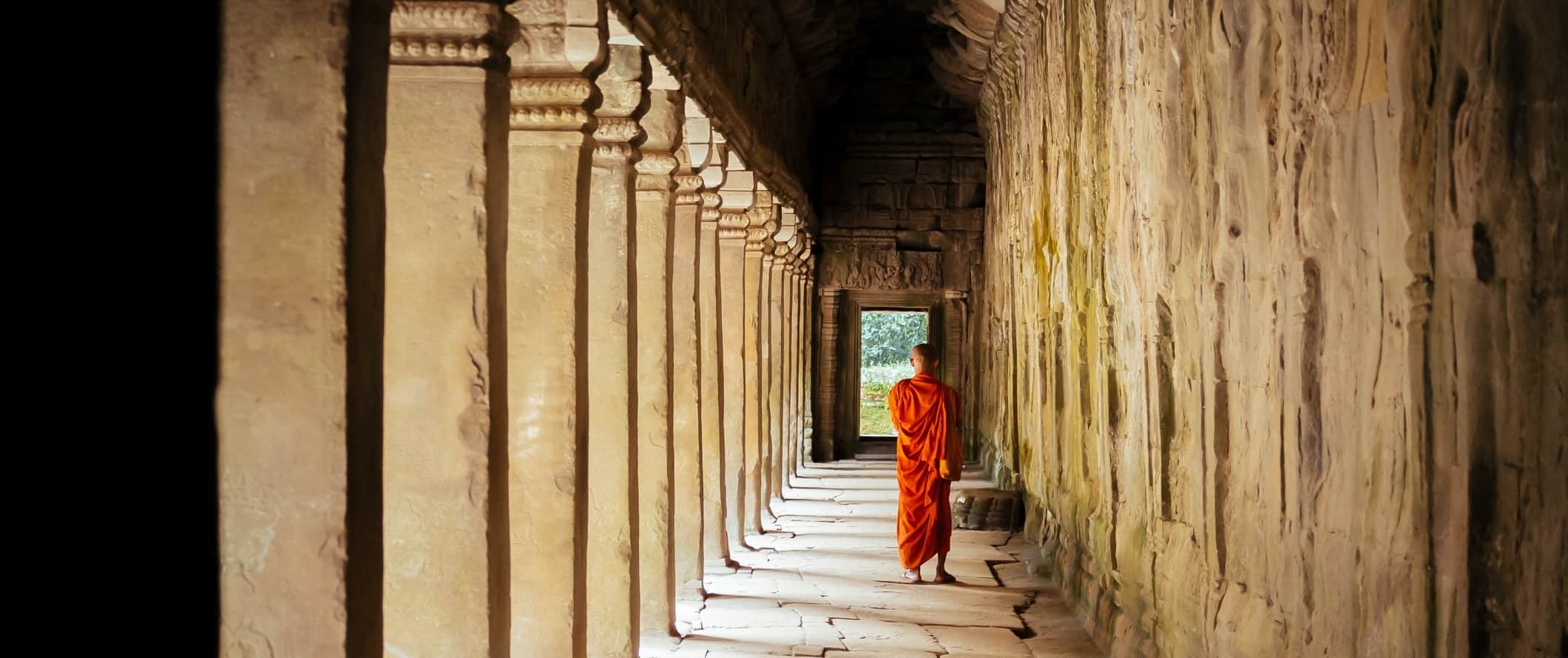
Note: Cambodia uses USD. There’s no real need to carry the local currency, Cambodian Riels (KHR), unless you’re paying for really small things on the street. In many places, especially in the countryside, you might start getting riels back when paying in USD but you can essentially get by using mostly USD here.
Siem Reap is the nearest city to Angkor Wat. That’s where you’ll be staying during your visit.
Hostel prices – A bed in a dorm with 4-6 beds costs $6-10 USD per night. Larger dorms with 10-12 beds can be found for as little as $3-4 USD per night. For a private room with an ensuite bathroom, expect to pay closer to $15-25 USD per night.
Free Wi-Fi is standard and most hostels have a swimming pool (some have multiple). None of the hostels include free breakfast or self-catering facilities, but many have a café/restaurant on-site with food available.
Budget hotel prices – A room in a guesthouse with air-conditioning, hot water, a private bathroom, and TV costs around $13-15 USD per night. For a hotel/guesthouse with a pool and a restaurant, expect to pay closer to $20 USD.
Airbnb is also available in Siem Reap. Expect to pay at least $25 USD per night for an entire home/apartment.
Average cost of food – Cambodian food is similar to Thai and Vietnamese cuisine. Vietnam and Cambodia especially have many dishes in common due to the countries’ shared history of French colonization. For example, the baguette sandwich known as bánh mì in Vietnam is called num pang pâté in Cambodia. Other popular Cambodian dishes include num banhchok , a lightly fermented rice noodle dish served for breakfast; amok trei , a fish curry dish; and samlar kako , a hearty soup filled with vegetables, roasted ground rice, and catfish or pork. In general, Cambodian cuisine includes a huge variety of noodle soups, stir-fries, curries, fried rice, and sweets.
Rice and freshwater fish are present in nearly every Cambodian meal. Lemongrass, galangal, turmeric, tamarind, ginger, chili pepper, and kaffir lime are all commonly used spices. Fermented fish paste is another widely used ingredient that adds saltiness and flavor.
Common vegetables include leaf and root vegetables as well as melon, long beans, snow peas, bean sprouts, and eggplant. Dozens of types of fruit are native to Cambodia, with durian being the most infamous. However, there are plenty of less pungent fruits to try, including mangosteen, passionfruit, dragonfruit, and mangoes. Fruit is a popular dessert and snack, either eaten alone or made into a variety of sweets.
There are tons of food options within the temple complex (though prices are higher than in the city). You can easily find restaurant meals in the $5-7 USD price range.
Around the temples are little stands with cheap meals for about $2-3 USD. There are also lots of vendors selling fresh fruit and juices for as little as $1.50 USD. They are a great choice to stay hydrated and cool down as you explore.
Angkor Wat Suggested Budgets
On a backpacking budget, you can expect to pay $60 USD per day to visit Angkor Wat. On this budget, you’re staying in a hostel dorm, eating cheap street food, limiting your drinking, and using a bike to get around the complex. This also includes a day entry to the Angkor Wat site.
On a mid-range budget of $97 USD per day, you can eat at restaurants in the complex, stay in a private room at a hostel or budget hotel, enjoy a few drinks, and hire a shared tuk-tuk driver to take you around Angkor Wat.
On a luxury budget of $247 USD per day, you can stay in a hotel or at a resort with a pool, eat out for every meal anywhere you want, drink more, and opt for a private guided tour of the site over multiple days.
You can use the chart below to get an idea of how much you need to budget daily, depending on your travel style. Keep in mind these are daily averages – some days you’ll spend more, some days you’ll spend less (you might spend less every day). We just want to give you a general idea of how to make your budget. Prices are in USD.
Angkor Wat Travel Guide: Money-Saving Tips
There aren’t a ton of ways to save money here since it’s a huge tourist attraction that draws millions of people each year. Nevertheless, here are a few of my top money-saving tips for Angkor Wat:
- Get a multi-day pass – Everyone needs a permit to enter the Angkor temples unless you are Cambodian or related to a Cambodian. A 1-day pass is $37 USD, a 3-day pass is $62 USD, and a 7-day pass is $72 USD. There’s so much to see that it’s worth getting a multi-day pass so you don’t have to rush your time.
- Rent a tuk-tuk – It’s best to rent a tuk-tuk for an entire day to get around. They know how to get you in and out of each temple as well as the best routes for the complex. You’ll be able to see more places in a day and it’s very affordable, generally around $25 USD for the day. If you split this between a group of 3-4 it becomes quite affordable. Getting a driver in Siem Reap is cheaper than inside the park. (Most hostels can help you with this).
- See the sunset the night before – If you buy your ticket after 5pm you can legally enter the park without using up your allotted days. This means you can technically enter the park and explore before it closes, and still have your 1, 3, or 7 days remaining. The best way to spend this extra time is to watch the sunset, saving the temples for the following day(s).
- Bring a water bottle – The tap water in Siem Reap isn’t safe to drink so bring a reusable water bottle with a filter to save money and reduce your plastic use. LifeStraw is my go-to brand for bottles with built-in filters to ensure your water is always clean and safe.
Where to Stay in Angkor Wat
Travelers stay in Siem Reap when they’re visiting Angkor Wat. My suggested budget-friendly places to stay are:
- The Siem Reap Pub Hostel
- Onederz Hostel Siem Reap
- Mad Monkey Siem Reap
How to Get Around Angkor Wat
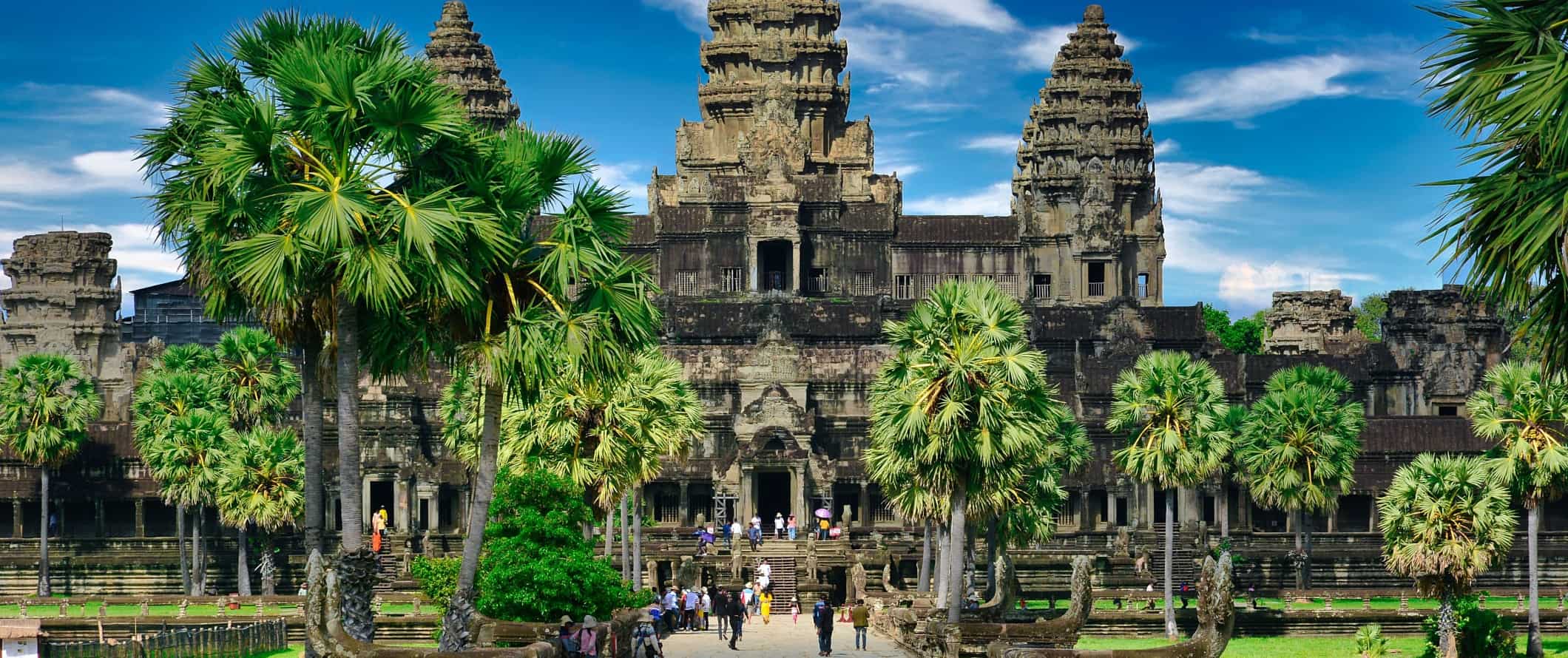
There are two ways for you to get to and from Angkor Wat (and around the complex):
Bicycle Rental – Bicycles are a great way to explore the complex, and you can find rentals for about $5 USD per day. If you choose this method, be prepared for long hours cycling in the heat.
When to Go to Angkor Wat
Angkor Wat is open year-round but no matter when you visit Angkor Wat, it’s a toss-up: either you’ll have a rainy, muddy visit with fewer people around, or great weather and crazy tourist hordes. But if you’re concerned mainly with the weather, the best time to visit is during the dry season (from late November to early April).
December and January are best for weather, but they’re also busiest months. April and May can be unbearably hot, with tons of humidity. The average daily temperature in April is 31°C (88°F).
The monsoon season lasts from late May/June to the end of October, with September and October being the hottest months. If you can time your visit to one of the shoulder months, do so.
Having a multi-day pass will give you the opportunity to plan around the weather — another reason why going for multiple days is worth it!
How to Stay Safe in Angkor Wat
Angkor Wat is an incredibly safe place to backpack and travel, even if you’re a solo traveler, and even as a solo female traveler. Petty theft (including bag snatching) is the most common type of crime here so always keep an eye on your valuables (especially bags, purses, and phones).
You may encounter persistent children trying to sell you stuff and they may even become more aggressive if you don’t shop with them. There are also many people offering to take you on a personal tour or show you the best photo spots, but these are not licensed guides. Just walk away from them saying “no thank you,” and eventually they will give up.
These are the most common scams and situations you might encounter, but if you’re concerned about others, read about these common travel travel scams to avoid here .
Avoid dehydration in the heat by making sure you bring lots of water to keep hydrated. Remember that tap water isn’t safe to drink, so bring a water bottle with a built-in filter. Wear a hat as well to keep the sun off of you. You’ll be here for hours and it can be very easy to overheat or get a sunburn.
If you experience an emergency, dial 119 for assistance.
Always trust your gut instinct. Make copies of your personal documents, including your passport and ID. Forward your itinerary along to loved ones so they’ll know where you are.
The most important piece of advice I can offer is to purchase good travel insurance. Travel insurance will protect you against illness, injury, theft, and cancellations. It’s comprehensive protection in case anything goes wrong. I never go on a trip without it as I’ve had to use it many times in the past. You can use the widget below to find the policy right for you:
Angkor Wat Travel Guide: The Best Booking Resources
These are my favorite companies to use when I travel. They consistently have the best deals, offer world-class customer service and great value, and overall, are better than their competitors. They are the companies I use the most and are always the starting point in my search for travel deals.
- Skyscanner – Skyscanner is my favorite flight search engine. They search small websites and budget airlines that larger search sites tend to miss. They are hands down the number one place to start.
- Hostelworld – This is the best hostel accommodation site out there with the largest inventory, best search interface, and widest availability.
- Agoda – Other than Hostelworld, Agoda is the best hotel accommodation site for Asia.
- Booking.com – The best all around booking site that constantly provides the cheapest and lowest rates. They have the widest selection of budget accommodation. In all my tests, they’ve always had the cheapest rates out of all the booking websites.
- Get Your Guide – Get Your Guide is a huge online marketplace for tours and excursions. They have tons of tour options available in cities all around the world, including everything from cooking classes, walking tours, street art lessons, and more!
- SafetyWing – Safety Wing offers convenient and affordable plans tailored to digital nomads and long-term travelers. They have cheap monthly plans, great customer service, and an easy-to-use claims process that makes it perfect for those on the road.
- LifeStraw – My go-to company for reusable water bottles with built-in filters so you can ensure your drinking water is always clean and safe.
- Unbound Merino – They make lightweight, durable, easy-to-clean travel clothing.
Angkor Wat Travel Guide: Related Articles
Want more tips for your trip? Check out all the articles I’ve written on Cambodia travel and continue planning your trip:

Is Southeast Asia Safe for Travelers?
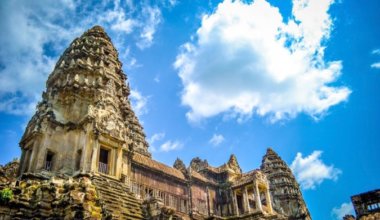
Backpacking Cambodia: 3 Suggested Itineraries for Your Trip
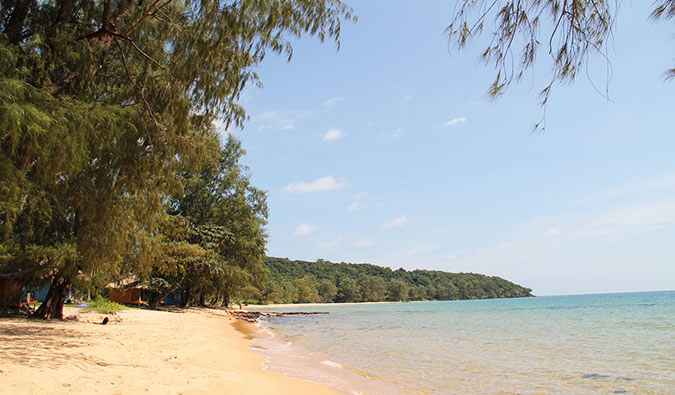
Experiencing Local Cambodian Culture on Bamboo Island
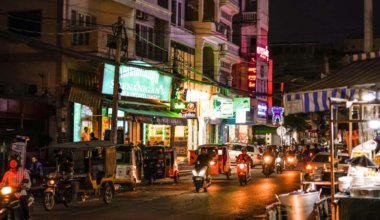
Phnom Penh, I Love You!
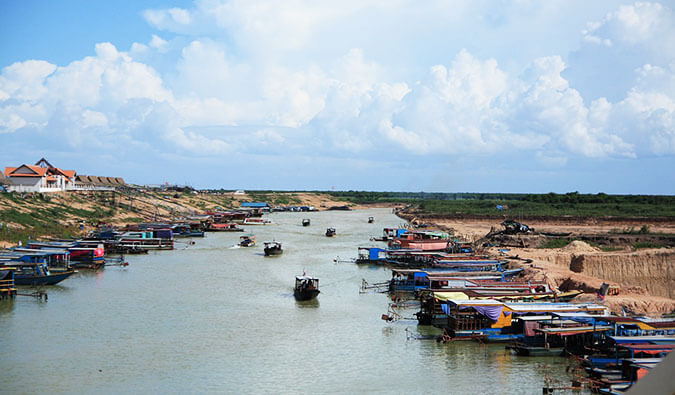
The Tragic Death of Phnom Penh’s Lake Area
Get your free travel starter kit.
Enter your email and get planning cheatsheets including a step by step checklist, packing list, tips cheat sheet, and more so you can plan like a pro!

- Where To Stay
- Transportation
- Booking Resources
- Related Blogs
The Best Time to Visit Angkor Wat
:max_bytes(150000):strip_icc():format(webp)/greg-rodgers-adventure-ed92646b25f247049e53af6d36f6c15f.jpg)
TripSavvy / Paula Galindo Valle
Choosing the best time to visit Angkor Wat can be a little tricky. You almost have to choose between rain and muddy temple sites or good weather with hordes of people who always seem to be in the way of photographs. Following the typical weather patterns for much of Southeast Asia, the best time to visit Angkor Wat in Cambodia is during the dry season from late November to early April.
Fortunately, with a little timing, you can take advantage of the best times to visit Angkor Wat. Even better, travelers who hire drivers to visit ruins farther afield get rewarded with those Tomb-Raider-Indiana-Jones photos with no other tourists in the backdrop.
Peak Season at Angkor Wat
Cambodia’s crown jewel, the ruins of Angkor Wat and the surrounding Khmer temples, lure more than two million foreign visitors per year. Sometimes you'll feel as though at least a million chose the same day as you to visit!
While rain can detract from the experience during the monsoon season, heavy crowds—also a nuisance—descend on the ruins during the peak of the dry season. Although Angkor Wat is open all year, getting good photos of the vine-strangled temples without scores of tourists clamoring around on them requires a bit of good timing. Even arriving very early in the morning is no guarantee you will enjoy tranquility at the primary temple sites.
December and January are the best-weather months, but they are also the busiest as hordes of visitors and tour buses flock to see the monuments. Peak season runs roughly from December to the end of February.
The Weather at Angkor Wat
April and May are unbearably hot months in Cambodia. Avoid them unless you can handle heat and suffocating humidity as you explore the ancient temples. During these peak-heat months, you can enjoy more personal space at temples—assuming you don't mind a heat stroke or three.
To really get the most out of your three-day-pass to Angkor Wat, consider timing your visit to coincide with one of the shoulder months between the monsoon season and dry season. November and March are often good compromise months for Angkor Wat. With a little luck, you'll still have sunny days that aren't scorching hot but fewer crowds with which to contend for photos.
Monsoon rains move in around late May or June and persist until the end of October. September and October are typically the wettest months, with more than 15 inches of rainfall, while January receives the most sunshine .
December through February are dry but are among the busiest months with tourists clamoring for photos.
Other Factors to Consider
The Lunar New Year festival (which includes Chinese New Year and Tet in nearby Vietnam) causes nearly every popular place in Southeast Asia to become extremely busy for a couple of weeks as millions of people travel during days off. Accommodation prices go up, and negotiating a better deal at hotels becomes difficult. Dates change annually , but the Lunar New Year holiday hits in January or February.
Angkor Wat is open 365 days a year, from 5 a.m. until 6 p.m. (closing time is only loosely enforced, so you can exit at your leisure until darkness falls).
Although the Angkor complex is open 365 days a year, it may be busier than usual on Cambodian public holidays. Many holidays are based on the lunar-solar calendar; dates change from year to year.
The Khmer New Year (coincides with Songkran in Thailand ; always mid-April) may not be the best time to visit Angkor Wat. Instead, enjoy the unique festivities.
More backpackers traveling along the Banana Pancake Trail in Southeast Asia tend to visit during the summer months while taking a break from school. You may not notice; Siem Reap is often in perpetual party mode.
Monsoon Season at Angkor Wat
Visiting during Cambodia's monsoon season presents several new challenges . Aside from the distinct disadvantage of having to explore the many outdoor temples in the drenching rain, roads can become rutted, muddy, and impassable during heavy downpours.
Remote temple sites may become difficult, if not impossible, to reach. Low areas turn into muddy pits, eliminating options such as biking leisurely around the area. Despite best efforts, getting photos of the memorable temples will be more difficult during torrential rains.
On the plus side, visiting Angkor Wat during the monsoon season means less competition for stairs and photos. You can still luck out with spurts of sunshine, sometimes consecutive days at a time, even during the monsoon season. Intense showers may only pop up in the afternoons, leaving you with plenty of time to explore each morning.
Additionally, mosquitoes are more of a problem during the wet season. Know how to avoid mosquito bites while traveling. Dengue fever is a problem in the area.
Events to check out:
- The Khmer New Year, also called Chaul Chnam Thmey, spans three days in mid-April. This is the most popular and festive holiday across Cambodia; celebrations include parades, festivals, fireworks, and more.
- October 15 is a national holiday commemorating the memory of His Majesty Preah Bat Samdech Preah Norodom Sihanouk. He was the ruler of Cambodia immediately after the country gained its independence from France.
Dry Season at Angkor Wat
The most popular time to visit Angkor Wat is during the dry season, which typically runs from November through March. These days are cooler and dry, but this is also the most popular time to visit, which means crowds.
Even though these months are technically "winter," temperatures are still quite warm. January, which is the coldest month in Cambodia, only sees lows of 70 F (21 C). However, despite the more mild temperatures, weather during this season can still be somewhat unpredictable. You should be prepared for unexpected rain showers or the occasional heatwave to roll through.
If you're planning a visit during the dry season, book your hotels and restaurants early. If you don't plan ahead, you might set yourself up for disappointment.
- Cambodia celebrates its Independence Day on November 9. This holiday was established to celebrate the country's independence from France in 1953.
- January 7 is another important day in Cambodian history. This day, Victory Day commemorates the end of the Khmer Rouge regime in 1979.
How Long to Spend at Angkor Wat
To visit Angkor Wat, you’ll have to purchase either a one-day, three-day or week-long pass.
Although travelers with tight itineraries in Southeast Asia try to squeeze in as many sights as they can in a day, remember that the Angkor complex is actually the largest religious monument in the world. It's spread over 402 hectares of jungle. You’re going to need more time than you think to not end up rushing around.
The temples are scattered all over Cambodia . If you're serious about exploring ancient Khmer ruins, plan on purchasing at least the three-day pass. Doing so is less expensive and troublesome than buying two one-day passes; you will end up wanting more than one day there.
The best time to visit Angkor Wat in Cambodia is during the dry season (late November to early April), however, you may encounter hordes of tourists at this popular destination.
It's best to spend at least three days exploring Angkor Wat in Cambodia. Visiting the intricate temple buildings involves climbing many stairs and trekking into the forest. You'll have the best experience if you take your time.
Plan to wear appropriate attire when visiting the sacred temples. Clothing items include long pants that cover the knee and shirts that cover the shoulders. Skirts, short shorts, tank tops, and other revealing clothing items are not permitted on temple grounds.
Radio Free Asia. "Tourist Numbers Fall at Cambodia's Historic Angkor Wat." Retrieved February 2, 2021.
Tourism Cambodia. "Angkor Archeological Park - Angkor Wat Guide." Retrieved February 2, 2021.
IAMAT. "Cambodia: Dengue." Retrieved February 2, 2021.
History.com. "Angkor Wat." Retrieved February 2, 2021.
Angkor Wat in Cambodia
Traveling to Cambodia: Essentials to Know
Where Is Angkor Wat?
February in Asia: Weather, What to Pack, and What to See
The Best Time to Visit the Maldives
A Beginner's Guide to Siem Reap, Cambodia
Cambodia Guide: Planning Your Trip
Top UNESCO World Heritage Sites in Southeast Asia
The 13 Best Things to Do in Siem Reap
Vital Information for the First-Time Visitor to Thailand
Phnom Penh, Cambodia Guide: Planning Your Trip
Buddhist New Year Celebrations in Southeast Asia
January in Asia: Weather, What to Pack, and What to See
The Best Time to Visit Japan
What $100 Can Get You in Southeast Asia
Winter in Asia: Weather, What to Pack, and What to See
- Search Search Search …
- Search Search …

Angkor Wat Guide [Visit Independently + on a Tour]
We’ve visited the temples of Angkor twice now. We’ve visited Angkor Wat independently, and we’ve also explored Angkor Wat on a 2 day tour. We’ve seen sunrise here, and we’ve seen sunset at Angkor. While we learned a lot on our first visit, traveling independently, hiring our own tuk-tuks, and finding a guide at the entrance, our experience the second time was much deeper and informed. This is not a difficult place to visit, it can (and will) be busy. Millions of people visit Angkor every year. So our Angkor Wat guide looks at how to try and avoid crowds, making sure you don’t miss the highlights, and ensuring that you’re in the right frame of mind when you do get there. It’s easy in the sweltering heat of Cambodia to get exhausted and fed up. But Angkor is worth it. Ready?
THIS POST MAY CONTAIN COMPENSATED AND AFFILIATE LINKS MORE INFORMATION IN OUR DISCLAIMER
TOP WAY TO VISIT

Angkor Wat 2-Day Tour with Sunrise
Discover the temples of Angkor, representing 600 years of Khmer civilization. Learn about one of Asia’s greatest kingdoms from your historian guide and see major temples including sunrise & sunset.
Head out for a wonderful and informative time – but book early.
In 2024, a one day ticket costs US$37, a 3 day ticket US$62 and it is US$72 for 7 days. A few years ago on our first visit here, we bought the one day ticket, we toured independently, and at the end of the day, we agreed we needed more time. It took us some time to get back here, but we did and on our second visit, we opted for the 3 day ticket and also a 2 day guided tour which explained so much that we had entirely missed on our first visit.
The Best Way to See Angkor Wat
The best way to explore Angkor Wat and Angkor Complex is going to depend on how interested you are. You can pick up a tuk-tuk from your hotel that will rush you around to the main places to take a photograph if that’s what you’re interested in. You can get a guide at the entrance. You can rent a bicycle and spend an entire week here, or longer if you want. So you’ve got to decide what your interest level is.
If you’re coming here because you want a visit that educates, entertains, and gets you to the key parts of the Angkor Complex, then I recommend this specific tour from Journey Cambodia . It’s a small group tour. Our guide was one of the best that we’ve had in 10 years of traveling. I’ll explain what we saw, how our guide enhanced the visit, and also what our experiences were in visiting the first time when we picked up a guide at the entrance for an hour only as I go through this article.
Let’s start with an explanation of what you’re seeing around here.
What is Angkor Wat?
Angkor Wat is a Hindu-Buddhist complex of temples in Cambodia. More correctly termed the Angkor Wat Archeological Complex, Angkor Wat is the temple complex, that is located within the ancient Khmer city of Angkor. However, the term Angkor Wat is generally used to describe a single temple, the temple complex, and also the area around and near both of them.
The area in question covers 1,626,000 square meters or 402 acres, but in the past, the nature of Khmer building and settlement meant that it was low density and dispersed, so there’s an area of at least 1,000 square kilometers (390 square miles) that extends beyond the major temples covered in this guide to Angkor Wat. This area encompassed roads, canals, and general infrastructure. The area covered by Angkor Wat’s UNESCO World Heritage listing extends to 400 square kilometers (154 square miles)

The area that you’ll visit at Angkor, the complex of Angkor Wat is the largest religious monument in the world. The city was the capital city of the Khmer Empire, which ruled from the 9 th to the 15 th century. At its peak, the ancient city used to be home to more than a million people. The empire fell in 1351 to Ayutthaya (our guide to Ayutthaya is here ) and was sacked in 1431. When Angkor started to decline the royal court was moved to Phnom Penh, Cambodia’s current capital city (our guide to Phnom Penh is here )
Your ticket to Angkor Wat gives you access to the temples, and the Archeological Complex of Angkor Wat, which was inscribed on the UNESCO World Heritage list in 1992.
What’s at the Angkor Temple Complex?
You will find the remains of different capitals of the Khmer Empire from the 9 th to the 15 th centuries, including all the major temples of Angkor and also moats, forests, and canals. Some villages are still inhabited, and they do sit within the wider temple complex. There are agricultural areas and rice cultivation. But you likely won’t want to or need to see all of that.
The major temples that you’ll want to see are
- The famous famous Temple of Angkor Wat
- Angkor Thom
- Bayon Temple
- Banteay Kdei
What to See at the Angkor Wat Temple complex
Regardless of whether you visit the Angkor complex independently or on a tour, there are some key temples and areas that you’ll want to see. I’ll go through these in order of importance to the general visitor.
The Temple of Angkor Wat
This is the famous temple that you see in the first photo in this article. It’s what you see on all the promotional materials for Angkor Wat.
This is the centerpiece of the Archaeological complex. If you see just one temple at Angkor it should be this one. This is also the temple to see sunrise at Angkor.
Angkor Wat is the earthly representation of heaven. Each of the Cambodian kings strove to outdo each other by building temples. No one lived in these temples, they were simply for worship. The culmination of the temple building was Angkor Wat – it’s the world’s largest religious building. The temples in this area (the old capital of Angkor) were built during the period 802AD to 1432.
This is the temple that you’ll want to see at sunrise ( we saw it at sunrise on this specific tour with Journey Cambodia – the tour was great, but the sunrise was not so much).
The first time I saw Angkor Wat, I wasn’t that impressed. We’d arrived around 09:00 and it was seriously hot (yes already) humid and crowded. Perhaps it was the heat. Perhaps it was that there were a fair few people, but my first impression wasn’t jaw-dropping. It was more a little “Oh, that’s it then”.
This wasn’t a Great Wall of China moment.
It became more impressive as we got closer.

The construction really is quite incredible, considering when it was built. It’s amazing how the temple lines up perfectly along compass lines, oriented perfectly to the west. The temple of Angkor measures a perfect square kilometer and has three terraces, which are capped by five lotus-shaped towers. The temple is surrounded by a moat and an exterior wall. The wall measures 1.3 kilometers by 1.5 kilometers.
The towers are typical Khmer architecture and they represent Mount Meru, the home of the gods in Hinduism. The Angkor people were Hindu until the end of the 12 th century when they transitioned to Buddhism.
Unlike the other temples, Angkor Wat was never abandoned to the jungle after the city was sacked by the Ayutthayans and abandoned to the jungle from the early 15 th century. It was mentioned by several visiting Europeans. Antonio da Madalena, a Portuguese friar was here in 1586, there were Japanese settlements here in the 17 th century and Angkor was shown to Europeans who visited.
Even then it was a working monastery and temple.
However, it was the French we have to thank for “re-discovering” Angkor – in the 1860s. Although the Portuguese had also first “discovered” it in 1614. To cut a long story short about different explorers discovering Angkor, the first foreign tourists arrived in 1907.
And then, again, it was the French who began a long restoration process – from 1907 to 1970 the forest was cleared, drains were installed and work was undertaken to protect the buildings from water damage. This stopped in 1970 because of the Cambodian Civil War and the Khmer Rouge (read more about that in our guide to the Killing Fields of Phnom Penh here ).
And, getting back to Angkor Wat.
As well as what I’ve mentioned above, Angkor is famous for sunrise and for its apsaras – that’s heavenly nymphs to you and me.

There are more than 3,000 here, sporting 37 different hairstyles and very shiny breasts. That’s from centuries of visitors trying to rub some good luck onto themselves. Or that’s the myth anyway.
If you’re going to visit Angkor Wat independently, then I recommend buying a specific guidebook about the temples, rather than just a chapter in a Rough Guide or Lonely Planet. I’d recommend
Moon Angkor Wat , or
The Pocket Siem Reap and the Temples of Angkor.
They haven’t been updated in recent years, but you know, to be fair, the temples haven’t had many updates since 1431 either…
The second most popular temple to visit at Angkor is Ta Prohm. Yes. This is the Tomb Raider temple . It’s time to embrace your inner Lara Croft. Yes, Ta Prohm is also known as the Angelina Jolie temple.
Much greener and less manicured than Angkor Wat, Ta Prohm is in an almost arrested state of decay.
Tumbledown blocks seem to be held sometimes almost by magic. Incredibly Ta Prohm was built without mortar and the tree roots curl impossibly in, under, and around buildings.

Your mind imagines them growing, reaching out, and including you in this macabre tableau of decay. They are giant snakes, not solid immovable trunks. They’re very much alive and they’re coming to get you. Moss covers almost everything.

It was Jayavarman VII – the first Khmer king who was devoted to Buddhism – who started the expansion program in Angkor in 1186. Ta Prohm (which stands for Ancestor Brahma) was one of the first temples constructed in this plan. Over the 37 years of his reign, Jayavarman is generally credited with introducing a welfare state for the Khmer people and constructing buildings that included hospitals and rest houses as well as temples. Bayon Temple and Angkor Thom also date from this period.
Ta Prohm was known as the monastery of the king or Rajavihara and the temple was built in honor of Jayavarman’s family, with various areas of the temple dedicated to his mother, father, elder brother, and guru.
When the Khmer Empire fell in the 15 th century, Ta Prohm was abandoned. Even when the French began to restore the Angkor Wat temple it was decided that Ta Prohm would be left in an arrested state of decay. It was felt that Ta Prohm was the temple that had best become at one with the jungle, but not yet part of it. The restoration that has occurred has been primarily to prevent any further decay but also to minimize the effect of visiting tourists on the temple.
As you visit, right from the start, there’s an incredible atmosphere. Each time we visited there were lots of people here and yes it was hot. But somehow there’s still the feeling that the jungle is in control.
And it is possible to get away from the crowds. To find a quiet corner. To take a photograph with no people in it. And yes, even a moment of silence or two.
Angkor Thom and the Bayon Temple
Angkor Thom is the name of (another) ancient city within the area of Angkor, in which there are a series of temples, the most famous of which is the Bayon Temple. Angkor Thom was also built by Jayavarman and it was both his capital and the longest enduring of the Khmer capitals.
The city of Angkor Thom covers an area of 9 square kilometers (3.5 square miles), and at its center is the Bayon Temple. The name Angkor Thom means “Big” or “Great” City” (Angkor means city, and Thom means big). Angkor Thom was the Khmer capital when the area was sacked by the Ayutthaya kingdom, and that’s when the capital moved to Phnom Penh.
The walls around the city are 8 meters (26 feet) high and both the walls and the moat that surrounds them are 3 kilometers (1.8 miles) long. You’ll find a gate to Angkor Thom at each of the cardinal points – north, south, east, and west. There is a further gate, a fifth one, called the Victory Gate, which is 500 meters (1640 feet) north of Angkor Thom’s east gate.
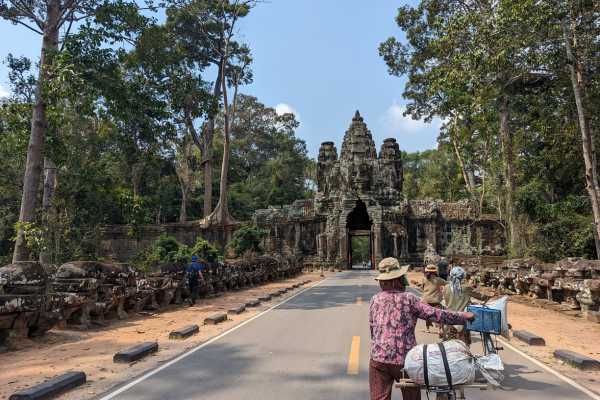
At the center of the ancient city is the Bayon Temple, which was the city, or state temple of Angkor Thom. Interpretively, Bayon is Mount Meru, and the city and the moat are the oceans and mountains that surround Bayon.
You’ll definitely want to visit here for a number of reasons. The first is the causeway and bridge across to the south gate.
The South Gate Deities of Angkor Thom aka the Churning of the Sea of Milk
You will most likely enter Angkor Thom via the South Gate. If you don’t, make sure you leave by it, as this causeway is spectacular. Although it looks like a bridge it’s technically a causeway as the water doesn’t flow underneath it.
As you approach the south gate of Angkor Thom you’ll see what looks like a bridge. And if you look closely you’ll see carved images on the walls on either side. These are Hindu images representing a Hindu myth, the Churning of the Sea of Milk. And the images are different on either side of the pathway.
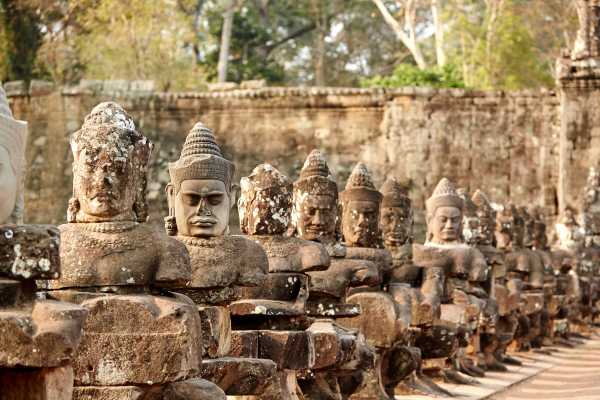
As you approach the south gate, on one side of the causeway (which does look like a bridge) you’ll see 54 devas (or guardian deities) which are pulling the head of a naga or mythical serpent. On the other side, there are 54 asuras (demon gods) which are pushing the tail of the serpent. In this Hindu creation myth, the whipping motion of the body of the serpent churned the ocean and recreated the cosmos. Those apsaras that you saw at Angkor Wat? They were the first beings to emerge from this sea of creation.
Angkor Thom’s Terrace of Elephants.
Inside the walled city of Angkor Thom is another spectacular place to visit – a 350 meter (1150 feet) long viewing platform named “the Terrace of Elephants”. Stories vary as to what this was used for – it may have been where the King viewed his victorious returning army. It may also have been the base where public complaints were listened to by the King.

The elephants are carved in bas relief and there are also carvings of life-sized garudas (a bird-like deity with the body of a human and the wings and beak of a bird) and lions.
Bayon Temple
Bayon Temple is the temple in the center of Angkor Thom. It was also built by Jayavarman VII. The Bayon Temple has 54 gothic towers that display more than 200 stone faces and these faces and the more than 11,000 figures display a combination of what everyday life was like here in the 12 th century as well as historical tales of the time.

Bayon is known as the temple of the faces. But it’s most well-known among visitors for its great views of the surrounding jungle and for this reason alone, it is ALWAYS busy. It looks glorious in the early morning or late afternoon sun,
The temple was originally built for Buddhist worship, but it was later renovated as a Hindu Temple.
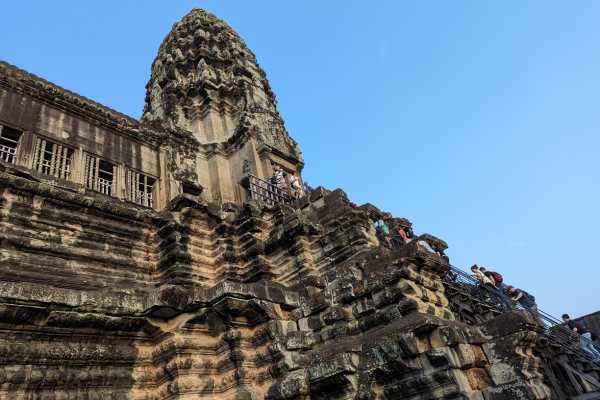
Pre Rup Hindu Temple
This 10 th century Hindu Temple means “turn the body” – the name comes from a common Cambodian belief that there were funerals conducted here, with the ashes of the deceased rotated in different directions throughout the ceremony. The temple was dedicated to the Hindu God Shiva and is on an artificial island in one of the reservoirs of Angkor.

There’s a lot of red brick used in the construction and it looks lovely in early or late light.
You’ll notice the three spires of Pre Rup – and it’s kind of like a miniature Angkor Wat.
To the northeast of Angkor Thom is the temple that Jayavarman VII built to honor his father, Preah Khan. It’s very similar to Ta Prohm, with a state of arrested decay, although you can wander right inside some of the terraces and it does feel rather like some of them might fall on you!
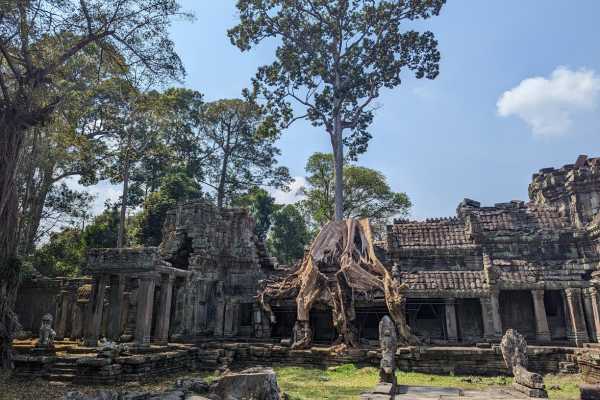
The site of Preah Khan is the location of the battle that Jayavarman VII had with the Chams in 1191. He was victorious. The name Preah Khan translates to “Holy Sword”

Banteay Srei
Another 10 th century temple, this has to be my favourite of the temples at Angkor. It’s quite a distance away from the main temples, some 25 kilometers (16 miles), but you’ll usually find fewer people here (yay!). You’ll probably only get to Banteay Srei if you take a 2 day tour, like this one that we took .
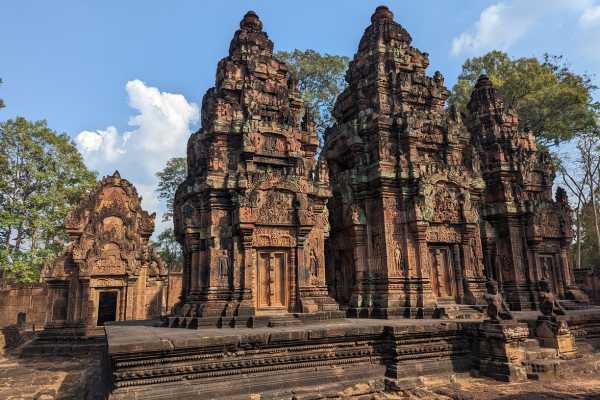
The detail and carving are spectacular. While tourists have been visiting Angkor since the French rediscovered the temples in the 1900s, Banteay Srei has only been open to the public since the Khmer Rouge left the area in the 1990s.
Banteay Srei is carved mostly from hard red sandstone, which can be carved like wood, and compared to the other temples, this is a tiny temple. The lintels and pediments (the triangle bit at the top of a doorway) are gloriously and ornately carved.
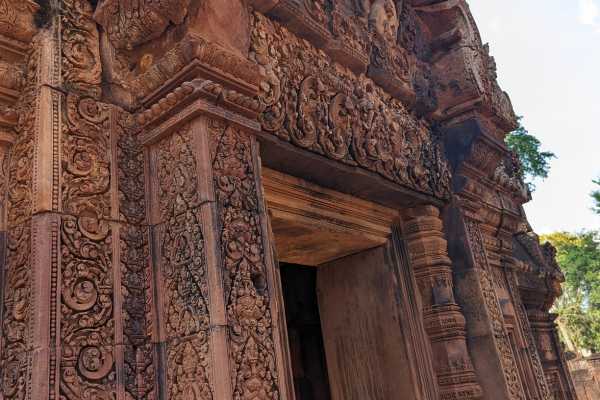
This temple is unusual as it was built not by the rulers, but by a couple of courtiers and its name translates as “Citadel of the Women”, or sometimes “Citadel of Beauty”. And it is a beauty.
Phnom Bakheng.
If you’re planning on seeing Angkor Wat at sunset, then the best place to see a sunset is Phnom Bakheng. Some tours, like this one , include stopping at Phnom Bakheng in your tour. On our first visit here, our tuk-tuk drivers didn’t include staying this late, but we paid them extra to stay while we watched the sunset and rode back in the dark. You’ll want to pre-arrange a ride back to Siem Reap if you want to see the sunset here, as you’re unlikely to find a driver just waiting around for a fare.
Phnom Bakheng is the oldest temple in the Archaeological Complex, built in the 9th century, it has symbols from both Hinduism and Buddhism and again represents Mount Meru. You’ll leave your transport at the bottom of the hill and need to walk up the wooded, paved slope, to get to the temple.
Numbers are limited now to around 300 people, to protect the structure AND the visitors.
Seeing Angkor Wat at Sunrise
The best place to see Angkor Wat at Sunrise is the “Reflecting Pool” in front of Angkor Wat. And despite all those photos on Instagram and other social media sites, you won’t have it to yourself. The Angkor Wat complex opens at 05:00. The time of sunrise at Angkor Wat varies from 05:30 to 06:30 depending on the time of year that you visit.

If you’re taking a tour that includes sunrise then you’ll get there in plenty of time. If you’re traveling independently, then you’ll need to leave your hotel in Siem Reap around 04:45, but you can check the sunrise times for Angkor Wat here. Note that you’ll see the sunrise times for the city of Siem Reap, which is the closest city to the complex. Our guide of what to do and where to stay in Siem Reap is here.

Seeing Angkor Wat at Sunset
The most popular place to see sunset at Angkor Wat is Phnom Bakheng. It is inside the Angkor Complex, so you do need your ticket to enter here. If you’re touring independently, then you’ll need to have transport arranged to go back to Siem Reap. It will be dark when you leave, and there’s a mass exodus from the park after sunset. It’s not a pleasant bicycle ride at this time.
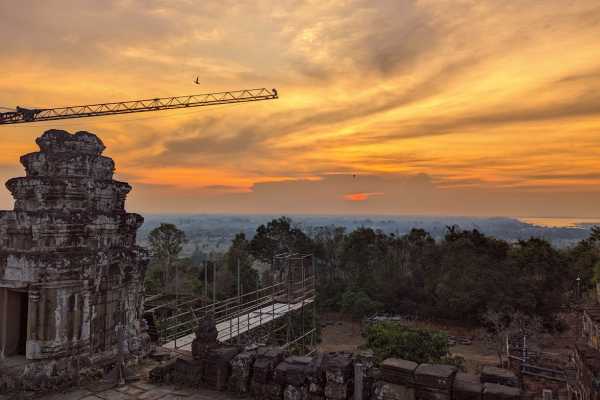
There is a limit to the number of people who are allowed onto the temple platform, so you’ll want to get here about 30 minutes before sunset if not earlier. If you’re taking a tour, then check if this is included. If not, then you can have your guide arrange transport back and just pay cash for the ride back to Siem Reap. It’s usually a one-off cash payment of about US$4 per person.
FAQ about Visiting Angkor Wat
Here are the questions that we get asked about visiting Angkor Wat – don’t forget if you have a question about how to explore Angkor Wat you can send us an email, or ask in the comments below and we’ll answer for everyone else to see.
What is the Angkor Wat entrance fee?
You can buy different tickets to visit Angkor Wat. You can buy online ( here ) or buy a ticket at the entrance to the Archeological Park. You’ll need to decide how many days you want to visit.
- A one day Angkor Wat ticket is US$37
- A three day Angkor Wat ticket is US$62
- A 7 day pass to Angkor Wat costs US$72
You can buy with cash OR cards at the ticket office now.

What does Angkor Wat mean?
The name Angkor is derived from nokor (នគរ), a Khmer word meaning “kingdom” which in turn derived from Sanskrit nagara (नगर), meaning “city”. [3]
When is the best time to visit Angkor Wat?
It’s best to visit Angkor Wat in the dry season, which is between November and March.
How do I buy tickets for Angkor Wat?
You can ONLY buy tickets for Angkor Wat either at the entrance gate or online at the official site here .
How big is Angkor Wat?
The Angkor Wat complex measures 1,626,000 square meters, or 402 acres. The specific Angkor Wat Temple measures 215 x 187 meters (705 x 614 feet), but the moat around it is 5 kilometers (3 miles) long and the outer wall around this specific temple is 3.6 kilometers (2.2 miles) long.
Is one day enough to visit Angkor Wat?
If a day is all you’ve got, then it’s enough to visit Angkor Wat. Don’t NOT visit because you can only spare a day. I recommend two days to visit Angkor Wat. Make them long days – and see Angkor at sunrise AND sunset.
How many days do you need to visit Angkor Wat?
I think two days is a good amount of time to visit Angkor Wat. You can buy a three day ticket, which means that if you bump into too many people, or the weather is bad, or you just can’t deal with the heat of the jungle, you can come back for a 3rd day.
What to wear in Angkor Wat?
There’s a specific dress code at Angkor Wat. This entire complex is a religious monument, one of the most important in the world. You need to wear clothes that cover your shoulders and knees. Although there is shade between a lot of the temples, when you actually are exploring the temples, there isn’t much shade. So bring a sunhat. Or an umbrella, which is my favorite way of avoiding the sun in Asia. (and yes it comes in handy for downpours too).
And you’ll need decent walking shoes, you’re going to be covering a lot of ground. Even if you’re taking a guided tour that provides transport between the relevant temples.
Is Angkor Wat open 7 days a week?
Yes. Angkor Wat is open 7 days a week. It’s open 365 days a year, including all national holidays. Opening hours depend on the temple. Most Angkor Wat temples are open from 07:30 until 17:00, but several are open for sunrise and sunset.
Which Angkor Wat Temples are open for sunrise?
Angkor Wat, Srah Srang, Pre Rup, and Phnom Pahkeng temples are open for sunrise (which means 05:00)
Which Angkor Wat Temples are open for sunset?
The Pre Rup and Phnom Bakheng temples are open for sunset, which means until 19:00
Angkor Wat Map of Temples
You can see the full map of Angkor Wat temples here.

Travel Tips for Exploring Cambodia
- Considering travel insurance for your trip? World Nomads offers coverage for more than 150 adventure activities as well as emergency medical, lost luggage, trip cancellation, and more .
- Get online immediately with an eSIM for Cambodia
- Download and install a VPN BEFORE you travel to Cambodia > discount coupon here
- Arriving by air? Book your airport transfer with Welcome Pickups here.
- Book the best Cambodia tours and guides on Get Your Guide
- Save money in Cambodia with a Wise debit card
- Read about getting around Cambodia in our guide to Cambodian Transport
- Book Buses in Cambodia with 12goAsia
- Book accommodation in Cambodia with Booking
Final Words in Our Angkor Wat Guide
The temple complex at Angkor Wat is spectacular. It is vast and full of history. A visit here is incomparable. And we’ve seen a lot of temples in our time. So whether you come to Angkor Wat for one day or longer, whether you take a tour, or whether you visit independently, just come. And explore. It’s a stunning place to visit.
We receive a fee when you get a quote from World Nomads using our affiliate links. We do not represent World Nomads. This is not a recommendation to buy travel insurance.
ASocialNomad is a participant in the Amazon Services LLC Associates Program, an affiliate advertising program designed to provide a means for sites to earn advertising fees by advertising and linking to amazon.com, amazon.co.uk, and amazon.ca. Amazon and the Amazon logo are trademarks of Amazon.com, Inc. or its affiliates. As an Amazon Associate, I earn from qualifying purchases .
Sarah Carter
Leave a comment cancel reply.
Your email address will not be published. Required fields are marked *
Save my name, email, and website in this browser for the next time I comment.
Privacy Overview
- Siem Reap Guide
- Angkor Temple Guide
- Travel Guide
- Living Guide
- Cambodia Guide
- Sightseeing & Nature
- Tours & Activities
- Body, Mind & Soul
- News & Events
Hours & Admission
Public holidays in cambodia in 2024, siem reap – angkor international airport (sai): a comprehensive guide to the new airport, angkor visitor code of conduct, siem reap’s best souvenir & night markets to visit in 2024, top experiences for the adventurous in siem reap, the best places to shop for unique gifts and souvenirs in siem reap, top 10 activities for children in siem reap (updated in 2024).
Unless you are a Cambodian resident, an admission pass, often called Angkor Pass , is required to visit the temples in Angkor Archaeological Park. The Angkor Pass is also valid for some other monuments in the Siem Reap area, like Phnom Krom , Wat Athvea, Kbal Spean , Beng Mealea and the Roluos Group .
Where to Buy the Angkor Pass?
The Angkor Pass can be purchased at the official ticket center , located 4 km away from Siem Reap town and open from 4.30am to 5.30pm every day.
The entrance ticket can be paid in cash (US Dollars, Cambodian Riel, Thai Bath, Euro) or by credit card (Discover, Visa, Mastercard, Union Pay, JCB, Diners Club). An on-site ATM is available to withdraw cash.
You can purchase your entrance ticket upfront only via online purchase. Entrance tickets for a one-day visit are issued up to 5pm, tickets issued after 5pm are valid for the next day.
The Angkor Ticket Office is located on Road 60. Consult this Google Map for the exact location. When you book a taxi or tuk tuk driver for the day, he will bring you to the ticket office before entering the park.
Since 2019, it is also possible to purchase an Angkor Pass online . Once paid by credit card (Visa, Mastercard, Union Pay, JCB) , a valid ticket can be downloaded immediately, which can be shown in digital or printed form at any checkpoint within the Angkor Park.
Entrance Fees
The entrance fee to the Angkor Archaeological Park depends on the type of admission pass that you choose. There are 3 types of passes available:
- 1-day pass – US$ 37;
- 3-day pass – US$ 62;
- 7-day pass – US$ 72;
The 3-day pass is valid for 10 days from the issue date, the 7-day pass is valid for 1 month from the issue date. So with both of these passes it’s not necessary to plan your visits on consecutive days.
Good to know is that the entrance fee includes a US$ 2 contribution to the Kantha Bopha Children’s Hospital fund .
Visiting Hours
Most of the temples in the park can be visited from 7.30am – 5.30pm , but there are exceptions:
- Angkor Wat and Srah Srang can be visited from 5am – 5.30pm , to make it possible for visitors to witness the sunrise;
- Phnom Bakheng can be visited from 5am – 5.30pm , to make it possible for visitors to witness both the sunrise and sunset;
- Pre Rup can be visited from 7am – 5.30pm
Good to Know
- Admission passes are not refundable.
- Passes bought online can be use as soft copy (photo on smartphone).
- Admission passes are not transferable. The pass owner’s name and photo are printed on the ticket.
- Children under 12 years old are not required to purchase an entrance ticket. A passport needs to be shown as proof.
- The admission fee does not include special permits for commercial picture taking or film shooting.
- Do not hesitate to have a Angkor Wat Tour Guide. It change your perspective.
- The admission fee is non-negotiable. There are no discounts for groups.
- Phnom Kulen National Park cannot be visited with an Angkor Pass. It requires a separate admission pass.
- Koh Ker temples also require a separate admission pass, which costs US$ 10.
- There is no “Angkor Elderly Pass” available for visitors to the Angkor Archaeological Park. The park offers standard passes that apply to all visitors, regardless of age.
Suggested Itineraries
Getting around angkor, 100 comments.
Hi, my daughter just turned 12 years old. Her date of birth is in may 2005. Can she be considered as a free visitor or must I buy an adult ticket for her? Thanks.
Unfortunately, I think she will be considered as an adult visitor if she turned 12 earlier this month. But it’s best to double check this with the official ticket center.
Hi, I would like to know if Ankor wat opens every day. I will visit it in january 3th, it is on thursday. Thanks!!!
Hi! Yes, Angkor Archaeological Park (including Angkor Wat) is open every day of the year. 🙂
Can we carry DSLR and Drone (DJI ) for personal photography ? does this needs an extra amount to be paid ?
Good question! DSLR’s are allowed, but unfortunately you’ll need a license to fly your drone in Angkor Archaeological Park. From what we’ve heard it’s very difficult / expensive to obtain a drone license.
Yes, you can carry the DSLR. But first you need to buy a drone to fly
Hi, how much in Riel?
Hi Colleen, I’m not sure if it’s possible to pay in Riel, but if so, take the ticket price in dollar and multiply with 4000 to have a good estimate.
Okay. Thanks! Can we enter the Angkor Wat temple already at 5:30am? To go to the other side (East gate) of the temple? Thanks again!
Yes, that should be possible!
I’m from Cambodia and married with a Norwegian. She has my last name. Also all of my children. Are they required to buy entrance?
I think they can only enter for free if they can show a Cambodian ID card or passport.
Hi, can I know exactly which temples i can enter with the Angkor Day Pass? Thank you.
Hi, there’s too many to list them all, but all the temples in Angkor Archaeological Park, including Banteay Srei. You can also visit some temples outside of the park with the Angkor Pass, like Wat Athvea, Phnom Krom and the Roluos Group.
My wife and I will be staying in Siem Reap for 10 nights in November/ December 2018 and intend to buy a 7 day Angkor Wat Admission pass. Can someone please tell me: Can I buy the 7 day pass the day before I first want to visit the temples or does the day we buy the pass have to be our first days visit? Do I have to go back to the ticket office each day to get the ticket validated for that day or are they validated for each day when one enters a temple? The ticket office looks large with many paying counters. Is the a particular counter to buy a 7 day ticket? If so can you tell me the number of the counter I need to head for? Thanks for your help
Hi, I think it’s possible to buy the pass up front, but there’s really no need. It shouldn’t take more than 5 to 10 minutes to purchase the pass, especially the 7 day pass, which is available from a different counter than the 1 day pass (the most popular one). I don’t know the counter number, but it’s very easy to find as there will be a sign saying “7 day pass” with the price in USD. Once purchased, there’s no need to go back to the ticket office. Your pass will be validated at the check point every time you enter the park (and at most major temples).
I seem to recall there was a temple that our children (5yo & 9yo) were not permitted to enter/climb with us. I know they are restricted in the upper levels of Angkor Wat, but this was another one. Can you confirm which temple this is?
Interesting question! Could it have been Baphuon? This temple is pretty difficult to climb and it makes sense that they wouldn’t allow children to climb to the top.
I’ll arrived at SR at 22:45 and with have only the next day to see the temples. Can I purchase in the morning for the same day a pass for a single day? Not sure what I read here: You can’t purchase your entrance ticket upfront. Entrance tickets for a one-day visit are issued up to 5pm, tickets issued after 5pm are valid for the next day.
Yes, you can purchase your ticket in the morning and enter the park straight away.
Hi, I have a question about 1-day pass. I’ve heard it’s possible to buy it online? And, is it possible to re-enter Angkor within the same day – ie, first we visit Angkor early morning (6am-12am), then go to the hotel, and return to Angkor 2-6pm?
Hi, it’s not yet possible to buy your tickets online. Angkor Enterprise is currently working on an online system, which should be ready later this year. At the moment, you can only buy your tickets at the Angkor Ticket Office, upon entering the park. You can either pay in cash or with credit card. As for your second question, yes, it’s possible to visit some temples, leave the park and return afterwards. Your ticket is valid for the whole day. Have a great trip!
Hi, I have a question regarding one day ticket. I’m going to have a very limited time to see Angkor, I will be at the ticket center one day at 5pm an I have time to visit up do 1pm next day. I would like to use bike to see at least a part of the temples. If I would buy one day ticket after 5pm of the first day would it let me to use it at the same day till the dawn and at the next day from the morning till 1pm? Thanks in advance for you help
Hi Lukasz, yes you can enter the park after 5pm with a valid ticket for the next day. But it’s important to know that (with the exception of Pre Rup and Phnom Bakheng), most temples close at 5.30pm. This is strictly enforced at Angkor Wat, at other temples the security is usually more flexible.
I’m a Foreign student in Cambodia and I have student ID from my Uni. Am I still required to buy an entrance?
Yes, all foreigners are required to pay the entrance fee.
Hi. I have a question about the 3 day pass, can I buy it a day in advance? And if I buy it after 5pm the previous day can I also enter the park on the same day when the ticket was bought to see the sunset (as with the 1 day admission ticket?). Thank you for your help
Hi Katja. Yes, you can buy the 3-day pass the evening before and use it to watch the sunset in the Angkor Park after 5pm.
Hi. Can someone please tell me if Angkor Wat complex is open on 27th September 2019? Are there any days in the period 21st September to 30th September where Angkor Wat is closed or restricted to tourists? Thanks. Michele
Hi Michele, Angkor Archaeological Park will be open as usual during the Pchum Ben holidays. It’s actually a nice time to visit Siem Reap, as there will be a lot of activity at the pagodas with local people making offerings for their ancestors.
You stated that we can go in at Angkor Wat at 5pm with passes for the next day. you also said the angkor wat strictly closes at 5:30 pm. When you say it closes, do you mean that everyone in the angkor wat should leave or they just stop letting people in at 5:30 pm (where the people inside can stay till 6pm or whenever the sunset is)?
Yes, from 5.30pm visitors can not enter the temple grounds anymore. The security staff will also request the people inside to leave. This can take a while, so usually it’s still possible to stay until 6pm. The best sunset spots at Angkor Wat are outside the temple walls. So there’s not really an issue to witness the sunset.
Hi, if i purchase the 3days pass. can i use it in separate days? like monday tuesday and then thursday.
Yes, that’s possible. The 3-day pass is valid for 10 days from the issue date, so you can choose any 3 days within that period.
Hi Does a tour guide have to pay a fees?
Hi, local tour guides don’t need to pay an entrance fee to Angkor Archaeological Park. The park is free to enter for all Cambodian nationals.
Hi! 😀 I was wondering if the park is open on the first of January, new years eve 😁
Hi, the park will be open during the normal visiting hours, from 7.30am – 5.30pm. The park won’t be open during New Year’s Eve. 🙂
Hi, I bought the 3 day pass two days ago. But I now realize that I need more than three days to see the temples. Can I extend the three day pass to seven days by paying the surplus of 10 dollars? I would not like to buy a second three day pass because this would be too expensive. Kind regards
Hi Jonas. Sorry, this is not possible.
Hi, I am planning to visit in first week of November with my mother who is on wheelchair and a 6 months baby. Is the Park friendly for people on wheel chair. Does park also provide wheel chair service. If so – is it charged. With my group age range in mind. What all places can you suggest that we can visit in a day. Thanks
Dear Ankit. The park is really not easy to access if you are on a wheelchair. You can always have a look from the main roads, but as those are old temples build on dirt road, you won’t be able to go in.
Hi, is the park open for christmas? Christmas Eve and 1. Day?
Yes, the park will be open during Christmas (Dec 24 & 25) and New Year’s (Dec 31 and Jan 1).
I would like to be clear. May I visit Angkor Wat at 5:00 AM on 1 January 2020 for sunrise? Thanks in advance for your information.
Yes, you can.
Hi, I have a question about the entrance fees. Would you get a discount on ticket prices if you have an ICOM (international museum card)?
Dear Yvonne no special discount exist.
Hi ! I am planning to visit Angkor Wat from 12, May to 14, May but there are cycling races programmed by the SEA Games at the same period. Do you know if it would be possible to visit the temples as usual ? Thank You !
The temples are still open as usual, but some access could be temporary block.
I’m planning to visit Angkor Wat on the 29th-31st March, 2024 which will be during the Easter holiday. Will the Archeological park be open as normal? Is it possible to visit the full site during those days or would it be better to reschedule the trip?
No problem during these dates. The park is almost always open, and we are in a Buddhist country, so Easter is not a holiday time here!
Visiting Siem reap 25/10/23 – 31/10/23. Does the 3day pass, all days have to be in a row. Or can I spread them out. So two days visit. One day off and then the final day of the 3day pass??
For the 3 days pass, you can use them anytime in a week.
Can you hire bikes at the entrance to Angkor Wat or do you have to hire them in Siem Reap?
You can find some closer to the temples. But you will need to hire a tuk tuk to get there.
I will visit Siem Reap 28/09/23 – 01/10/23. I would like to visit Angkor Wat on September 28th and 29th. I plan to take the ticket for 3 days Can I buy a ticket online today (September 16)? (I am confused by the fact that it says the 3-day pass is valid for 10 days from the issue date. Is it valid for 10 days from the day of issue – today 16th – or 10 days from the day I write that I want to visit Angkor – 28th
Normally with the online ticket they start on the first day you check in, but I don’t have an official answer.
Hi, is it easier to get the 3 day pass at the counter or shall I buy them online ?
How long does it normally take so I dnt end up wasting time queuing
Both are very easy and not much time-consuming. It really depends on your preference over online shopping or not 😉
Hi, I am doing the half marathon on Dec 3rd. Do I still need to buy a temple pass for this day? thanks, Candice
As we understand, you do not require a temple pass. Runners will receive a pass from the Marathon Committee on the date of race pack collection at Courtyard by Marriott Siem Reap Resort at 1st or 2nd of December 2023. This pass permits free entrance to Angkor Archaeological Park to explore the running course from 1st to 3d of December 2023, but doesn’t allow you to visit inside the temples.
“Consult this Google Map for the exact location” Sorry, but I cant’t locate a link to google maps.
Sorry, we added the missing link now.
Hi, I saw somewhere that Angkor wat closed tomorrow 23/11/2023 due to a special holiday. Is that so?? Or it never closes? So what is the schedule? Thank you.
Hi, I’m not sure where you got this information from. But as you mentioned, Angkor Wat never closes. 🙂
I have a question. Is there any specific reason why there are no additional discounts granted for : 1) Students – 2) Senior citizens +60 – 3) Tour groups – 4) Disabled travellers ?
Hi John, best to address this question at the Apsara National Authority, which manages the park and entrance fees. We are just a website by and for people who love Siem Reap and Angkor Archaeological Park. 🙂
Hi, I am staying in Siem Reap for two weeks in february 24. It is possible to buy a 10 day pass?
Hi, there is a 7 day pass which stays valid for 1 month. 7 days is a lot of time to explore the Angkor temples. If you still want to explore more historical sites, we highly recommend Phnom Kulen and Koh Ker . Both require a separate entrance ticket and are a bit further away from Siem Reap, but are well worth it!
I visited AW many years ago, 15 maybe. I remember there was a ‘water temple’, which was a river going over some carvings. There were thousands of butterflies as well. I’m going back with my ma in Jan. Any ideas which temple this is.
Hi, that would either be the thousand Linga carvings at Kbal Spean or the ones closer to Kulen waterfall . Both locations are nearby each other, so you can visit them in the same day. Kbal Spean requires an Angkor pass. Kulen Waterfall requires a separate admission ticket which you can book online .
We visited Banteay Srei in mid-December 2023 and was charged $10/adult at the entrance from the ticket checker. We thought it was included with the Angkor Pass?
Hi, yes. Banteay Srei temple is definitely included in the Angkor Pass. I don’t know exactly what happened, but if you had a valid pass and were charged 10$, I can only think you were scammed.
Hello! We are looking to see Ankor Wat on April 13, 2024 through a tour. Will Ankor Wat be open during this time as this day is the start of the Khmer New Year?
Yes, all temples will be open. But expect it to be super busy as many locals will visit the temples during Khmer NY. Not ideal to take pictures, but on the other hand you can see lots of cultural events, light shows at some temples, etc.
It is open, but probably not the best day to visit, as it is usually busy with local tourist.
Hi, we will be flying in early morning to Siem Reap, and I wanted to see temples the same day. However I don’t want to buy the pass ahead of time incase our flight is delayed. Do you think there are any issues with buying the pass online when we land at the airport? and head to the temples right away. Also is there any luggage storage near the temple? Thanks a lot!
Normally it should be fine as you receive your pass immediately. But all is base on online payment transaction, so this could be more delicate.
How old do you need to be to get an elderly rate for the Ankor wat pass?
Unfortunately, there is no elderly rate for the Angkor pass. Children under 12 years old have free entrance, adults pay full price as indicated in the article.
There is definitely an “Elderly” option for buying tickets from the official .gov.kh site for Angkor Pass. I just turned 60 and qualify for a bunch of senior discounts in many places. Frustratingly. there is no indication anywhere on the site of what elderly means in this context. Is there an age that’s officially recognized as elderly in Cambodia?
No elderly price, I guess it’s only for statistic purposes they write about it
Hi, I have a similar question. The Angkor pass site shows a senior rate ticket, but does not say how old you have to be to qualify for this ticket. I am 60 and my husband is 66.
No senior price for the temple pass.
Hi, I’m Indonesian and my wife is Cambodian. Do I have to buy an entrance ticket?
Yes you do.
Good day, As I understand it, visiting Beng Mealea is included in the one day pass. Does it mean I have to visit Angkor Wat and Beng Mealea the same day? (I think it’s a bit much 😅) Thank you
This is really up to you. So many temples are available to visit, but the truth is one day should be avoided and take a 3-day pass 😉
I have bought a 3 days pass ..can I upgrade it for a 7 pass and of course pay the 10 USD price difference ?
Not possible.
This is not possible
My wife and I were born in Cambodia and our daughter was born in US. We all carried US Passport, do we need to purchase tickets or are we considered khmer and entered the park for free?
Hi, if you have a Khmer birth certificate, you can apply for a K-visa. In this case you can enter the country and the Angkor park for free. For your daughter it may be more difficult. I’d recommend that you contact the Cambodian embassy in your country to see what’s possible.
Hello, are there reductions /free entry for the disabled /their carers? Thank you!
Unfortunately I don’t think so, but you could try to contact the Apsara Authority which is responsible for the management of the Angkor Park.
I have three day pass, 2 days used; I’d like to run round the perimeter early morning, and return in the vening to watch the sunset – can I have multiple entries on the same day?
Yes without a problem on the same day.
LEAVE A REPLY Cancel reply
Save my name, email, and website in this browser for the next time I comment.

Siem Reap’s One of a Kind Hotels
The top 10 luxury resorts in siem reap, the best boutique hotels siem reap has to offer, see & do, this month in siem reap with fcc angkor by avani, the very best of siem reap’s khmer cuisine, siem reap’s top bars: from relaxed to refined.

Visiting Angkor Wat, Cambodia? Or maybe you live in Siem Reap? Siemreap.net is your portal to local news and stories. Discover top restaurants, current activities & events, and the best attractions Siem Reap has to offer. Let us be your guide to Angkor Wat and it's complex of vast temple ruins, as you journey back through time, to ancient Cambodia.
Contact us: [email protected]
© siemreap.net 2011 - 2023

- Thailand Lantern Festival
- Indonesia(Bali)
- South Korea
- China (HK, Taiwan)
- Itinerary Ideas
- Asia Highlights Travel Reviews
- Thailand Travel Reviews
- Vietnam Travel Reviews
- Cambodia Travel Reviews
- Japan Travel Reviews
- Myanmar Travel Reviews
- China Travel Reviews

How to Plan a Trip to Angkor Wat
When to visit, getting there, getting around, suggested itineraries, photography opportunities, with a tour guide and a private car vs on your own, where to stay, where to eat, where to drink, currency and prices, health and safety considerations.
Three days would be good enough to explore Angkor temple complex. On day 1, start with Angkor Wat and its nearby sites, returning to Angkor Wat for sunset. On day 2, head for the jungle temples , then see the sunset on the top temple mountain of Pre Rup. On day 3, see Roluos for some of the earliest Khmer buildings.
The following guide may help you develop your plans for visiting Angkor Wat.
The ideal time to visit Angkor Wat is during the dry season from November to February, which brings relatively cool weather. In this season the sky is clearer than usual, providing good opportunities for photography. As it's the peak season for tourism, however, it can be very crowded, with hordes of tourists.
Alternatively, during the rainy season from June to November, lush landscapes shimmer in the daylight. Angkor is rather wet, often with rain in the afternoons, making morning the best time to explore. It tends to be quieter then, with fewer tourists, which allows you to explore at your own leisure.
It's probably wise to avoid the hot season from March to May, to dodge the stifling heat. But if you don't mind high temperatures, the cost of accommodation is much lower at this time.
We promise you enjoy 100% refund of any payments made to China Highlights prior to 3 weeks before departure ( detail⇒ ).
The easiest way to get to Siem Reap is by air. Siem Reap International Airport offers regular connections to many Asian cities, especially neighboring cities.
The airport offers a Visa-on-Arrival service
From the airport, it takes about 20 minutes by car to get to the downtown area and only 10 minutes to Angkor Wat.
You can travel around Siem Reap in various ways: by car, tuk tuk or bicycle.
The most comfortable and flexible way to travel is by hiring a private car with a tour guide. This can easily be arranged via travel agencies or hotels.
Tuk tuks are easy to find around the temples. They can be fun and relaxing, even if rather bumpy and, in the long run, tiring. We recommend you book a tuk tuk through your hotel, for a more reliable experience. Then you might have the same driver each day and the driver will take you wherever you want to go and wait for you outside.
If you like cycling, a bicycle can easily be rented. Otherwise, don't rent one, for riding only makes you more tired after walking through the temples.
To gain access to the Angkor complex, visitors need to buy an entrance ticket. The ticket-office is on the road from Siem Reap to Angkor.
Three types of ticket are available:
a 1-day ticket for US$20
a 3-day ticket for US$40 (valid for any three days within a week)
a 7-day ticket for US$60 (valid for any seven days within a month)
There will be a rise in price starting from 1st, February, 2017. The price will be at:
a 1-day ticket for US$37
a 3-day ticket for US$62 (valid for any three days within a week)
a 7-day ticket for US$72 (valid for any seven days within a month)
Remember to keep your ticket handy, as it will be required as you pass certain checkpoints and visit certain temples.
Discover real reviews of Highlights Travel Family 's best-rated service across trusted platforms.
The temple complex at Angkor is so enormous that visiting priorities are a matter for personal preference, depending on the time available. It takes about three days to see most of the important sites. But if your time is limited, it'll still be worth spending only one day in Angkor.
The following itineraries are for your consideration and stimulation. They can be adapted according to your preference. We offer tailor-made tours.
Morning: Angkor Wat (sunrise) — Bayon
Afternoon: Ta Prohm — Banteay Srei
One and a Half Days
Morning: South gate of Angkor Thom — Bayon — Elephant Terrace — Terrace of the Leper King — Phimeanakas and the Royal Enclosure
Afternoon: Ta Prohm — Angkor Wat (sunset)
Morning: Banteay Srei — Beng Mealea
Two and a Half Days
Afternoon: Preah Khan — Angkor Wat (sunset)
Morning: Phnom Bakheng (sunrise) — Ta Prohm — Eastern Angkor (Prasat Kravan/Srah Srang/Thommanon/Chao Say Tevoda)
Afternoon: Banteay Srei — Beng Mealea
Morning: Roluos
We have developed a Siem-Reap-focused package , which includes a walk with a Khmer schoolar to know the stories behind.
Angkor Wat is renowned for the silhouette of the central sanctuary reflecting on the ponds at the west entrance. Both sunrise and sunset are great.
Phnom Bakheng is good for the spectacular panoramic views from its summit. The temple itself and its stairway also look good in pictures. It's the most popular spot for sunrise or sunset.
Bayon comprises a mass of Buddha-face towers which together create a stone mountain and provide various photographic possibilities. Early morning and late afternoon can reveal unexpected and interesting perspectives of the faces.
Ta Prohm is special for its ruins embraced by tree branches. It looks particularly peaceful in the early morning.
Banteay Srei is known for its exquisite carvings on glowing red sandstone. Early morning and mid-afternoon provide attractive lighting.
Srah Srang is a good spot for the sunrise from its landing-stage.
Continue to read Beyond Angkor Wat to know other mysterious ruins.
Tour guides are definitely helpful for showing you how to visit and appreciate each specific temple. They not only supply more detailed information and show you the best photo angles, but also lead you away from large groups where possible.
Otherwise, you'll find it hard to understand the temples and won't know where to begin.
A private car and driver facilitates a more comfortable and flexible experience. You'll be glad to relax in an air-conditioned car after walking a lot through temples and climbing many stairs. A private car can also facilitate any change of plans. Otherwise, you may become sweaty and stressed.
The cost per day is about US$50 for a guide and US$25 for a private car plus driver.
A variety of accommodation is available, from 5-star luxury hotels to low-budget hostels. A standard room in a 3-/4-star boutique hotel costs about US$50–US$100 per room per night, while a 5-star hotel costs more than US$150 per room per night.
Best stay in downtown Siem Reap, where you can stroll around comfortably at night. It's near the Angkor complex and only a 20-minute drive from the international airport. We recommend the Sokha Angkor and Tara Angkor hotels as the best-value hotels.
There is a good variety of food, Asian and European, enough to cater to all tastes. Many reasonably-priced restaurants are clustered together downtown or tucked away in the villages. Usually US$10–US$20 per person is enough for a decent meal.
If your itinerary focuses on Angkor Wat or Angkor Thom, go back downtown for lunch. If you head further afield, to Banteat Srei for example, you'll probably enjoy lunch at one of the wooden-built restaurants in the village.
Just don't frequent the restaurants in the Angkor area, as they're often expensive and the food is not quite so good.
You may find some vendors in the Angkor area serving bottled water, fresh coconut and soft drinks at about US$1 or US$2 per drink. For other drinks, go back downtown.
Though the Cambodian currency is the riel, most transactions can be made in USD. You can obtain cash from a bank or an ATM downtown, but not in a rural area.
The tourist industry in Siem Reap is undergoing a phase of rapid development, with accommodation and restaurants to suit various budgets. Tours are also easily arranged.
The cost of a budget trip is around US$60-100 per day, a mid-range trip about US$120-150 per day, and a luxury trip over US$180 per day. The main difference in cost lies in the different hotels. These prices include day-trips, hotels and food.
Most visitors, with the exercise of everyday common-sense and caution, will have a safe and healthy stay in Siem Reap. We still advise you to buy comprehensive travel insurance before setting off.
Consult your doctor before traveling for suggestions about vaccinations and medical care. As malaria sometimes arises in Angkor, you'll probably need to take a prophylactic.
To avoid dehydration caused by the heat, bring bottled water on outings, and wear a hat and cool clothing.
To avoid scams, don't go to remote areas or accept invitations to strangers' homes. Choose standard hotels, rather than unreliable hostels. To preempt being robbed, don't wear too much jewelry and leave valuable items in your hotel safe.
Continue to read:
How to Appreciate Angkor Wat
Know Before You Visit Angkor Wat
Visit Angkor Wat with Asia Highlights
We offer tailor-made tours to Angkor Wat. Just Contact us and we'll customize your tours.
You might like:
5-Day Siem Reap Tour at Depth: Wonders and Beyond
12-Day Cambodia and Vietnam Highlights: A Journey in Wonders
Why Asia Highlights (10,000+ reviews & 98.8% 5-star rating)
- Save Your Time:
- Less research, more enjoyment!
- Real-time 1V1 expert planning
- Maximize Your Flexibility:
- Personal local guide and ride
- Explore at your own pace
- Celebrate Your Journeys:
- Specially-crafted family adventures
- Celebrate milestones with style!
- 15-Day Best of Thailand, Cambodia, and Vietnam Tour
- 19-Day Highlights of Thailand, Cambodia, and Vietnam Tour
- 20-Day Vietnam, Thailand, Cambodia, and Bali Tour
- 12-Day Best of Thailand and Cambodia Tour
- How to Visit Thailand, Cambodia, and Vietnam 2024: 10, 14 and 21-Day Itinerary Ideas
- How to Plan a Trip to Southeast Asia 2024 (First-Timers' Guide)
- 2 Weeks in Southeast Asia: Top 6 Itineraries for 2024/2025
- 10 Days in Southeast Asia: Top 5 Itineraries (with Maps & Prices)
- Cambodia Weather in January
- Cambodia Weather in February
- March Weather in Cambodia: March Travel Guide for Cambodia
- Cambodia Weather in April 2024, Where to Go and Travel Tips
- Cambodia Weather in May 2024, Where to Go and Travel Tips
- Cambodia Weather in June 2024, Where to Go and Travel Tips
- Cambodia Weather in July 2024, Where to Go and Travel Tips
- Cambodia Weather in August 2024, Where to Go and Travel Tips
- Cambodia Weather in September 2024, Where to Go and Travel Tips
- Cambodia Weather in October 2024, Where to Go and Travel Tips
- Cambodia Weather in November 2024
- Cambodia Weather in December 2024
Get Inspired with Some Popular Itineraries
At Asia Highlights, we create your kind of journey — your dates, your destinations, at your pace. You can have any trip tailor made for your travel.
More Travel Ideas and Inspiration
Sign up to our newsletter.
Be the first to receive exciting updates, exclusive promotions, and valuable travel tips from our team of experts.
Why Asia Highlights
Where can we take you today.
- Middle East
- African Safari
- Travel Agents
- Loyalty Program
- Privacy Policy
Address: Building 6, Chuangyi Business Park, 70 Qilidian Road, Guilin, Guangxi, 541004, China

Complete Guide to Angkor Wat: The Best Temples to Visit
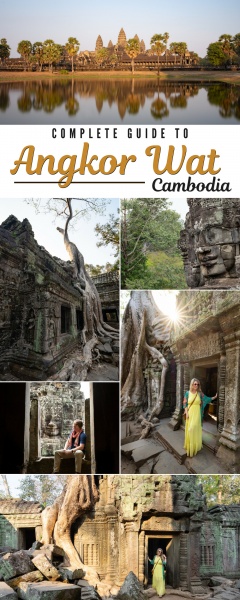
The Angkor Archeological Park is a large temple complex located north of Siem Reap in the town of Angkor. “Angkor” translates to “city” and “Wat” to “temple”. And Angkor Wat is the most popular temple in the entire complex. It’s the highlight of any trip to Cambodia , one of the most important archaeological sites in all of SE Asia, and is now a UNESCO World Heritage Site which helps to keep it protected.
This complete guide will provide you with everything you need to know prior to visiting Angkor Wat, including the best way to see the temples, entrance fees, hours, and how to get around.
Disclaimer: This post may contain affiliate links. If you make a purchase or booking through one of our links we may earn a small commission (don’t worry, it’s at no extra cost to you).
Complete Guide to Angkor Wat
Travel basics, things to know before you go.
- You’ll need to dress conservatively in the Angkor Archeological complex so be sure to cover your shoulders and your knees. Check out our complete packing list!
- Plan on going to the park early, before sunrise, to beat the heat.
- Wear flat shoes and plan on getting them incredibly dusty.
- Beware of scams around the temples. Men offering to show you the best photo opportunities or give you some history of the temple are only looking for a tip.
- Children trying to sell you various trinkets are everywhere here. It’s probably best not to encourage them by buying anything.
Getting to Angkor Wat
The closest city to Angkor Wat is Siem Reap . It takes about 15 minutes to get from the city center to the main entrance of the Angkor Archaeological Complex.
There is an international airport in Siem Reap (REP) so catching a flight from Phnom Penh or any large cities nearby is relatively easy.
Check Flight Prices on Skyscanner
If you would prefer to travel to Siem Reap by bus, Giant Ibis is a reliable, low-cost company with several buses daily from Phnom Penh. The trip takes about 6 hours and you’ll stop 2-3 times for food and bathroom breaks. It’s easiest to book bus tickets on Bookaway.com .
Check Bus Schedules & Prices
Getting Around Angkor Wat
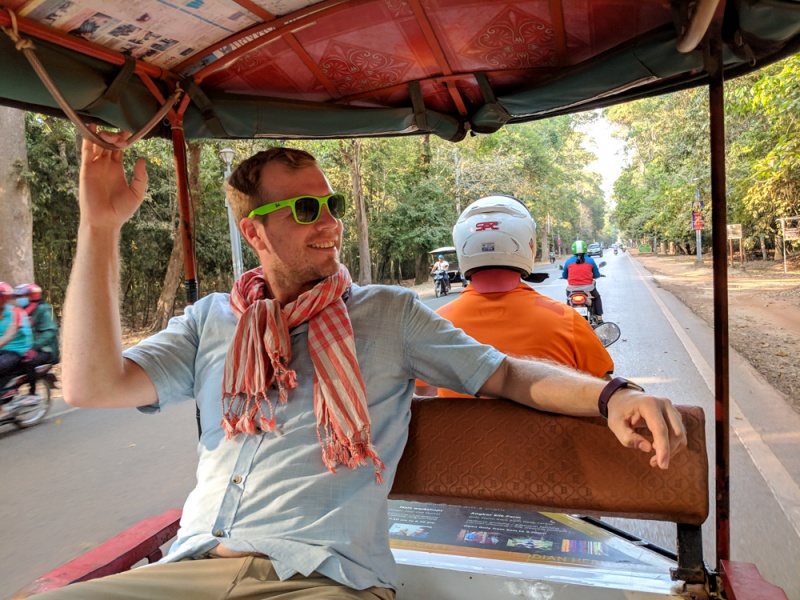
Most people hire a tuk-tuk for the day to take them between temples. Hire a driver the day before you plan to see the temples so that they can pick you up from your hotel, bright and early before sunrise. They’ll drive you to the most popular temples and wait for you while you explore each one.
There are two standard tours that you can take of the park – the Grand Circuit Tour and the Small Circuit Tour . The small tour will cost about $15 USD and the large tour generally runs about $20 USD. You can customize the tours a bit if you find a tuk-tuk driver who speaks fluent English.
If you want more freedom and flexibility, you can rent a motorbike or a bicycle and ride to the Angkor Archaeological Park on your own. Keep in mind that getting home on a bicycle after a long day in the sun will not be very fun.
The Best Tuk-tuk Driver in Siem Reap
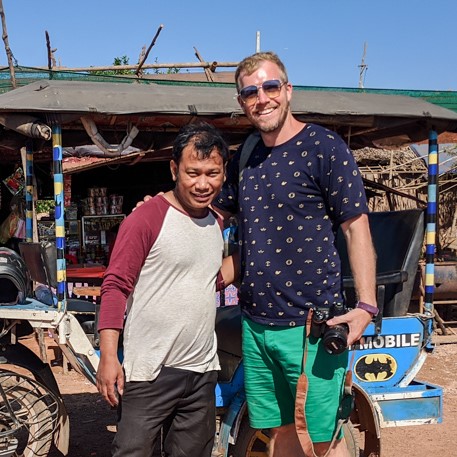
After several trips to Siem Reap we have worked with quite a few local drivers and our favorite Siem Reap tuk-tuk driver is Nakry Mean who drives a batmobile-themed tuk-tuk. You can reach him on WhatsApp at +855 17 761 110 or on his Facebook page, Siem Reap Batmobile Tuk Tuk .
Angkor Wat Entrance Fees and Hours
Angkor archaeological park entrance fees.
- 1-day ticket – $37 USD
- 3-day ticket (valid for 1 week) – $62 USD
- 7-day ticket (valid for 1 month) – $72 USD
- Children under 12 can enter for free but must show their passports.
- Tickets issued after 5 pm are valid for the next day.
- These tickets include entrances to all temples except Kulen Mountain and Bengmealea temple.
If you’re buying a 3-day or 7-day pass, you’ll have your photo taken at the ticket counter. Then your ticket with your photo will be laminated. They do this so you can’t resell your ticket to anyone else (unless you find someone who looks exactly like you).
Angkor Archaeological Complex Entrance Hours
- Angkor Wat Temple and Srah Srang: 5 am – 5:30 pm (open for sunrise)
- Phnom Bakheng and Pre Rup Temples: 5 am – 7 pm (open for sunrise and sunset)
- All other temples: 7:30 am – 5:30 pm
Angkor Wat Ticket Office FAQ
What are the hours of the Angkor Wat ticket office? The ticket office is technically open daily from 5 am – 5:30 pm; however, ticket agents usually begin selling tickets at 4:30 am. So you can arrive even earlier if you want to get a prime sunrise-viewing spot.
Where is the Angkor Wat ticket office located? The ticket office is inconveniently located a bit outside of town so make sure you give yourself enough time to get there and purchase your ticket on your first day. Also, make sure your driver knows you need to purchase a ticket as it may change the price you have been quoted (as they will have to drive a bit further). Better yet, buy it the evening before!
How long is the line to buy tickets for Angkor Wat? As can be expected, there are many tourists buying tickets for Angkor Wat every morning at 5 am. Luckily, there are over 20 ticket windows so you won’t have to wait more than 5-10 minutes to purchase your ticket.
Ticket Checkpoints
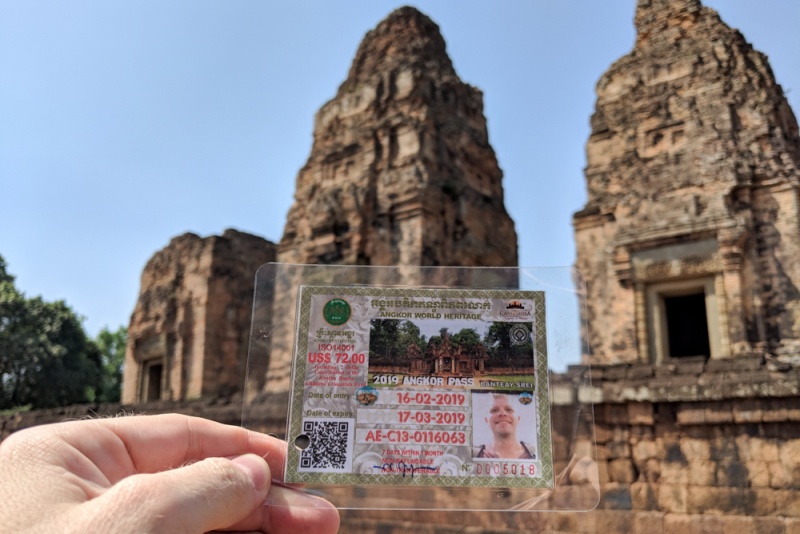
You’ll need to keep your pass on you at all times as it will be checked at the entrance to every major temple in the Angkor complex as well as when you enter the park on your tuk-tuk. If you purchase either a 3-day or 7-day pass, you will have your photo taken and your entire pass (photo included) will be laminated. This is to keep people from reselling or sharing their tickets.
History of Angkor Wat
The city of Angkor was built as the Khmer capital in the 12th century under the rule of King Suryavarman II. In its heyday, the city was quite large and had a massive population. Some historians believe that as many as one million people may have lived here. But what happened to those people is unclear.
Interestingly, toward the end of the 12th century, Angkor Wat transformed from a Hindu religious center to a Buddhist one. And Buddhism is practiced here to this day. You may see monks wandering around the Angkor Wat temple, some even offering a blessing for a small donation.
Where to Watch Sunrise at Angkor Wat
Sunrise from the angkor wat reflection pond.
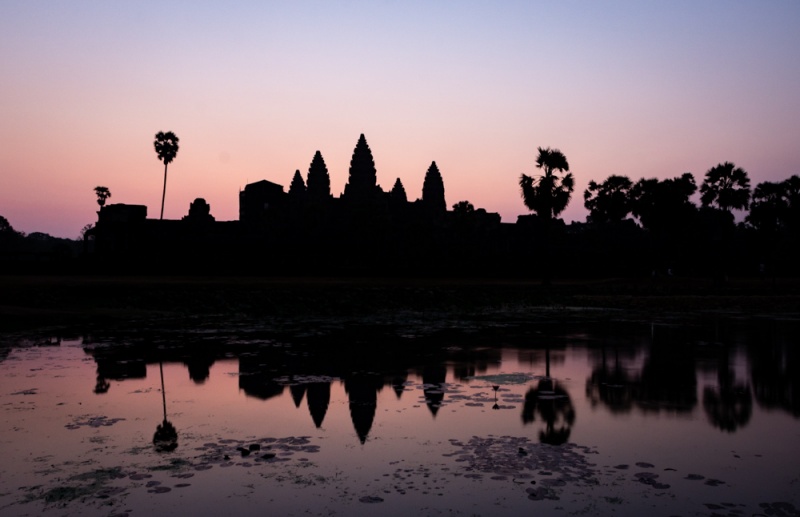
The most popular place to watch the sunrise is from the reflection pond right outside of the famous Angkor Wat temple. It is incredibly crowded and if you don’t lock down a spot by 5 am, you’ll probably be behind the first line of tripods . Expect a huge crowd of tourists vying for the best view of the temple. All that aside, it truly is the most beautiful spot to watch the sunrise in the park.
Sunrise from Outside the Angkor Wat Compound
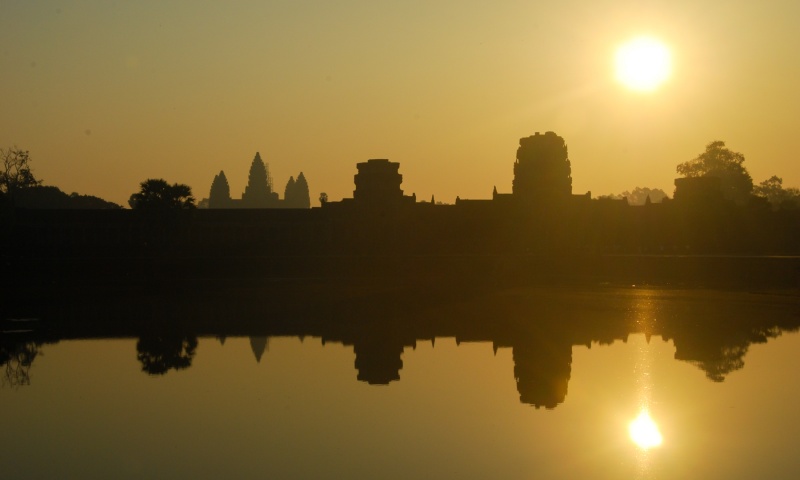
If that sounds too hectic, there are more peaceful spots to watch the sunrise. The easiest is to sit on the retaining wall of the moat that surrounds the Angkor Wat complex. Most people head straight inside the compound for sunrise so you’ll have this view almost entirely to yourself.
The benefit of watching the sunrise at Angkor Wat is that the temple opens earlier than most others. So you can start exploring immediately after. Whereas if you watch the sunrise at Srah Srang or Pre Rup, the nearby temples don’t open until 7:30 am. So you’ll need to grab breakfast and a coffee and wait.
Sunrise from Sra Srang
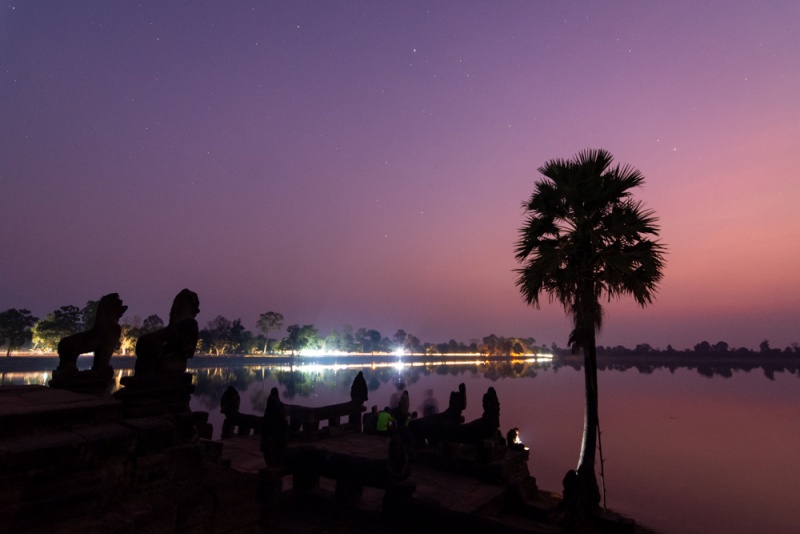
Srah Srang (sometimes spelled Srassrang ) is a large man-made lake with an ancient stone landing platform at the western end. Here you can sit and watch the sunrise over the lake in relative peace, far from the madness of the sunrise crowds at Angkor Wat. It doesn’t have the impressive temple view that the lake in front of Angkor Wat offers, but it attracts far fewer people.
Sunrise from Pre Rup
Pre Roup temple opens early so you can climb to the top for sunrise to see the view below. It also attracts far fewer tourists and offers really nice views of the surrounding jungle, although you won’t have views of other temples.
Sunrise from Phnom Bakheng
Phnom Bakheng temple is also open for sunrise. It provides a high vantage point of the surrounding countryside and a view of Angkor Wat far in the distance. That being said, it’s probably the least impressive of your sunrise options and it’s much more popular for sunset (see below).
Where ever you decided to watch the sunrise in Angkor, make sure you invest in a lightweight travel tripod so you can capture the moment!
Where to Watch Sunset at Angkor Wat
Sunset at phnom bakheng.
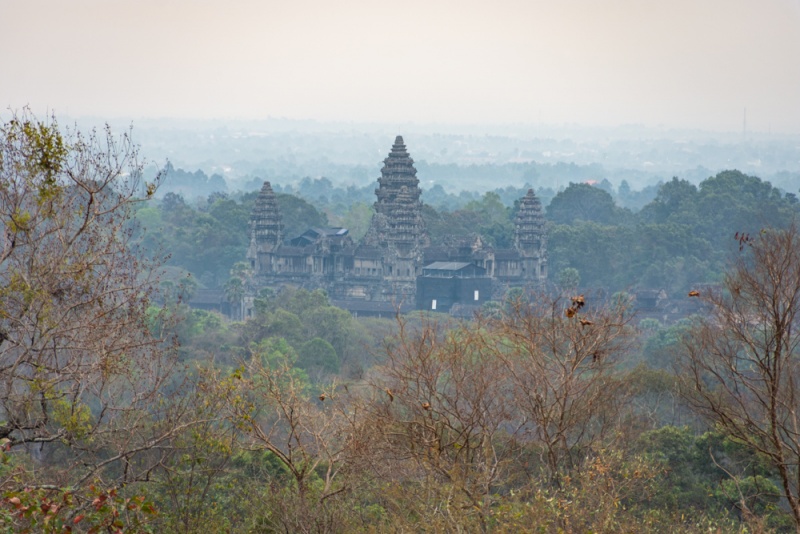
The most popular place to watch the sunset in Angkor Archaeological Park is from the top of the Phnom Bakheng temple. However, it is extremely popular and only 300 people are allowed to enter at a time. So plan on arriving three hours early to ensure that you’ll get a spot.
There is a corner at the top with a view of Angkor Wat (although you’ll need a zoom lens). Lock this spot down to see the colors of the temple change with the setting sun.
Sunset at Pre Rup
Sunset at Pre Rup also offers a nice view. It will also be quite crowded, but there is no limit on the number of visitors. You’ll mainly be watching the sunset over the surrounding jungle as there are no other temples in sight.
Sunset at Angkor Wat

Probably the best option is to head back to the reflection pool in front of Angkor Wat to watch the temple turn beautiful colors against the changing sky (although the sun will be behind you). Keep in mind that the guards will kick you out of the complex promptly at 5:45 pm.
The Small Circuit and Grand Circuit Tour Routes
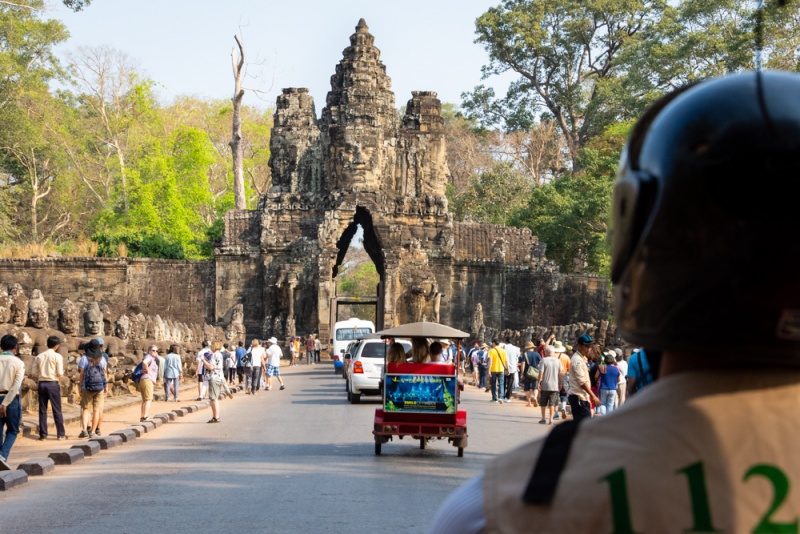
There are essentially two different tour routes – the Small Circuit Tour and the Grand Circuit Tour. Click on the links to read all about the routes, what temples you’ll visit, and everything else you need to know!
Small Circuit Tour Route
If you choose the Small Circuit Tour , expect to pay about $15 USD to hire a tuk-tuk driver for the day. You’ll visit the major temple attractions in the park, including Angkor Wat, Bayon Temple, and Ta Prohm, as well as a few others. If you add temples or take a long time at each spot, consider adding a small tip for your driver.
If you’d rather travel by car, the cost is generally $40-50 USD for the Small Circuit Tour depending on the time commitment and the number of people in your party. Some people choose to rent a bicycle or a motorbike for the day to see the temples at their own pace.
Grand Circuit Tour Route
The Grand Circuit Tour will run you about $20 USD. This route takes you farther out into the park to see a few of our favorite, less crowded temples like Ta Som and Preah Khan. If you have extra time to spend in Siem Reap, we would highly recommend doing both tours as all of the temples in the park are spectacular!
Book an Angkor Wat Tour in Advance
If you would prefer to arrange a tour in advance, Get Your Guide has good options that are well-organized and affordable. You can even book a tour with a lake-side champagne breakfast !
Not-to-Miss Temples in Angkor Wat
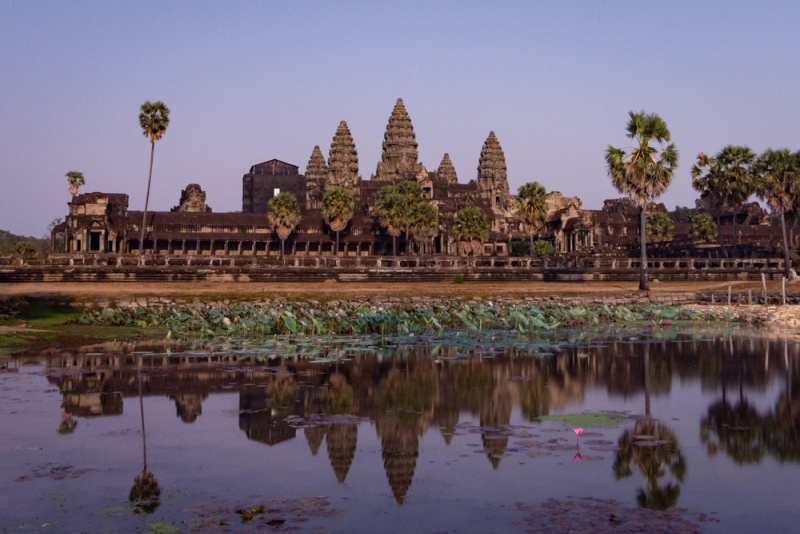
Angkor Wat is the most well-known of the temples in the ancient city of Angkor. The view of Angkor Wat from the reflection pond at the front entrance is the one that every tourist here wants to snap. And the iconic temple shape is actually on the Cambodian flag.
Built in the first half of the 12th century by King Suryavarman II, it is believed that construction took 30 years. And because the temple is oriented to the west rather than the east, as most Khmer temples are, it is believed that Suryavarman intended it to be his mausoleum upon his death.
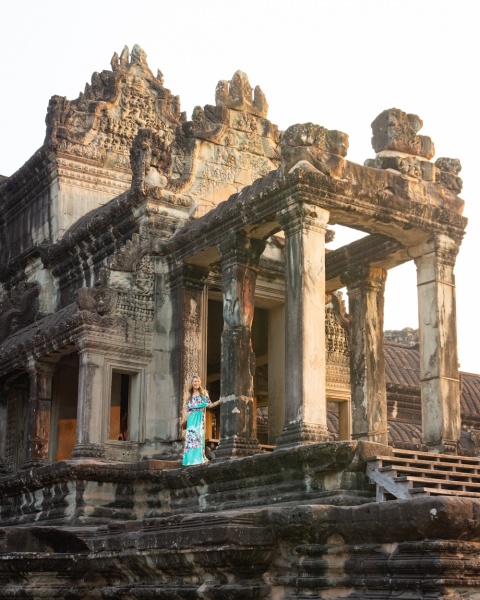
Angkor Wat is a large temple so you’ll need at least an hour or two to get through it. You must climb a set of steep stairs to reach the central temple and generally, a queue of people is waiting to get in. The central temple opens at 6:40 am and it’s best to get into line sometime between 7 am and 7:30 am. That way you miss the opening rush as well as the tour bus groups.

This is also the only temple that might be worth spending a bit extra for a tour guide. There are some really beautiful and well-preserved carvings that tell a lengthy story. A tour guide can show you the most significant carvings and explain the story.
Bayon Temple
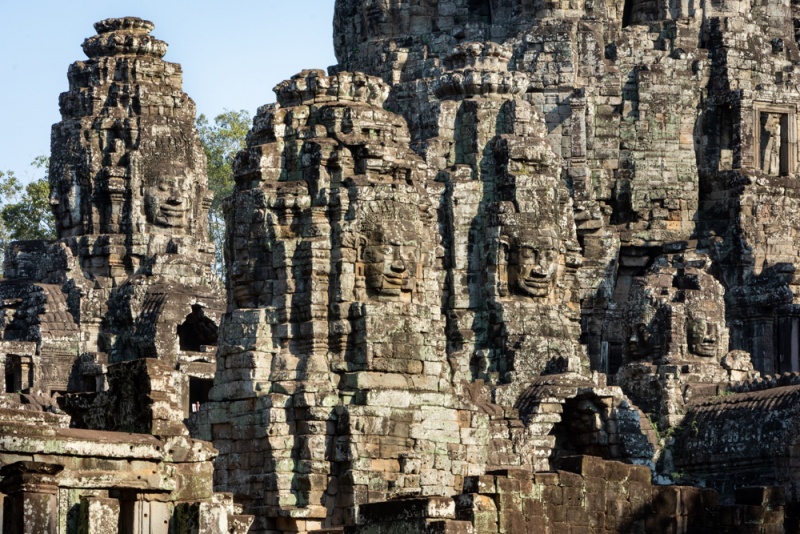
The Bayon Temple is a spectacular Gothic-style temple at the center of the ancient royal city of Angkor Thom. As you approach the entrance to the temple, look up. You’ll see the first of the 216 faces smiling down at you. These massive faces are everywhere here – some on top of tall towers, and others are close enough to touch. The amount of work that went to carving these sculptures is remarkable, to say the least.
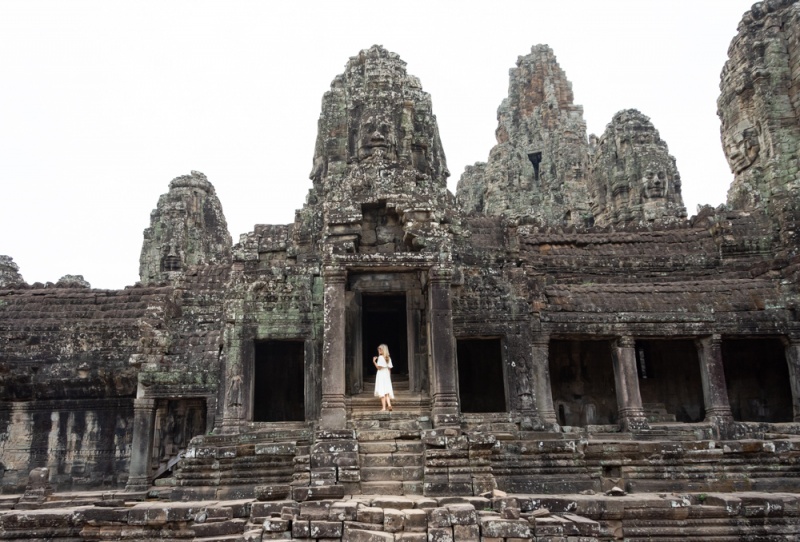
Bayon is best enjoyed in the early morning, right at 7:30 am when the gate opens. Or later in the day, closer to sunset. There are fewer crowds to compete with and the light creates more dramatic contrast on the carved faces. For the best views of the many faces, head up to the rooftop. Many of the statues are roped off to keep tourists from touching but you can still capture some amazing photos here.
Plan to spend at least two hours wandering around this enormous temple.
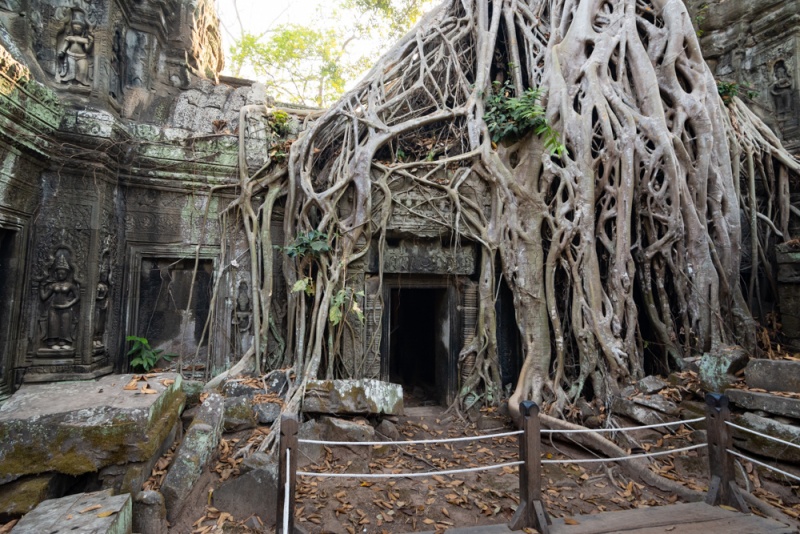
Ta Prohm was constructed in the late 12th to early 13th centuries. It is one of the most popular complexes in the Angkor Archaeological Park due to the fact that it is literally being consumed by the surrounding jungle. Strangler figs are wrapping their massive roots around these buildings which creates a setting unlike anything you’ve ever seen before (unless you’ve watched Lara Croft Tomb Raider as parts of it were filmed right in this temple).
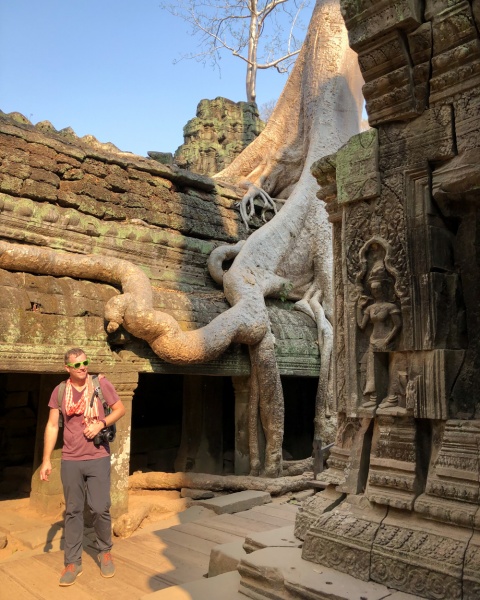
This complex is huge so plan on spending close to two hours here. Due to the fragile nature of the temples, walkways have been constructed to keep tourists contained. And ropes guard the most popular photo areas. You can take photos if you stay behind the ropes of course, but these areas get crowded so plan on waiting your turn.
Tour buses begin arriving around 8:30 am so if you want to avoid the crowds try to arrive right when the temple opens at 7:30 am.
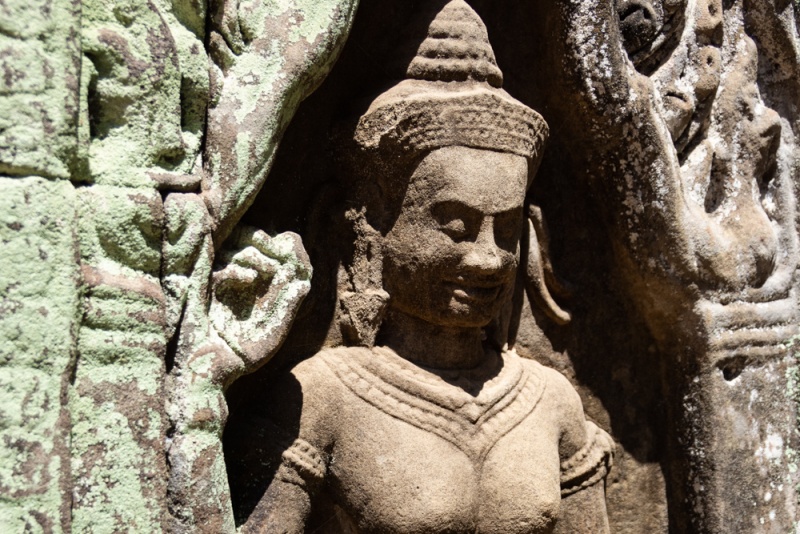
Ta Som is one of the smaller temples in the park but contains some of the most intricate, well-preserved stonework. An incredible amount of work and precision went into the stone carvings and Ta Som is a great place to get an appreciation for that effort. It was built at the end of the 12th century for King Jayavarman VII and is a must-visit temple during your trip to Angkor Wat.
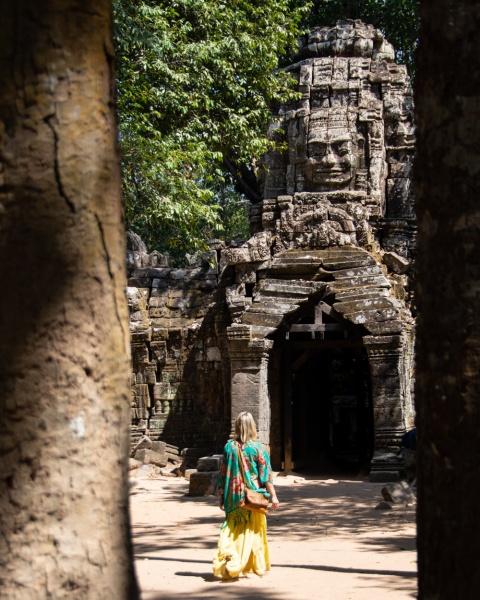
The most impressive sight at Ta Som is the eastern gate. As you approach it from the temple, you’ll see a large gate with a face watching you from the top. Pass through the gate to view the other side and you’ll see that a strangler fig looks to be consuming it. It’s a beautiful spot to snap a few photos.
Note that Ta Som is a part of the Grand Circuit Tour so you’ll likely only have time to visit if you have more than 1 day at Angkor Wat.
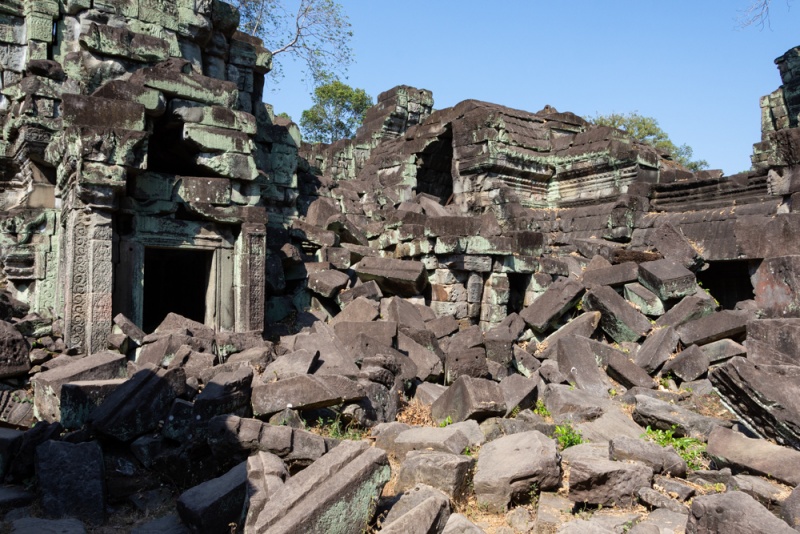
Preah Khan is also a part of the Grand Circuit Tour route. It was built in the 12th century at the site of Jayavarman VII’s victory over the Chams in 1191 and was meant to honor his father. It is another good example of the surrounding nature consuming the ruins and has been left largely unrestored.
As you enter the temple, there is a central hall that leads all the way to the back of the temple. At first glance, you may think that you’ll be walking through this long hallway forever, all the way seeing the same style of architecture. But soon enough the temple opens up on each side to reveal a plethora of areas to explore.
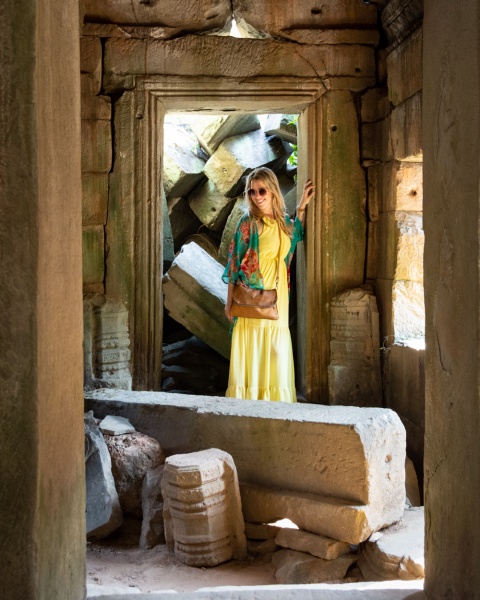
This temple not only has very well-preserved carvings throughout but also has areas where the temple is being overrun with vegetation, similar to Ta Prohm. It is a very large temple with surprises around every corner and endless photography opportunities. You’ll want to spend at least an hour here.
Want to read all about the other temples of Angkor Wat? Check out all of the temple stops along the Small Circuit Tour and the Grand Circuit tour !
Want more information on the temples of Angkor? Check out our favorite guidebooks!
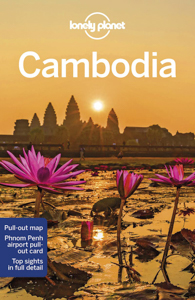
SHARE THIS ON PINTEREST

Val grew up in Portland, Oregon but moved to Oahu on a whim back in 2013. She sold her house and all of her belongings and bought a one-way ticket. Since then she’s taken two around-the-world trips and has visited 60-ish countries while living out of a duffel bag. Val started documenting the Wandering Wheatleys travels back in 2013 as a way to update friends and family about her whereabouts and to relay humorous daily interactions. The only readers were her mom and her mother-in-law but that didn’t stop her! These days you’ll find Val dreaming up future trips, creating new travel content, managing a team of amazing travel enthusiasts, and chasing around her two adorable but naughty kids.
Related Posts
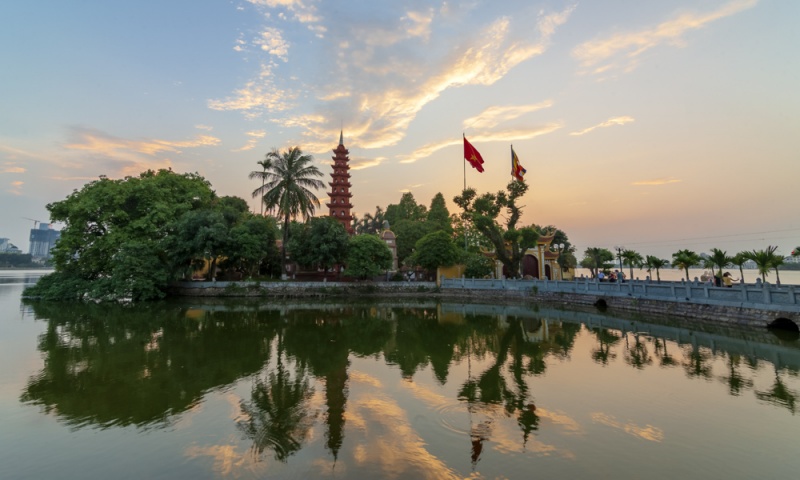
Where to Stay in Hanoi, Vietnam: The 10 Best Hotels
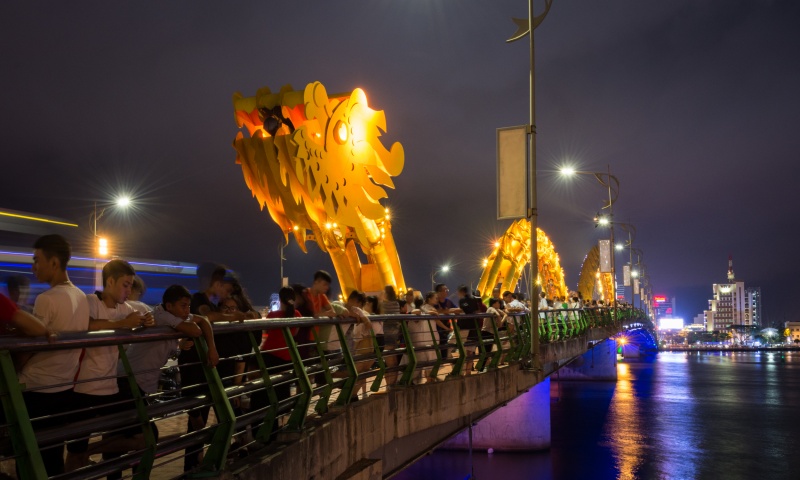
Guide to Da Nang, Vietnam: The Best 14 Things To Do
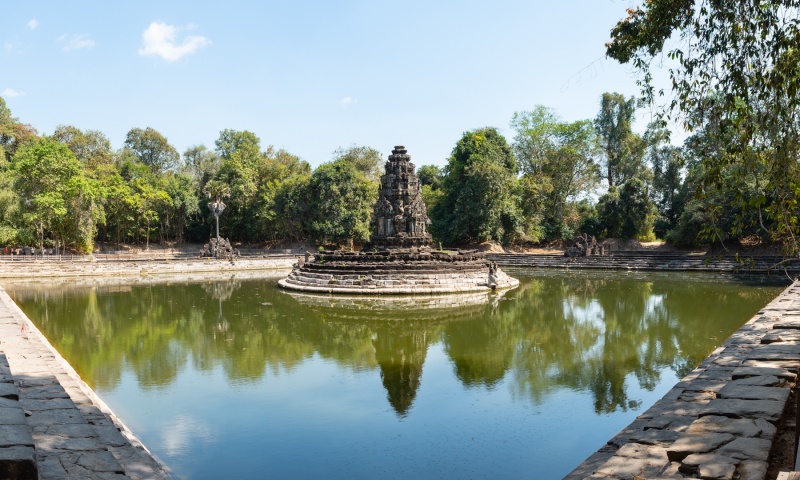
Angkor Wat: Guide to the Grand Circuit Tour
Leave a comment cancel reply.
Your email address will not be published. Required fields are marked *
Visit Angkor Wat: An Epic Travel Guide (Temples & Map)
A visit to Angkor Wat is something you’ll never forget. It’s massive. It’s impressive. It’s an amazing complex of well-preserved scattered temples and wats that showcase Khmer culture and beauty. The temples of Angkor Wat make up what is referred to as Angkor Archeological Park, which if you don’t know, is an explorer and history buff’s paradise.
From the well-known temples of Bayon (face temple) and Ta Prohm (tomb raider temple) to the lesser-known temples of Angkor Wat, we’ll provide you with a comprehensive travel guide so your visit to Angkor Wat is seamless. Be it information on Angkor Wat tickets, the best time to visit, or how to get there and around Angkor Archeological Park, we’re here to be your Angkor Wat guide.
Visiting Angkor Wat Temple & Travel Guide
Pin & Save For Later!
Jump Ahead To:
Angkor Wat Temple Facts
It’s always nice to understand what you’re about to experience, isn’t it? Below is a short but helpful list of essential Angkor Wat facts so you understand the basics before you arrive. Looky, looky whose coming prepared!
- Constructed in the early 12th century by the Khmer King Suryavarman II, Angkor Wat is one of the largest religious monuments in the world.
- The former Hindu, now Buddhist Wat, sits within a 400 square kilometers (154 square miles) complex that is known as Angkor Archaeological Park.
- Angkor Archaeological Park houses the remains of not only Angkor Wat itself, but the remains of the entire Khmer Empire dating back to the 9th – 15th centuries.
- The name “Angkor Wat” means “Temple City” or “City of Temples”.
- In the 15th century, the Khmer Kings abandoned their sprawling city and Angkor Wat laid forgotten for centuries. It wasn’t until a French explorer by the name of Henri Mouhot, rediscovered the Khmer city in 1860.
- In the early 1900’s the French established a commission to begin restoring Angkor Wat. To this day, restoration efforts are still underway, and a portion of ticket sales go to these restoration efforts.
Check out our Cambodia Travel Itinerary right here!
Where Is Angkor Wat & How To Get To There
The entire Angkor Wat Archeological Park complex is about 162.6 hectares / 401 acres in size and is located about 15 minutes (5.5 km / 3.5 mi) northwest of the city center of Siem Reap in Cambodia.
If you are not in Siem Reap yet, no worries. Siem Reap has an international airport (REP) so you can easily catch a flight into the city. Alternative options are to travel overland by bus . If you’re coming from Phnom Pehn or neighboring Thailand, there are loads of overland bus options for you to reserve and book. Once in Siem Reap, you’ll find no shortage of transportation options and guided tours that will happily whisk you to, from, and around Angkor Wat.
Best Way To Get Around Angkor Wat
If you are not planning on booking a tour of Angkor Wat, you have a handful of options on getting you not only to but around Angkor Wat.
A tuk-tuk from Siem Reap to Angkor Wat is the most popular option to take tourists to, from, and around Angkor Wat. You can easily hire a tuk-tuk for the day (or half-day) directly with a driver on the streets of Siem Reap, through your accommodation or local tour agency. Trust us, once you get into Siem Reap, you’ll see the plethora of Tuk-Tuk drivers offering their services to take you and your companions to visit Angkor Wat.
A round-trip Angkor Wat tuk-tuk price will cost you anywhere from $15 – $20 USD per day. If you pay closer to the $25 range, that is a little on the higher end, but up to you how much you want to haggle.
TIP: If you book a tuk-tuk with a driver on the street (like we did), do not pay him upfront. Wait to pay in full till the end of your trip. Regardless of who you book a tuk-tuk ride through, make sure the temples you want to see and how long you have the tuk-tuk for are clearly communicated and agreed upon upfront.
Private Van
Another option on how to get to and around Angkor Wat is booking a private van. Private vans provide air-conditioning and much more comfort than tuk-tuks. Also, you also have the nicety of having a tour guide accompany you as well.
To book a private van tour from Siem Reap to Angkor Wat, check out this private van tour here .
Bicycle Or eBike
The most cost-effective transportation option from Siem Reap to and around Angkor Wat is renting a bicycle. However, this is also the most labor-intensive. Temperatures in Siem Reap can be very hot and humid so please remember to stay hydrated while you cycle.
Also, to avoid any hiccups along the way, make sure the bike is sturdy. We’d hate for you to lose a tire along the way. Hey, it happens! Bicycle rentals vary but around $5 USD per day is average. A handful of accommodations have free bicycle rentals for guests and bike shops in Siem Reap offer day bike rentals.
Speaking of day rentals! An alternative to bicycling is getting a little assistance while you do it. eBike rentals are also available in Siem Reap. Regardless of how you choose to get to and around Angkor Wat, just know that walking isn’t an option.
Be sure to check out our 22 things to know before you travel to Cambodia here!
Angkor Wat Entrance Fees & Hours
When planning your visit to Angkor Archaeological Park you’ll need to determine how much time you want to spend in the park. You have three ticket options, each offering visitors different lengths of time:
- 1-Day Angkor Pass – $37
- 3-Day Angkor Pass (valid for 1 week) – $62
- 7-Day Angkor Pass (Valid for 1 month) – $72
Angkor Wat is open daily from 5:00am to 6:00pm . Whereas Phnom Bakheng and Pre Rup Temples are open from 5:00 am to 7:00 pm , and all other temples open at 7:30 am and close at 5:30 pm .
Angkor Wat Tickets – Additional Things To Know
- Children 12 and under can enter for free but must show a passport for proof of age
- Park tickets issued after 5 pm are valid for the next day
- The above 1, 3, and 7-day tickets options include entrance to all temples except Kulen Mountain and Bengmealea temple
- There is no ticket discount for groups
- All tickets require a photo of you, this ensures you cannot resell your ticket to another individual
- You can pay for your Angkor Wat ticket in cash or with a credit card (Discover, Visa, Mastercard)
Where To Buy Angkor Wat Tickets
Please understand that you can ONLY buy your Angkor Wat ticket from the Ticket Office Box. The Ticket Box office is not all that convenient to get to – 15 minutes from Siem Reap and 15 minutes from Angkor Wat. Tickets bought elsewhere are considered fraudulent Angkor Passes.
The ticket box office for Angkor Wat opens at 5:00 am and it would be in your best interest to get there before opening – around 4:30 am or 4:45 am. The ticket line can be loooong and if it’s too long, you could miss that beautiful sunrise you’re trying to get to. Luckily, there are about 20 window clerks cranking out tickets for tourists so your wait shouldn’t be too long, especially if you are one of the first in line.
Even though it takes about 15 minutes to get from Siem Reap to Angkor Wat, you need to take into consideration the amount of time it takes to get from Siem Reap to the Ticket Office, and then to Angkor Wat. On average, it takes around 30 minutes to get to and from all three, however, you’ll also need to take into consideration the time it will require you to buy your tickets. This is important when trying to plan for sunrise.
An alternative option is to buy your tickets the night before . Any tickets sold after 5:00 pm are valid for the next day . The ticket office closes at 5:30 pm so be sure to arrive around 4:30 pm to allow yourself the time you need to get in line and buy your ticket. Whatever you do, DO NOT BUY your ticket till after 5:00 pm. If you buy tickets before 5:00 pm, they’ll count for the current day and will not be valid for the next day.
Get our take on a perfect Angkor Wat itinerary right here!
Ticketing Check Points and Angkor Wat Ticket No-No’s
Whatever you do, don’t lose that Angkor Wat ticket of yours, and always make sure to have it on you. Why? It’s common to have your ticket checked by security at the entrance of certain Angkor temples.
If you lose, tear, or damage your ticket in any way, you’ll be required to purchase a new ticket at full price in order to gain access to the temples of Angkor Wat. Angkor Wat tickets are non-transferable and not meant to be resold. If you get caught selling your Angkor Wat ticket to another individual, you’ll pay a hefty fine.
Best Time To Visit Angkor Wat
January to May and then November to December are the best months to visit Angkor Wat. June to October is hit-and-miss months. During the months of June through October, the monsoon season is in full swing making walking around outside or seeing the Angkor Wat sunrise a bit of a challenge.
Regardless of which month you plan to visit, just make sure to start your day early. It gets extremely hot and humid in Cambodia so do your best to avoid sightseeing during mid-day. Plus, the early bird gets the worm as they say. Morning is not only great lighting for photos but tends to be a little lighter on the crowds.
How Long Do You Need To Visit Angkor Wat
How do you know which ticket option is best for you when visiting Angkor Wat? Well, it’s a personal preference. Our recommendation is to buy a one-day or three-day pass. Ask yourself the below questions and we promise, it’ll help you decide.
- Short On Time: Get you that one-day pass to Angkor Wat.
- Have A Few Days: Go on and buy that three-day pass or hell, the week pass if you have the time.
- Tight On Money: The one-day pass is $37 per person so even on a budget, that’s pricy.
- Have Some Funds to Spare : The three-day pass is going to set you back $62 per person but if you have the time, it’s worth it.
- Only The Highlights, Please : One-day pass for sure.
- Let Me See It All: If you are a history buff and seriously love ancient ruins and temples, then there are plenty of sites to keep you occupied. Get that three-day or seven-day pass.
Do You Need A Guide To Visit Angkor Wat?
First, understand that you do not need to book a tour to experience and visit Angkor Wat. Booking your own transportation and determining what Angkor Wat temples you want to see can be completely done by yourself.
However, take it from us, we got SO much more out of our visit by having a guided tour of Angkor Wat. You can reserve a guided tour of just Angkor Wat or look to book a guided tour through the entire park so you can get the history of each Angkor Wat temple you wish to visit.
Angkor Wat Tour Routes – The Grand Circuit and The Small Circuit
Alrighty, so what we’ve come to learn about Angkor Wat is there are established tour routes referred to as The Grand Circuit or The Short Circuit. While these are established routes, they are also totally customizable, especially when you hire your own Tuk-Tuk driver or book a private tour to take you around the park.
Before paying for either the Tuk-Tuk or the private tour , BE SURE to agree on any modifications you’d like to make to the below routes to ensure you see the Angkor temples you want to see. Having these conversations upfront ensures you are not surprised later by either having to pay more or risk not seeing a temple you had your heart on exploring.
The Small Circuit Tour
Great for those who only have one day in the park. The Small Circuit route covers the major highlights of Angkor Wat Archeological Park.
- Bayon Temple
- Baphuon Temple
- Terrace of the Elephants
- Banteay Kdei
Two popular guided tour options are to start the Small Circuit tour with sunrise or to start a little later to experience the Small Circuit with sunset . Whichever you decided, you’ll be whisked around Angkor Wat temples and shown some of the very best Angkor Wat has to offer.
There are two other Angkor temples that sometimes are or are not included in these routes, it just depends on your tour guide or Tuk-Tuk driver. But if of interest, it’s worth seeing if you can add Srah Srang and Phnom Bakheng to your Small Circuit route.
The Grand Circuit Tour
Unlike the Small Circuit route, the Grand Circuit route (also called the Big Circuit) includes a handful of Angkor temples on the outskirts of the complex. The below list of Angkor temples is often less visited by tourists when compared to the temples on the Small Circuit.
- Neak Pean (or Neak Poun)
- Banteay Prei
- Banteay Srei
- Banteay Samre
- Pre Rup
If you are looking to experience the temples on both the Small Circuit and Grand Circuit , you can coordinate with a Tuk-Tuk driver or look into booking a tour like this one , where over two days you’ll be whisked around Angkor Wat and the most popular set of temples. Or, if you’re just wanting to explore the Grand Circuit route, this is a great guided tour to check out.
Angkor Wat Temples Not To Miss
So now, with all the route talk said and done, really and truly the temples you want to see are up to you. We worked with our tuk-tuk driver and pulled from both the Small Circuit and Grand Circuit to see the temples we wanted to see.
Fair warning, there are several hundred temples and ruins that lay within the boundary of Angkor Archeological Park. Yes, that’s indeed a lot and can become a bit overwhelming when looking to find the best temples to visit in Angkor Wat. Below are not only the most popular Angkor Wat temples to visit , but the below also cover the most beautiful park highlights as well.
- Sunrise at Angkor Wat
- Angkor Thom
- Sunset at Pre Rup
Be sure to coordinate with your Tuk-Tuk driver to ensure the temples you want to see are understood and included in the price they give you. Same for a private tour , work with the tour company to ensure you see what you want to see.
Where To Watch Sunrise At Angkor Wat
Alright, being honest, there really is only a handful of places you should consider for sunrise. Also, it’s important to mention that not all Angkor Wat temples are open at the same time. So really, your options are limited as to where you can watch the sunrise.
If you are wanting to catch a sunrise at a temple not listed below, be sure to check its hours to make sure you can access the temple during the early hours of the morning.
- Angkor Wat Reflection Pond (Open at 5 am ): The most popular choice for sunrise in Angkor Wat is to see the sunrise over Angkor Wat and as the sky illuminates, watch the pond in front of Angkor Wat give a wonderful reflection of the scene appearing in front of you. Just know, sunrise here is BEYOND crowded. You will be shoulder to shoulder with people striving to see the same view as you, that famous Angkor Wat reflection pool sunrise. So, if you want to get a good seat, arrive early and hold your own as tourists begin to arrive.
- Pre Rup (Open at 5am): Pre Rup opens early for visitors to climb to the top for sunrise where you can find a spot to perch and watch the sunrise over the ruins and jungle below.
- Phnom Bakheng (Opens at 5am): Another option to watch the sunrise at Angkor Wat is Phnom Bakheng. This temple offers a high vantage point with views of Angkor Wat in the distance.
Get our tips for catching the sunrise at Angkor Wat!
Where To Watch Sunset At Angkor Wat
Like sunrise, only a handful of temples are open late enough in the evening for you to catch a sunset. Three of the most popular places to watch the sunset in Angkor Wat are listed just below.
- Pre Rup (Closed at 7pm): In the direction the sun sets, you’ll be watching it dip below a jungle tree line, but nonetheless, it’s pretty cool to watch the sunset from the top of an Angkor temple. Pre Rup is a close second to the most popular temple for an Angkor Wat sunset.
- Phnom Bakheng (Closes at 7pm): The most popular location in Angkor Archeological Park for sunset is Phnom Bakheng. Fair warning though, there are only 300 people allowed at a time in the temple to watch the sunset. So, if your heart is set to watch the sunset here, arrive a few hours early to not only get temple access but a good spot.
- Srah Srang (Closes at 5:30pm): Popular for sunset as the light and colors of the sky will light up the reservoir or Royal Bath that makes up Srah Srang.
Regardless of if you want to see the sunrise, sunset, or both, BE SURE to check the weather . If the forecast calls for rain or overcast, you might be out of luck. We’d hate for you to wake up early and not get to see the sunrise over Angkor Wat.
Angkor Wat Dress Code
Yes, these temples are ruins but that still doesn’t mean you can dress how you want. These are active religious sites still used by practicing Buddhist and Buddhist monks. So, your behavior and attire should be respectful.
- Knees and shoulders should be covered
- Feel free to wear a tank top but just bring a sarong or scarf to cover your shoulders when entering the temples
- Shoes are accepted, no need to go barefoot
- Shorts are fine
- Keep those shoulders covered aka no tank tops
We know, we know, Cambodia is hot, and shorts and tanks are amazing for that hot weather, but these outfit choices are not appropriate clothing for Angkor Wat. Be respectful and you’ll be just fine.
What To Bring With You To Angkor Wat
- Water : It is hot, and you’ll be doing a lot of walking so make sure you have plenty of water on you.
- Day pack: You’ll definitely want a comfortable backpack to carry your items, food, and water.
- Camera : Definitely do not leave this back at your room. Also, if you have extra batteries, be sure to pack those too.
- Sunscreen : Lather up your face and body. The sun is intense and since you plan on spending a full day exploring outside, make sure you apply several times throughout the day to keep you from looking like a crispy lobster.
- Sunglasses : Again, the sun. Protect those eyes and make it easier to see.
- Hat (if needed) : Yup, the sun again. Hats help block the sun further and provide you a little shade.
- Angkor Wat Ticket : 100% don’t leave this back in your room or you won’t be getting very far.
- Bug Repellent : You’re in the jungle after all, aren’t you? Don’t make yourself a mosquito snack. Pack and apply buy spray.
- Cash: There are food stalls and restaurants in the park, bring some cash for food and tips for your tour guide or driver.
- Wet Wipes or Hand Sanitizer : Meh, it’s dusty and you’re going to touch a lot of things other people have touched. It’s nice to have some clean hands when you take a break for lunch or to eat any snacks.
- Power bank : More than likely you are going to be out all day, and no one likes it when their phone dies. Bring a power bank to keep your phone or any other gadgets charged.
- First Aid Kit : We always have one with us in our day bag. It’s SO nice pull out a Band-Aid to cover up blisters of some Tylenol when you have a headache. We don’t want you to have a cut or headache and have to go searching for relief when you could have something in your pack instead.
- Snacks : Plain and simple, no one likes to explore when they’re hungry.
Tips For Visiting Angkor Wat
- Do not ride the elephants . Just don’t. That’s animal abuse and it’s cruel so please avoid elephant rides and tours at Angkor Wat and everywhere else you travel too.
- Dress appropriately . Be respectful in your attire (cover your chest/cleavage, shoulders, and knees) if you want to gain access to temples in Angkor Wat.
- Stay Hydrated . Ya’ll we can’t stress enough how hot it can get. Just make sure you have plenty of water and more importantly drink the water.
- Plan Ahead . Know which temples or route you want to take, book tours or guides, and have a plan for when you want to buy your tickets. Laying out a plan will take any stress of your visit away.
- Wear comfortable shoes . You are going to be doing LOADS of walking, so be sure those little feet of yours are supported.
- Be Wary of Fake Tour Guide s: You may get approached by kids or adults offering to take you on a personal tour of “x” temple you are currently exploring. Politely, but assertively decline as these are not certified guides.
Angkor Wat Temple Map
Below, you’ll find an interactive map showcasing the temples traditionally shown during the Small Circuit route as well as the temples typically shown on the Grand Circuit route. Click on the map to show what temple is what as well as zoom in and out to get a feel of the space and the complex of Angkor Wat.
Accommodations Near Angkor Wat
Siem Reap offer’s plenty of accommodation choices for those looking to explore Angkor Wat. With the city center of Siem Reap is only 15 minutes away, staying in Siem Reap is a great choice when booking accommodations . However, if you are wanting to stay outside of the city, there are accommodations near Angkor Wat for you to consider.
For The Budget Conscious: Looking for a humble stay? Well, look no further than Sok Phen Homestay or Dany’s Angkor Cottage . Stay in humble abodes situated in the Cambodian countryside. Enjoy cooked meals and sweet serenity at Sok Phen Homestay or Dany’s Angkor Cottage .
For The Luxury Inclined: Templation Hotel , is a luxury getaway close to Angkor Wat. With lovely rooms, an amazing pool, beautiful gardens, and friendly staff you’re in for an unforgettable stay.
For Something In Between : Located a few miles from Angkor Wat, you’ll find the beautiful Grand Venus La Residence . Grand Venus La Residence is a modern hotel featuring a massive pool and beautiful surroundings far from the noise of Siem Reap.
For more places to stay near Angkor Wat, you can check out the latest places and prices here .
WANT MORE INFORMATION ON CAMBODIA?!
Kampot, Cambodia: Your Complete Travel Guide
9 Amazing Things To do in Battambang, Cambodia
6 Tips For Seeing Angkor Wats Sunrise
Cambodia Tips: 22 Things To Know Before You Visit Cambodia
Volunteering at a Cambodian School
PIN IT FOR LATER!
For more travel tips, guides, and awesome travel shots, be sure to poke around our site, follow us on Instagram @wanderingstus, Pinterest on Facebook . Oh and if you have any questions, let us know in the comment section. We’re happy to answer. Or, just leave us a positive note!
Happy Travels,
– Lauren & Jesse Stuart (The Stüs)
We're Lauren & Jesse, the creators behind Wandering Stus! We've been traveling for decades, exploring and experiencing the very best this world has to offer. Whether we're roadtripping the U.S. in our camper, hiking through National Parks, or jet-setting to different countries around the globe, we write detailed travel guides to help you plan one amazing (and unforgettable) adventure!
Questions?! Let us know. Leave us a comment! Cancel reply
This site uses Akismet to reduce spam. Learn how your comment data is processed .

- Why travel with us
- Meet the Team
- Accommodation
- Travel Blog
9 Practical Tips to Visit Angkor Wat: Things to Know Before Visiting Angkor Wat Temple, Cambodia
Angkor Wat is the reason why many people decide to visit Cambodia. It is one of the essential places to visit sometime in your life for its majesty and complexity.
The Angkor compound is over 80 hectares in size and has several temple complexes. It is a tourist attraction, that is why it is important to take into account a set of advice and recommendations for the visit.
So let’s get to it, these are our tips for visiting Angkor Wat:
1. Purchase the ticket in advance
If you arrive in Siem Reap late in the afternoon, purchase tickets for the next day. Make sure you know where the office is located; it was relocated in 2016 and is now very far from the Angkor Complex. The Angkor Ticket Booth is open from 5 a.m. to 5:30 p.m., but queues start forming as early as 4:30 a.m. in the morning as last-minute visitors rush to see the sunrise.
When you buy them they take a photo of you to verify that the pass corresponds to the person who carries it. It is important to carry your passport. You can purchase one of the numerous varieties of Angkor Passes. The cost of a one-day pass is $37, a three-day pass is $62, and a seven-day pass is $72. The three-day and seven-day passes are good to go for it. You can pay in US dollars or by credit card.
2. Respect the Dress Code
Even if the weather is hot and humid, Angkor Wat is still a holy place, therefore dress respectfully!
Keep in mind that you are visiting a sacred site, and being mindful of this is crucial. Wear appropriate clothing that covers your knees and shoulders, and behave appropriately when you’re there, as this isn’t just a pretty tourist picture spot.
3. Don’t miss Angkor Wat sunrise
Sunrise is one of the most magnificent moments in Angkor, and many tourists are aware of this. As a result, if you want to see it from the front row with the Angkor Wat temple as a backdrop, you’ll have to get up early.
Set the alarm clock to arrive at Angkor Wat’s main temple at 5:00 a.m. or shortly afterward to see one of the world’s most beautiful sunrises. And if the sun doesn’t rise until 5:30 or 6:00 a.m., being there early would ensure you find the right location for the best photo of the day.
Related: Tips to Visit Angkor Wat Sunrise: The Ultimate Angkor Travel Guide
4. Beware of monkeys
Monkeys can be seen throughout the Angkor complex; however, you must be cautious of them because they can bite. If you have food or drinks in your hand, keep an eye on them as they possibly can steal them. They don’t frequently steal bags, cameras, or other valuables.
5. Most Temples Don’t Open Until 7:30 am
The majority of visitors to the Angkor Archaeological Park begin their temple tour at Angkor Wat with the sunrise. However, sunrise is not only stunning, but it’s also convenient because Angkor Wat opens earlier than most other temples, allowing you to go inside and start touring right away.
If you want to see the dawn from another location in the park, you’ll have to wait until 7:30 a.m. to begin exploring the adjacent temples. While you wait, get a cup of coffee or a bite to eat.
Therefore, there are only four Temples that are available to open early for sunrise: Angkor Wat, Srah Srang, Phnom Bakheng, and Pre Rup temple.
Related: Must-visit Temples in Angkor Archaeology Park
6. Eating at Angkor Complex
You will likely spend the entire day at the temples and will have to dine inside the enclosure. There aren’t as many options as in the city, but there are plenty of local restaurants near the temples.
Cambodian cuisine is known for its abundance of veggies. It’s comparable to the one found in surrounding nations, but it’s prepared differently.
Rice is the country’s main food source, but noodles are also popular. Amok is the most famous Khmer food, which consists of meat or fish cooked with coconut milk, veggies, and spices. Lok-Lak, a dish made with spicy beef, lime and pepper sauce, rice, and a fried egg, is another national food. In most local places surrounding the Angkor complex, the average plate is $5-$6 but there are endless options where you can eat very well for $8-$10.
Related: Cambodian Cuisine and Influences
7. Transportation
When visiting Angkor Wat in a single day, one of the most important decisions you’ll have to make is how you’ll get around. Because Angkor is so large, traveling from one temple to the next is impossible. At each temple, you’ll be doing a lot of walking, not to mention climbing a lot of steps. Hiring a jeep , TuK-Tuks, and bicycles are the three options for getting around Angkor. Foreigners are not permitted to ride motorcycles or scooters within the Angkor complex.
If you want to visit Angkor Wat on a tour instead of doing it on your own, we can highly recommend this full-day sunrise jeep tour . It’s great value for money and without hassle. Our tour guides are super knowledgeable and friendly, and you get to see all of the best temples in Angkor Wat in the open-air jeep.
Related: Guided Angkor Wat Tour By Jeep
8. Reduce the impact of the visit as much as possible
An almost thousand-year-old monument like Angkor with a growing volume of visits and the ravages of the elements can be in serious danger if a horde of unconscious visitors does not respect the minimum standards of civility or care in the visit.
The best visit is to avoid touching, sitting on, or climbing on the temple structures, no matter how solid they appear. It goes without saying that taking stone shards or other relics of any type is prohibited.
9. Medical Emergency
We’ll assume you’ve purchased travel medical insurance with evacuation coverage, which is unquestionably necessary.
However, the Royal Angkor International Hospital is the primary medical facility. Before going to the doctor, make sure you have enough cash or credit cards. Even for minor difficulties, expect large costs in the thousands of dollars.
Recommended Tours

Angkor & Beyond

An Insider’s Angkor

Angkor Gateway

Angkor Temples Discovery

Angkor Sunrise Jeep Tour

Angkor Sunset & Boat Ride
Latest articles.

Experiences

Countryside Sunset Jeep Tour

Kulen Mountain Adventure

Just Ride: Countryside Sunset

Inspiration
To receive updates about exclusive experiences, promotions, events, new destinations and more, please enter your details below. Fields marked * are mandatory.
Tour Request
Please fill in the form below and our team will be in touch shortly, or contact us at: [email protected]
- Subscribe to our newsletter.

4 Tips For Visiting The Archaeological Wonder Of Angkor Wat
W hile not actually listed as one of the Seven Wonders of the World, Angkor Wat in Siem Reap, Cambodia, must surely be the eighth. Set across 402 acres of land, this sprawling temple complex holds the Guinness World Record as the largest religious structure in the world.
I had the chance a few years back to visit this giant wonder. I spent 4 days exploring all of the ruins. Here are my tips for getting the most out of your visit to Angkor Wat.
1. Hire A Tuk-Tuk Driver
Chances are you are staying at one of the many hotels or hostels in Siem Reap proper. This will mean that you need transportation to the actual temples. Enter one of hundreds of tuk-tuks usually lined up outside of the hotels and hostels.
These drivers don’t just provide you with transportation; they are actually a wealth of knowledge about everything you will be seeing. While they cannot enter the temples with you (this is reserved for registered tour guides only, which you will find inside the entrance), they can give you the low-down on each temple during the ride there so that you are prepared with valuable information upon entering.
For about $20–$25 a day (and I’m talking full days), you will get transportation from your hotel to the entrance of the ruins. The entrance fee is separate and costs $37 for a 1-day pass and $62 for a 3-day pass (valid for 1 week). The guide will also ride you around to all the different temple areas.
You will also get a personable and knowledgeable driver who will provide a cooler with cold water and towels. (You are also free to place whatever goodies you have in the cooler for lunch and such.) Trust me, you will be grateful for these basic but necessary perks after a few hours roaming outside in the hot sun of Cambodia. That’s not to mention the relief of the shade from the roof of the tuk-tuk on the ride between temples.
Pro Tips: If you would like a guide to be with you as you roam the grounds, plenty will be waiting for you at the entrance after you’ve paid your fee. These usually cost between $40 and $50. This is usually per group, not per person. Alternatively, you could opt to buy or download a guided tour on your phone to listen to as you explore the ruins. However, given the size of the grounds, this can get confusing and hard to follow after a while.
2. Consider How Many Days You Want To Spend Exploring
The number of days you decide to spend visiting the temples at Angkor Wat will surely depend on the amount of time you have in the country, so this will be an entirely personal decision. Most people seem to recommend at least 3 days and I would too. I would actually recommend 4 days, if you can, to ensure you see all of the top sites.
However, if you only have 1 day to visit, your tuk-tuk driver will likely tour you around what is known as the “small loop” or “small circuit.” This route will take you to the three major highlights of the grounds — Angkor Wat, Angkor Thom, and Ta Prohm. They are highlights for good reason as they are truly spectacular and will give you a sense of the wonder.
If you have longer than 1 day, your driver will likely take you on the grand circuit. This includes the three temples on the small circuit as well as many of the smaller temples outside the central cluster. With 3 days, you will also have time to do a sunset or sunrise visit, or both.
3. Sunset And Sunrise At The Temples
One of the biggest advantages of spending more than 1 day at the site is that you can include a day in which you get to see either the sunrise or sunset at the temples. This is a very popular thing to do, so be aware that you will definitely not be the only one there.
If you want great pictures, plan to be there well ahead of time to stake your spot. Then be prepared for latecomers to budge their way in; such is the way of tourists these days.
If you hope to go for sunrise, the park entrance opens at 5 a.m. This means, depending on the location of your hotel, you will want to leave at about 4:45 a.m. Your tuk-tuk driver will be able to help you determine this.
The best spot to view the sunrise is at the reflection pool located right in front of the main temple. This reflection allows for some spectacular pictures of the Sun rising in the water with the temple in the background. Be sure to walk around and get pictures from several angles.
If you’re hoping to go for a sunset, the most popular spot to do this is at the temple of Phnom Bakheng. This temple is located on top of a hill allowing for a spectacular view. Be sure to check times of sunrise and sunset to ensure you are there with plenty of time to catch either.
4. The Dinosaur
Maybe you’ve heard of it, or maybe, like me, you hadn’t. On my travels, I overheard someone else’s guide talking about it and then wandered around to find it. Either way, now you know.
If you’d like to see this dinosaur — a stegosaurus to be precise — you will need to visit the temple of Ta Prohm. This temple was made famous when the movie Tomb Raider hit theaters. Parts of the adventure movie are filmed in it. And while this may be the reason many tourists visit this temple, do not forget to also look for the tiny dinosaur carved into a temple wall.
The carving is located in a corner of the courtyard. You must look to the left of the central exit. Once you find it, create your own theories as to how a dinosaur was carved into a temple nearly 900 years old.
Regardless of how many days you have to spend in the awe-inspiring archaeological site of Angkor Wat, you are sure to enjoy your time if you keep these tips in mind. As well, be sure to wear good walking shoes; light clothes that cover your arms, shoulders, and knees; perhaps a hat; sunglasses; and sunscreen. Enjoy it and take all the pictures you can!
This article originally appeared on TravelAwaits

You will be redirected to your dashboard shortly. We will also call you back in 24 hrs .
- Angkor Wat Vishnu Temple Invites You To Embrace A Tranquil Experience In 2024
25 Jun 2024
The largest religious temple to ever be built in the world, Angkor Wat Vishnu Temple , is in Krong Siem Reap, Cambodia. The Buddhist temple complex was initially built as a Hindu temple, dedicated to the God Vishnu from 1116 CE to 1150. Built in the ancient city of Angkor, 72 major and hundreds of minor temples are surrounded by it. It is made of an impressive moat that surrounds the entire temple as a protective barrier, with the main sanctuary hidden within the five stone towers and spans over 400 acres of land. The architectural design of the temple has been constructed to depict Mt. Meru. The intention behind building the temple was not only to pay homage to lord Vishnu but also to assert the political power of the King.
Delve Into The History Of Angkor Wat Vishnu Temple
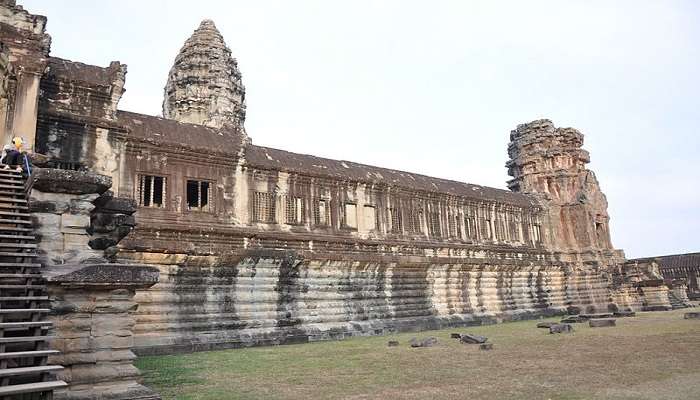
Image Credit: Jorge Láscar for Wikimedia Commons
In the 12th century, the temple was a Hindu temple complex built for Lord Vishnu, who is part of the Holy Trinity (Brahma, Vishnu, and Shiva) according to Hindu mythology. He is also called the ‘Protector’ amongst the three gods. Coincidentally, King Suryavarnam II, who had the temple made, his name translates as ‘Protector of The Sun’.
In ancient times, kings often built temples to pay homage to Gods and establish their influence. The bigger the temple, the wider their power and dominance spread across kingdoms. Similarly, The Cambodian king, King Suryavarnam II built the Angkor Wat Vishnu Temple to establish his political power. It was believed the grandiose of the temple decided whether it was a worthy home for Gods, and if it was, then that showed the enemies and the predecessors of the King of his influential power.
Must Read: Cambodia Honeymoon
Angkor Wat Vishnu Temple – Lost Or Forgotten?

Image Credit: Serg Alesenko for Pexels
The temple is referred to as the Lost City Temple, or was it truly lost? This way of reference to the temple could rise due to the Western narrative of it being discovered by Henri Mouhot, a French explorer in the 1840s. Situations such as wars, earthquakes, overgrown forests, etc, may have caused some damage to the city and the temple, but it was never lost to the people of the Khmer culture. They continued to live peacefully, hidden away from the rest of the society.
When terms such as ‘lost’ or ‘abandoned’ are used, it removes the importance of the place’s and people’s pre-existing indigenous data. Though not directly rude, language is a weapon against such societies and gives power to the more ‘civilised’ population. This only allows the ‘founders’ of such “lost cities” to colonise such places as they believe local or indigenous societies need to be tamed. It is too late to change its reference to the lost city, but it is important to know the history from all perspectives rather than just the Western one.
The city of Angkor is home to many temples with walls carved out of stone. These carvings are stories that scholars believe are life lessons that the people of Khmer culture learned from their previous generations and taught the same to the new generations. The temple walls have faced the test of time, and though they have been brunt to few damages, they still stand tall and proud. These walls convey their lessons through visual representation.
The Seventh Key Of Angkor Wat Vishnu Temple

Image Credit: LizaBo for Wikimedia Commons
The carvings are called keys and symbols, and seven exist: the snake, the bird, the five towers, the stepped pyramid, the seven steps, the world axis, and the legend of the churning of the sea milk. All in all, history buffs and zealots can have a wholesome experience while exploring the temple.
Suggested Read: Places To Visit In Cambodia
The Legend Of The Churning Of The Sea Of Milk
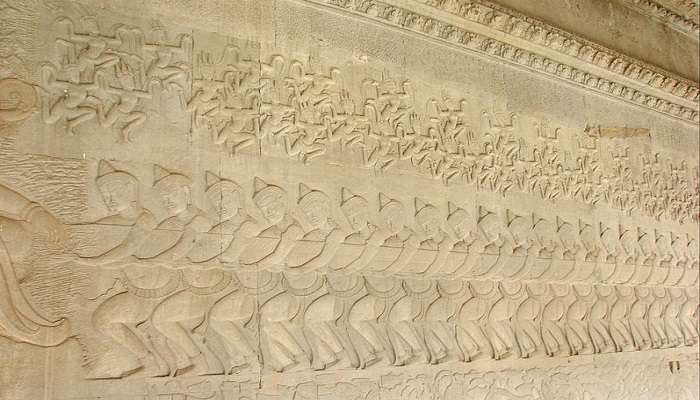
Image Credit: Jean-Pierre Dalbéra for Wikimedia Commons
History buffs and devotees will all find this legend very interesting. The seventh key, or the legend of the churning of the sea milk, is one of the most famous narratives in the temple.
It depicts the story between good and evil, restoring peace and unity. Lord Indra had been tasked with churning the sea milk to attain the elixir of life or amrit. However, he was warned that the gods could not carry out the task alone, so they had to work with the demons or asuras. Mt Meru was used as the stick to churn the sea, and Vasuki, the great serpent, was used to move the stick. It almost seemed like the demons and gods were playing a tug of war to earn the elixir. However, the stick or Mt Meru kept slipping away from its place. Lord Vishnu came to the rescue by turning himself into a sea turtle to stabilize the kerning stick.
Slowly, with time, the gods and demons accepted each other and worked in unison rather than a tug of war. Their hard work and unison were rewarded with many boons or gifts such as Airavata, the elephant vahana of Lord Indra, Apsaras, courtesans of the sky, Kalpa Vriksha, a wish-fulfilling tree, etc. This story of the churning of the milk sea is the story or key that unites all the seven keys of the Angkor Wat Vishnu Temple that teach the meaning and importance of life through its carved stones.
Rules To Know To Visit Angkor Wat Vishnu Temple
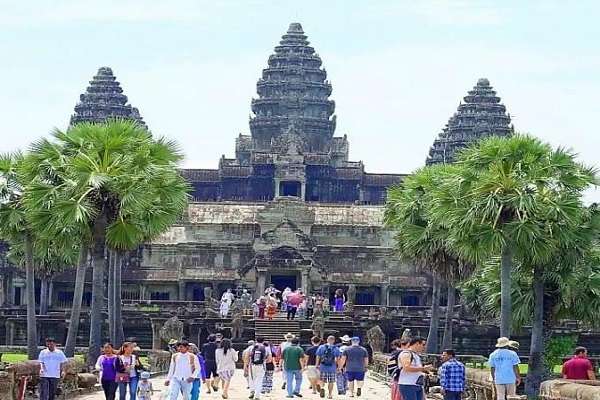
Image Credit: Travel to Cambodia for Facebook
The Angkor Wat Vishnu Temple is a sacred and religious place for the local people, and certain rules and regulations must be followed so that people from all regions and religions can enjoy their visit.
- All tourists must strictly follow the dress code: Their elbows and shoulders must be covered. If tourists or locals are not dressed modestly, they will be barred from entering. Touching, vandalizing, or looting are strictly prohibited within the temple, as there are grave consequences, such as imprisonment or deportation.
- Photos should be taken only with permission.
- The temple is frequented by the monks in the area, and they must be respected and not disturbed.
- In Cambodian culture, being loud and creating noise is considered disrespectful. A temple is a sacred place and must be treated as such.
- Any place labelled as ‘No Entry’ must be taken seriously. Though the temple is open for tourism, it is wise to remember that some parts of the temple complex are still in ruins and could be dangerous to venture into.
How To Reach
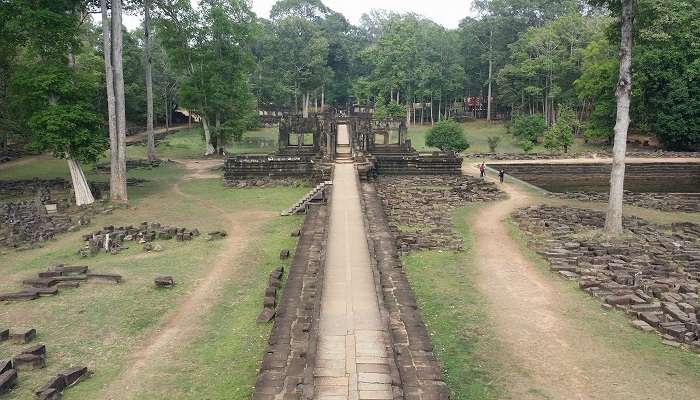
Image Credit: Angkor Transportation +855 10 833 168 for Facebook
By Road: The Angkor Wat temples are just 5.6 km from Siem Reap town. The cheapest way to get there is by taxi, which costs about $7.
By Air: Direct flights to Siem Reap are available only from Bangkok and Singapore.
Further Read: Kachanh Waterfall
Visiting Cambodia and not experiencing the divinity and peace at Angkor Wat Vishnu Temple is an absolute miss. Enjoy the positive vibes and seek blessings for a better future. So, plan your trip to Cambodia with loved ones for the best time.
For our editorial codes of conduct and copyright disclaimer, please click here .
Cover Image Credit: Jakub Hałun for Wikimedia Commons
Frequently Asked Questions About Angkor Wat Vishnu Temple
Why is Angkor Wat Vishnu Temple famous?
It is famous for its vast size and the largest religious monument in the world. It is also famous for its age and its architectural marvels.
What does Angkor Wat mean?
In Cambodian, Angkor means ‘city’ and Wat means ‘temple grounds’. Together its means “City Temple”. However, we still don’t know how this temple was called around the time it was built.
Who was the temple built for?
This temple was built for Lord Vishnu. Vishnu is the god of preservation in Hindu mythology.
What are the temple’s opening hours?
The Angkor Wat Vishnu Temple is open between 5 am and 5:30 pm.
What is the entry price?
The ticket prices depend on the duration for which you want to stay within the temple complex. The one-day pass is for $37. It is very much worth it because the temple is very large and there is much to explore.
People Also Read:
Dalai Lama Temple Champavati Temple Someshwar Mahadev Temple
Recent Posts

Explore The Indian Music Experience Museum For A Delightful Venture In 2024

A Pilgrim’s Guide To Visiting The Bull Temple In Karnataka In 2024

Take A Stroll Through The Sri Gangadhareshwara Temple In 2024
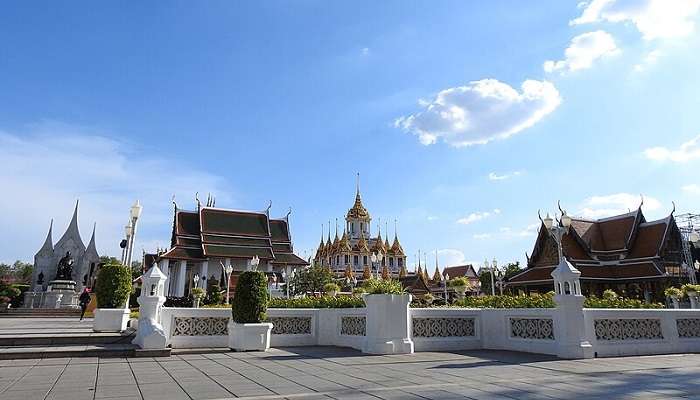
Your Ultimate Travel Guide To Visit Wat Ratchanatdaram In Bangkok In 2024
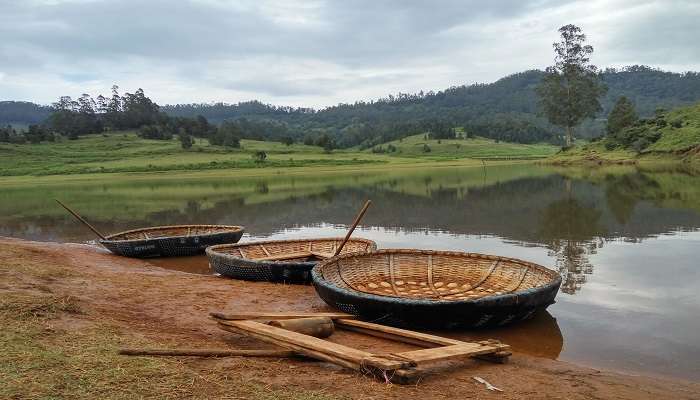
Dive Into The Outstanding Beauty Of Mannavanur Lake In 2024 Trip
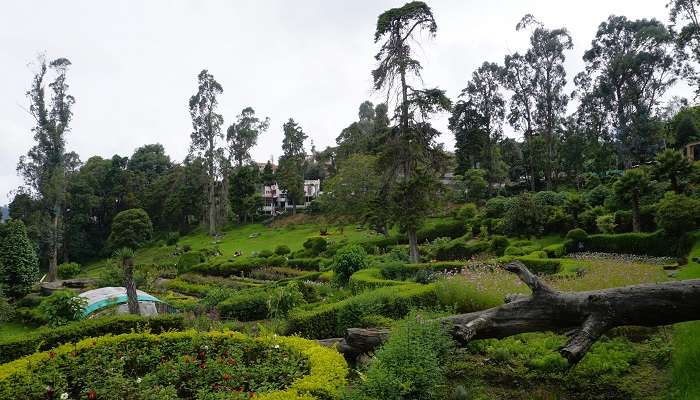
A Thorough Guide To Explore The Beauty Of Chettiar Park In 2024
Trending Blogs

20 Mysterious Places In India To Visit In 2024 More Bizarre Than The Bermuda Triangle

10 Scariest Roads In India That Are A Driver’s Nightmare

101 Places To Visit In India Before You Turn 30 in 2024

35 Exotic Places To Visit In December In India 2024 To Enjoy A Surreal Vacation

60 Best Honeymoon Destinations In India In 2024

95 Best Honeymoon Destinations In The World In 2023 For A Romantic Escape!
Best Places To Visit In India By Month
Best places to visit outside india by month.
- TravelTriangle
- Temples »
- Tour Packages
- Honeymoon Packages
- Family Packages
- Budget Tour Packages
- Luxury Tour Packages
- Adventure Tour Packages
- Group Tour Packages
- Kerala Tour Packages
- Goa Tour Packages
- Andaman Tour Packages
- Sikkim Tour Packages
- Himachal Tour Packages
- Uttarakhand Tour Packages
- Rajasthan Tour Packages
- Tour Packages From Delhi
- Tour Packages From Mumbai
- Tour Packages From Bangalore
- Tour Packages From Chennai
- Tour Packages From Kolkata
- Tour Packages From Hyderabad
- Tour Packages From Ahmedabad
- Kerala Tourism
- Goa Tourism
- Sikkim Tourism
- Andaman Tourism
- Himachal Tourism
- Uttarakhand Tourism
- Rajasthan Tourism
- Hotels in Kerala
- Hotels in Goa
- Hotels in Sikkim
- Hotels in Andaman
- Hotels in Himachal
- Hotels in Uttarakhand
- Hotels in Rajasthan
An ex-Wall Street banker who's visited every country shares 6 places where you can spend less and still travel in luxury
- Lee Abbamonte, 45, is an ex-Wall Street banker who has visited every country in the world.
- When it comes to destinations where dollars go the furthest, Southeast Asia is his go-to.
- In Bangkok, Abbamonte paid less than $50 a night for a Shangri-La hotel and loved the street food.

This summer is shaping up to be one of the hottest on record for the US economy .
Household wealth is at a record high, the job market is strong, and wages are rising faster than inflation. Meanwhile, the dollar has steadily gained against rival currencies. Simply put, Americans have dollars to spend. One question they might have: Where, oh where, to spend it?
Lee Abbamonte has some suggestions. Abbamonte, who quit his Wall Street finance job to become a travel blogger in 2002, has visited every country in the world, every US state , plus the South and North Poles.
Abbamonte's go-to for getting the most bang for your travel buck is Southeast Asia .
In countries like Thailand, Vietnam, and Cambodia, luxury hotels can cost under $100 a night and street food can be as delicious as fine dining, Abbamonte said.
One downside is that traveling to Southeast Asia from the US can take anywhere from 15 hours to more than a day.
"The hardest part is getting there," added Abbamonte, who last visited the region between 2017 and 2019. "But once you're there, you're in heaven."
Here, Abbamonte shares six countries — in Southeast Asia and beyond — where your vacation budget can buy some indulgent splurges.
During a past trip to Thailand, Abbamonte stayed in a five-star hotel for less than $50 a night.
Thailand is one of Abbamonte's favorite destinations in Southeast Asia, for good reason.
In Bangkok, he said, street food is world-class and high-quality yet inexpensive compared to comparable meals in the US. Abbamonte stayed at several stunning hotels along the Chao Phraya River, which flows through the heart of the city.
"I remember I paid like $39 for the Shangri-La," he said.
A one-night stay at the Shangri-La in Bangkok is a bit more expensive now, according to its website : $162 as of June 2024.
Outside Bangkok, Abbamonte can't get enough of Phuket, an island off the west coast of mainland Thailand brimming with rainforest and white sandy beaches that look straight out of a postcard.
"Some of the best hotels I've ever stayed at in my life are in Phuket," he said. His favorite is Kata Rocks, an oceanfront five-star hotel that is "one of the most beautiful places" Abbamonte has ever been.
"I don't remember exactly what it cost, but it wasn't that much," Abbamonte said, estimating that he spent "around $100" a night.
In July 2024, a one-night stay at Kata Rocks in Phuket costs more than $490 according to its website . That may not seem cheap, but villas in more expensive locations like the Caribbean can cost a lot more.
Vietnam is exceedingly affordable for its stunning vistas and delicious delicacies, he said.
Vietnam is one of Abbamonte's top countries in South Asia, where "the food is cheap and easy, and it's fantastic."
The country is home to some awe-inspiring natural wonders, including Ha Long Bay, which you can explore via luxury overnight cruises with amenities like pools, jacuzzis, and wine cellars from about $190 a night.
"Ha Long Bay, near Hanoi, is one of the most beautiful places in the world," Abbamonte said.
Tourists can also get great deals, he added, in the artsy and history-rich city of Hanoi, the coastal city of Da Nang, and Vietnam's southern capital, Ho Chi Minh City.
In Ho Chi Minh City, Abbamonte recommends stopping by the War Remnants Museum. Known locally as the American War Museum , an adult ticket costs 40 Vietnamese dong, or around $1.50.
Home to exhibits on the Vietnam War and the First Indochina War, Abbamonte said it's his "favorite" museum outside the US.
Money goes a long way in Cambodia, home to a world-class beach scene that relatively few know about.
Another one of Abbamonte's favorite places to splurge without spending too much is Cambodia.
Sandwiched between Thailand and Vietnam, the country is affordable in all the ways that its neighbors are but is more off the beaten path.
"There aren't the tourists you get in Thailand and Vietnam," Abbamonte said.
Most tourists visit Cambodia to see Angkor Wat, an ancient Hindu-Buddhist temple complex near the city of Siem Reap. Abbamonte said the temple, which costs $37 to visit for a day, is worth seeing, but added that the country has so much more to offer.
"There's a lot more going on outside Angkor Wat," he said. "They have nice beaches, and they've really improved their infrastructure."
Some of the most idyllic seaside spots are situated on the tiny islands off of the coastal city of Sihanoukville, like Saracen Bay, a beach on Koh Rong Samloem.
Argentina has some amazing steakhouses that are generally more affordable than their US counterparts.
Abbamonte said many Americans sleep on Argentina, but that it's one of the most affordable, exciting, and pleasant places to visit in South America.
He's particularly fond of Patagonia, a region of mountains, glacial lakes, grasslands, and rainforests that runs through both Argentina and Chile across the southernmost tip of South America.
It's as close to paradise as it gets for Abbamonte, who loves being outdoors — and it doesn't hurt that food and accommodation are inexpensive.
"You can go down there and live it up real cheaply," he added.
The capital of Buenos Aires is also a must-see, Abbamonte added, because it's home to an array of luxury hotels and high-quality steakhouses where American dollars go a long way.
One of his favorite eateries is La Cabrera, a steakhouse in the trendy Palermo Soho neighborhood of Buenos Aires that offers a daily 40% happy hour discount on food and drinks between 6:30 p.m. and 8 p.m. (One blogger who reviewed their La Cabrera meal during a 2023 trip said, at the time, a 21-ounce ribeye cost the equivalent of $45.)
"I'm a meat eater," Abbamonte admitted. "So if you like steak, there's really nowhere better."
Ethiopia offers affordable safari options in awe-inspiring wildlife reserves.
"Ethiopia is one place that I love," Abbamonte said. "It's definitely in my top five African countries."
In the past, he's flown into the capital city of Addis Ababa and stayed in five-star hotels for $100 a night. "They're really, really nice, and you can eat world-class meals for virtually nothing," he added.
While booking safari-type vacations can be "pretty expensive," Abbamonte said more adventurous travelers can always consider camping, which he did during his first trips 20 years ago.
At the time, he said, buying supplies, organizing transport within the park, and getting camping permits cost him between $100 and $200.
For example, foreign tourists visiting the Simien Mountains National Park pay 90 birrs, or around $1.50, for a 24-hour pass and an additional 40 birrs, less than $1, to camp in a tent with up to four people.
Compared to some luxury lodges, it's incredibly affordable, and "you get all the same animals," Abbamonte said, adding that he felt completely safe, given all the park rangers roaming around.
Abbamonte said there's never been a better time to visit Japan, one of his favorite countries in the world.
Japan isn't typically the first country that comes to mind for affordable travel, but Abbamonte said it's never been a better time to book a trip because, as of June 25, $1 buys 159.72 yen.
It's one of the best conversion rates in recent history.
"It's as cheap as it's ever been for the American dollar right now," Abbamonte said. "In Tokyo, the hotels are slashed to a third less than they normally are."
For example, at the Hilton Tokyo, a five-star hotel in the bustling Shinjuku district, one-night stays start at under $300 a night, according to its website .
Abbamonte said Japan is worth the trek — and the steeper prices compared to Southeast Asia — for the unique experiences it offers.
From the Kobe beef in Kobe and the bustling streets of Tokyo to the omakase scene in Osaka and the tranquility and history of Kyoto, there's "nowhere" in Japan Abbamonte doesn't like.
"It's probably the best country in the world," he said.
- Main content

IMAGES
VIDEO
COMMENTS
Learn everything you need to know about visiting Angkor Wat, the iconic temple complex in Cambodia. Find out the best time, dress code, sights and tours to explore this ancient wonder.
Learn about the history, architecture and symbolism of Angkor Wat, the largest religious building in the world and the heart of Cambodia. Find out how to plan your visit, what to see and do, and how to get there from Siem Reap.
Learn how to plan your visit to Angkor Wat, the largest religious structure on Earth and the symbol of Cambodia. Find out what to see, where to stay, when to go, and how to avoid the crowds in this comprehensive guide.
Learn how to plan a successful trip to Angkor Wat, the largest and most famous temple in the Angkor Archaeological Park. Find out the history, entrance fee, best time to visit, and how to get around by tour van, tuk-tuk, or bicycle.
Learn about the history, architecture, and art of Angkor Wat, the most famous temple in Cambodia and a World Heritage site. Find out how to get there, when to visit, and what to see in this stunning stone city.
Learn everything you need to know before visiting Angkor Wat, the world's largest religious monument and a UNESCO World Heritage Site. Find out about its history, tickets, etiquette, itineraries, and more in this comprehensive guide.
3. Bring lots of water. It can get very hot and humid, especially from April through May, and you'll want to stay hydrated during all of the walking and trekking. 4. Get there early. The best time to visit is before sunrise, which means you should aim to be there around 5 a.m.
Angkor Wat Temple & Srah Srang: Daily from 5 am - 5:30 pm (open for sunrise) Phnom Bakheng & Pre Rup Temples: Daily from 5 am - 7 pm (open for sunrise and sunset) All other temples: Daily from 7:30 am - 5:30 pm. (Except for Phnom Kulen and Beng Mealea. you will need to buy an extra ticket to visit these.)
Angkor Wat. Cambodia, Asia. The traveller's first glimpse of Angkor Wat, the ultimate expression of Khmer genius, is matched by only a few select spots on earth. Built by Suryavarman II (r 1112-52) and surrounded by a vast moat, the temple is one of the most inspired monuments ever conceived by the human mind.
Angkor Wat is the iconic travel destination in Cambodia, renowned for its rich history and incredible architecture, attracting travellers and photographers from around the world. This article provides essential Angkor Wat guide for your smooth and enjoyable visit to Angkor Wat Cambodia (Angkor Archaeological Park), covering topics such as dress code, clothing suggestions for stunning photos ...
Angkor Wat Suggested Budgets. On a backpacking budget, you can expect to pay $60 USD per day to visit Angkor Wat. On this budget, you're staying in a hostel dorm, eating cheap street food, limiting your drinking, and using a bike to get around the complex. This also includes a day entry to the Angkor Wat site.
aerial view of angkor wat, cambodia. The best time of the year to visit Angkor Wat is during the dry season when there is the least rainfall and the temperatures are mild. The dry season runs between December and March, but it's important to note that the park is busiest around this time of the year. May to October is the rainy season and it ...
Learn when to plan your trip to Angkor Wat, the ancient temple complex in Cambodia, based on weather, crowds, and events. Find out the pros and cons of visiting during the dry season, monsoon season, and shoulder months.
The area that you'll visit at Angkor, the complex of Angkor Wat is the largest religious monument in the world. The city was the capital city of the Khmer Empire, which ruled from the 9 th to the 15 th century. At its peak, the ancient city used to be home to more than a million people.
Entrance Fees. The entrance fee to the Angkor Archaeological Park depends on the type of admission pass that you choose. There are 3 types of passes available: 1-day pass - US$ 37; 3-day pass - US$ 62; 7-day pass - US$ 72; The 3-day pass is valid for 10 days from the issue date, the 7-day pass is valid for 1 month from the issue date.
Angkor Wat was built by the Khmer king, Suryavarman II, in the first half of the 12th century- which makes most of its buildings a whopping 900 years old. Originally used as a Hindu temple and dedicated to the gods Shiva, Brahma, and Vishnu, it gradually evolved into a Buddhist temple, just 50 years after its completion- and is still used for ...
3 days in Angkor Wat is a great amount of time to explore this incredible UNESCO World Heritage site at a comfortable pace. Our 3-day Angkor Wat itinerary is not designed for seeing as much as you possibly can; it's designed for exploring at a pace that most of us would find enjoyable. With over 1000 temples within the Angkor Wat complex, trying to see it all would be an impossible 3-day task.
On day 1, start with Angkor Wat and its nearby sites, returning to Angkor Wat for sunset. On day 2, head for the jungle temples , then see the sunset on the top temple mountain of Pre Rup. On day 3, see Roluos for some of the earliest Khmer buildings. The following guide may help you develop your plans for visiting Angkor Wat. When to Visit
2.0K. The Angkor Archeological Park is a large temple complex located north of Siem Reap in the town of Angkor. "Angkor" translates to "city" and "Wat" to "temple". And Angkor Wat is the most popular temple in the entire complex. It's the highlight of any trip to Cambodia, one of the most important archaeological sites in all ...
Learn everything you need to know about visiting Angkor Wat, the largest religious monument in the world and the centerpiece of Angkor Archeological Park. Find out how to get there, where to stay, what to see, when to go, and more in this comprehensive guide.
Angkor Wat and Srah Srang open at 5:30 am so that you can see the sunrise. Phnom Bakheng and Pre Rip which are open from 5:00 am to 7:00 pm for sunrise and sunset. The ticket office is open from 4:30 am to 5:30 pm. Best time to visit Angkor Wat. Cambodia only knows two seasons - the dry and the rainy season.
The cost of a one-day pass is $37, a three-day pass is $62, and a seven-day pass is $72. The three-day and seven-day passes are good to go for it. You can pay in US dollars or by credit card. 2. Respect the Dress Code. Even if the weather is hot and humid, Angkor Wat is still a holy place, therefore dress respectfully!
Getting there. Several airlines fly directly to Siem Reap in Cambodia and many nationalities can get a 30-day tourist visa upon arrival for $30. Visitors can hire a local guide to explore the ...
Welcome to Siem Reap Angkor Cambodia 4 days is good enough for exploring all the temples around Angkor complex and the further temples such as: Day1: Pre Rip Banteay Srie East Mebon Ta Som Neak Pean Preah Khan Day2: Angkor Wat sunrise Banteay Kdie Ta Prohm ( temple with the big trees )
W hile not actually listed as one of the Seven Wonders of the World, Angkor Wat in Siem Reap, Cambodia, must surely be the eighth. Set across 402 acres of land, this sprawling temple complex holds ...
Image Credit: Travel to Cambodia for Facebook. The Angkor Wat Vishnu Temple is a sacred and religious place for the local people, and certain rules and regulations must be followed so that people from all regions and religions can enjoy their visit. All tourists must strictly follow the dress code: Their elbows and shoulders must be covered.
Most tourists visit Cambodia to see Angkor Wat, an ancient Hindu-Buddhist temple complex near the city of Siem Reap. Abbamonte said the temple, which costs $37 to visit for a day, is worth seeing ...